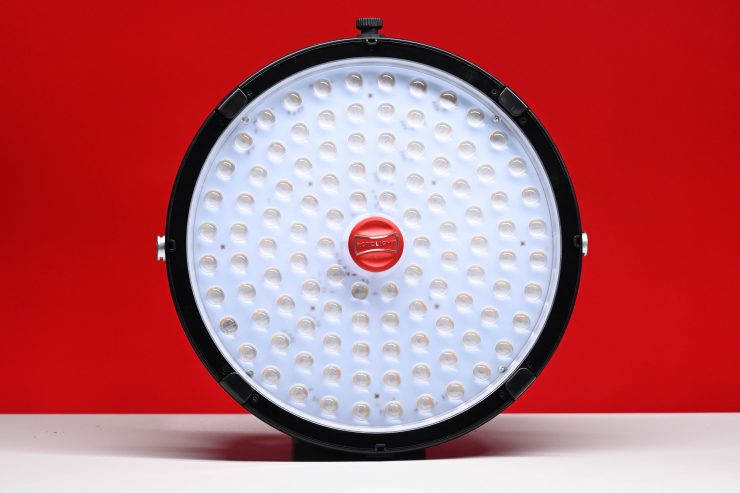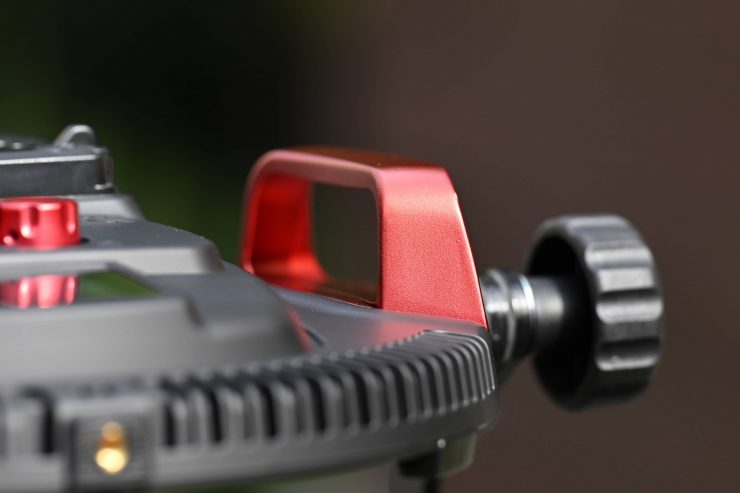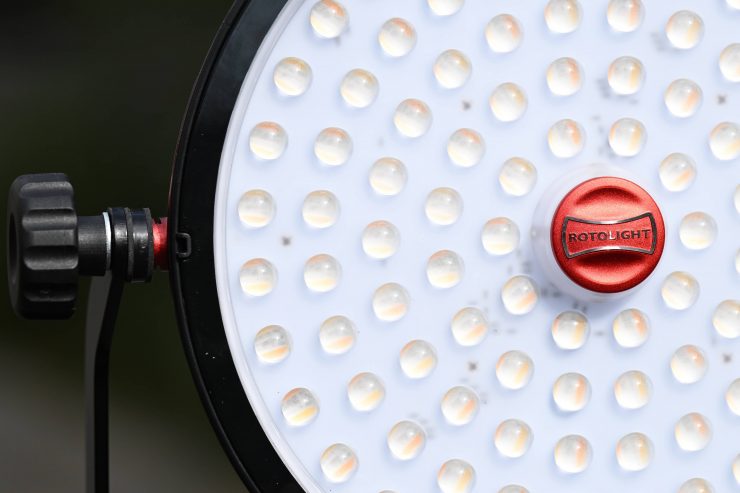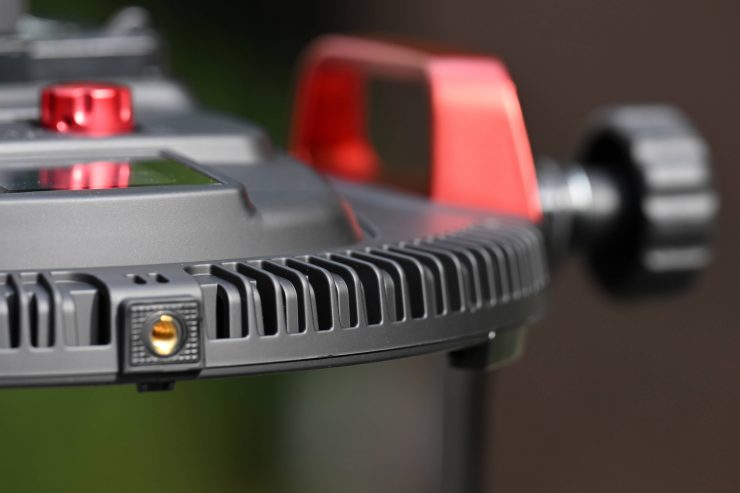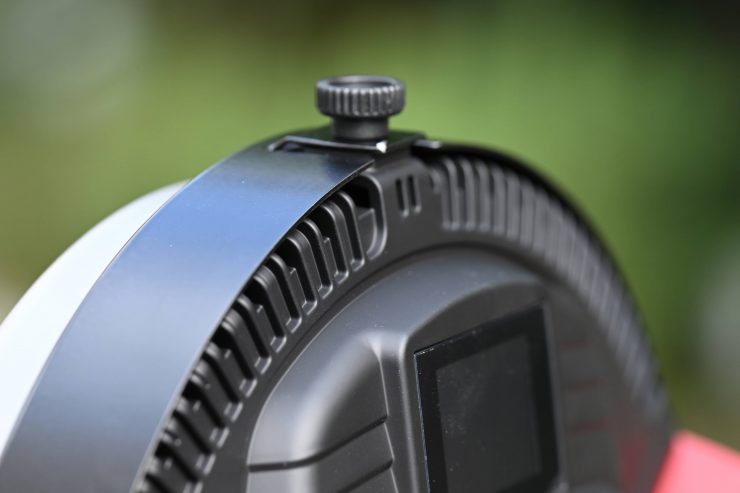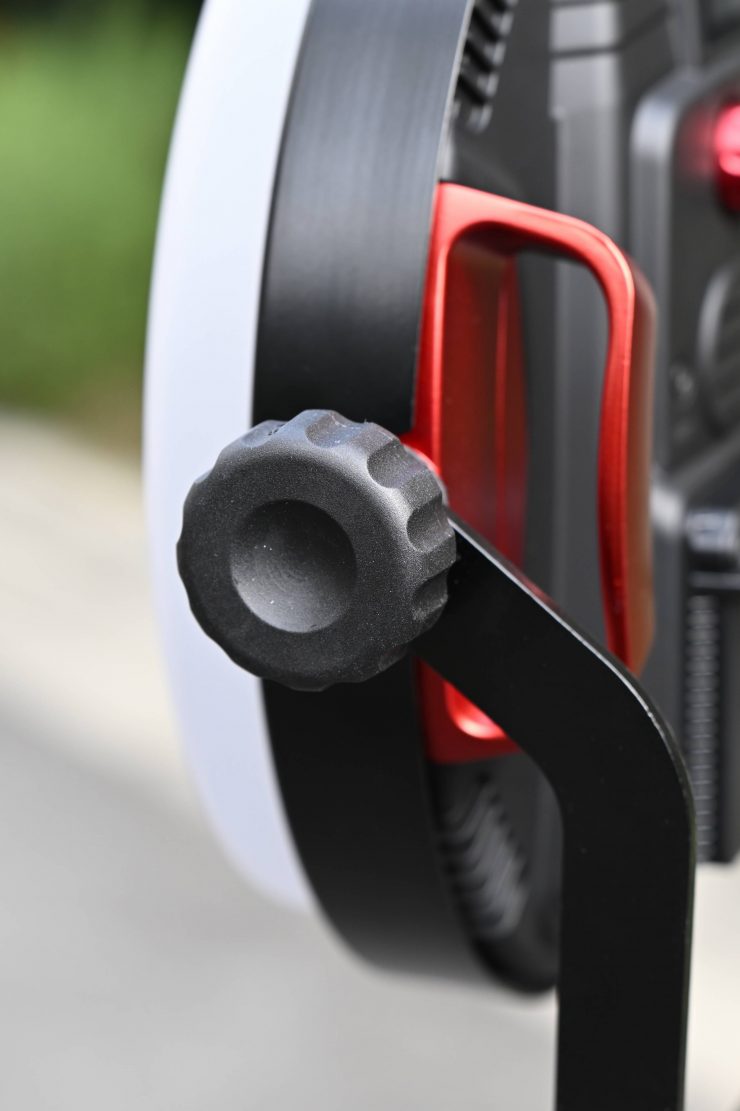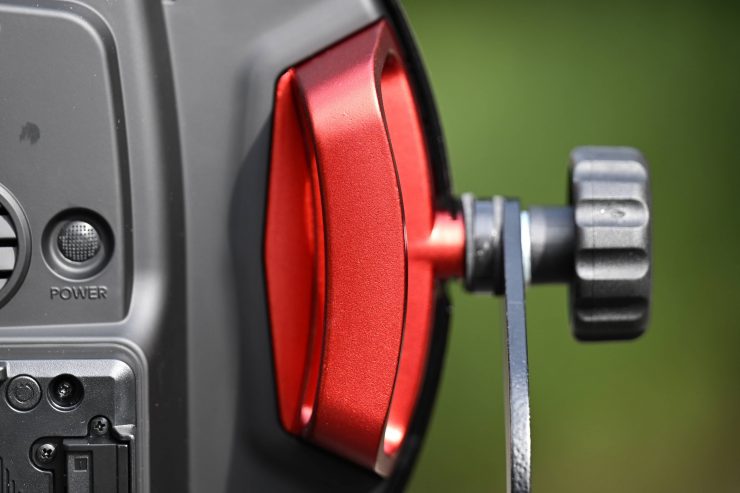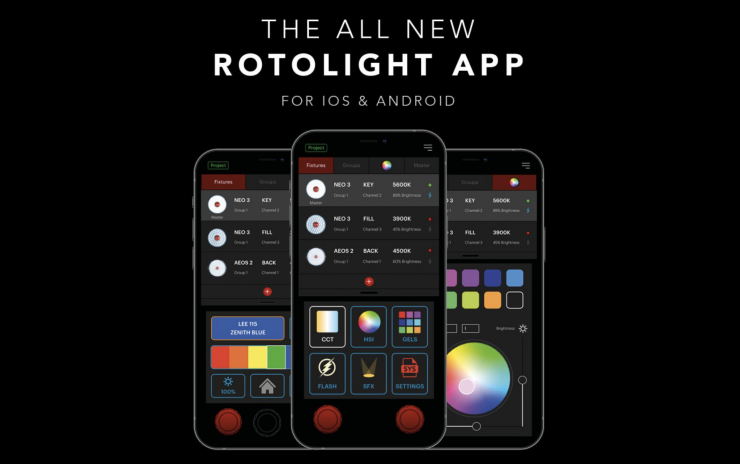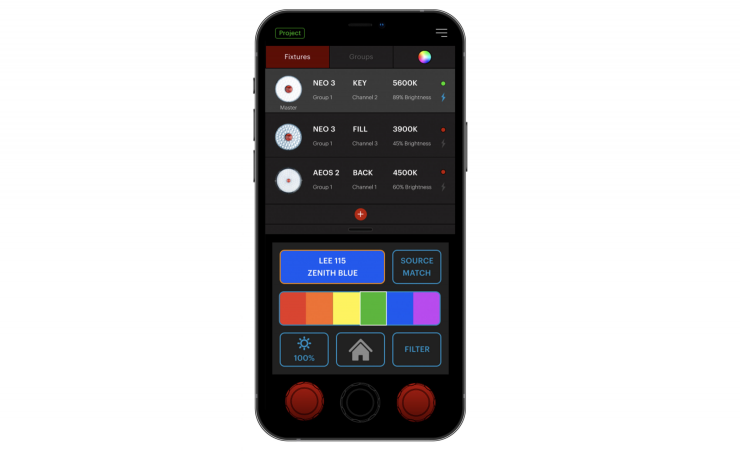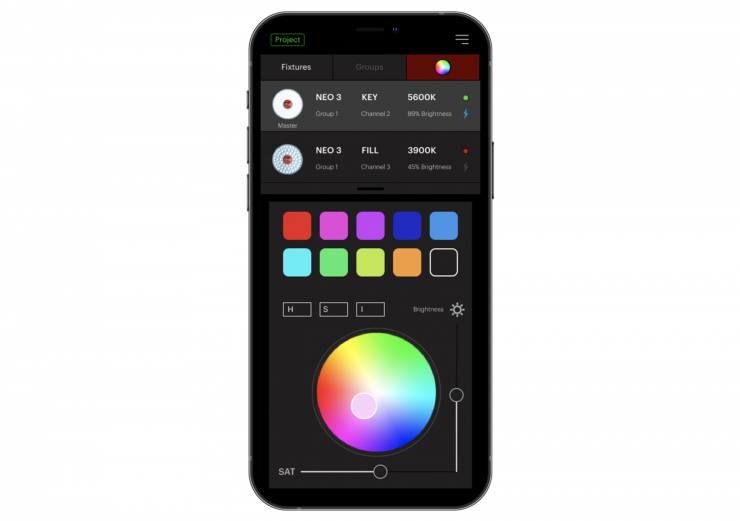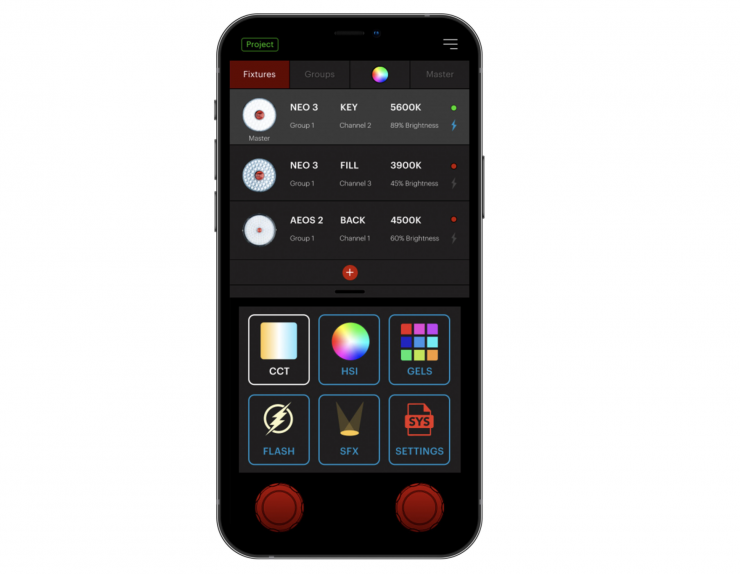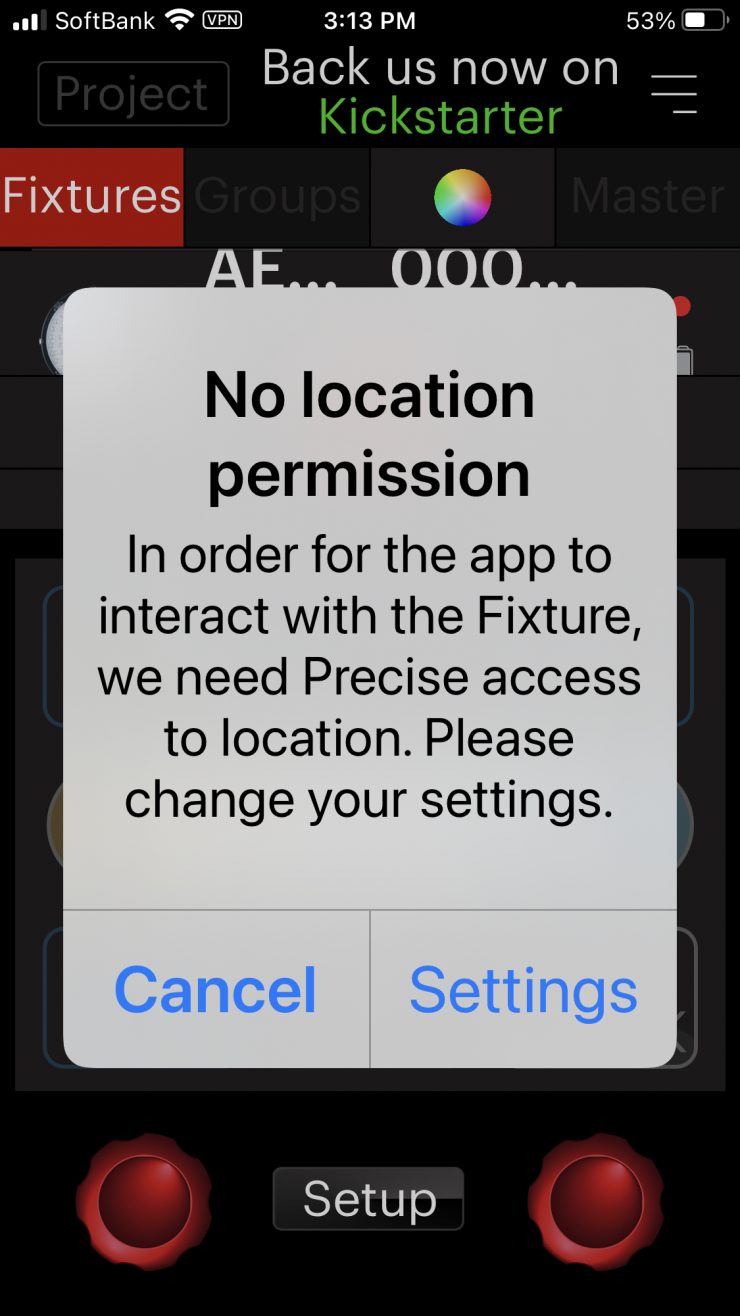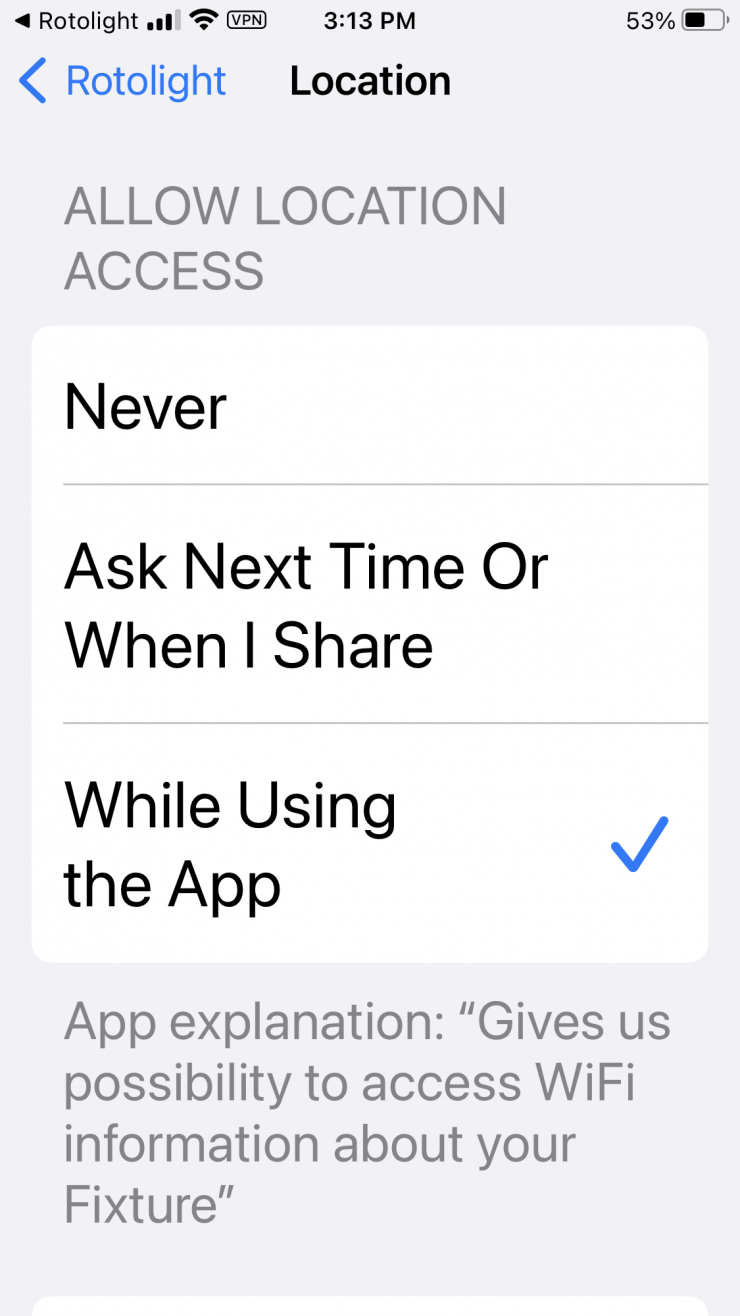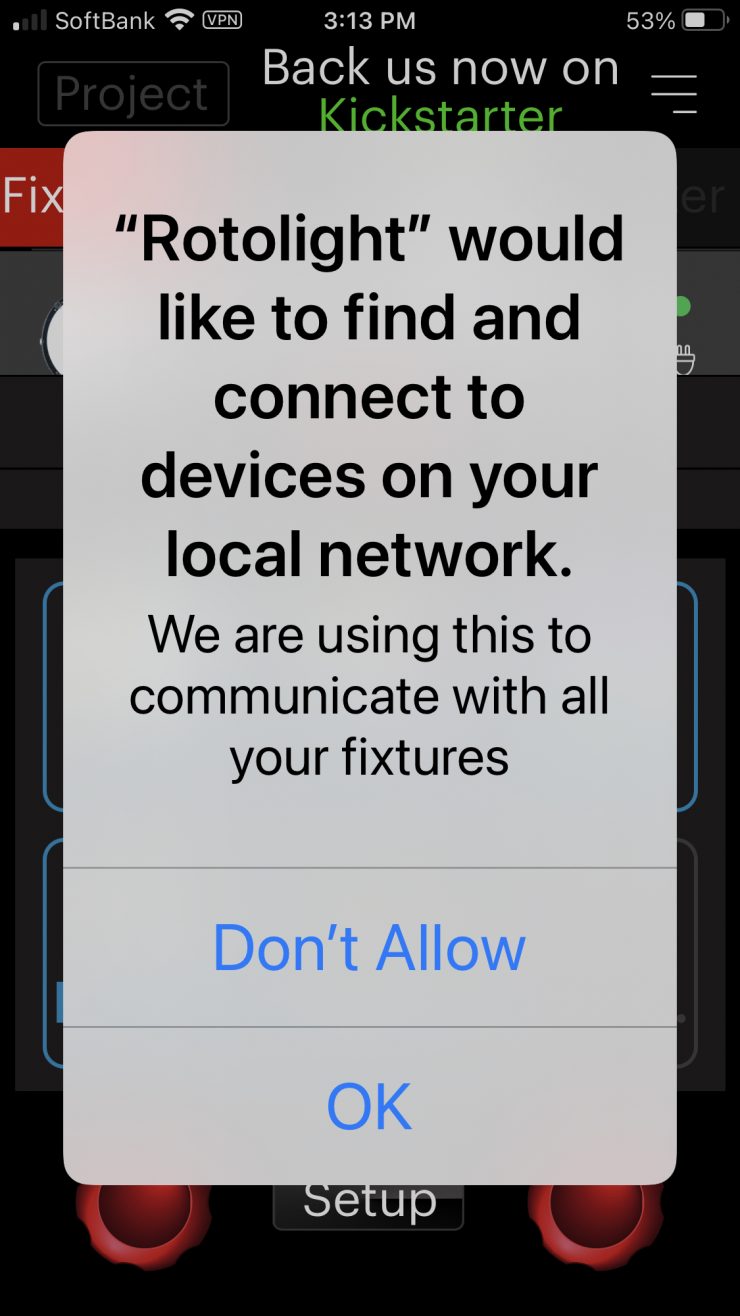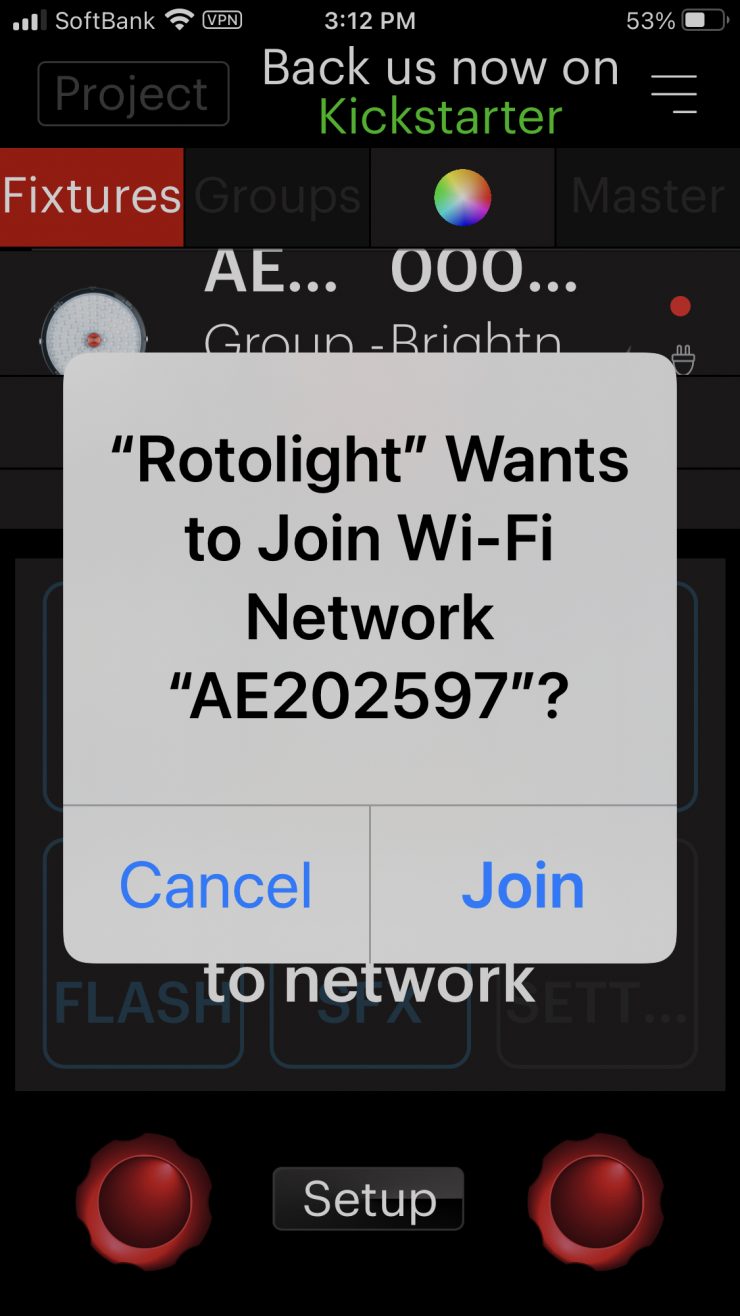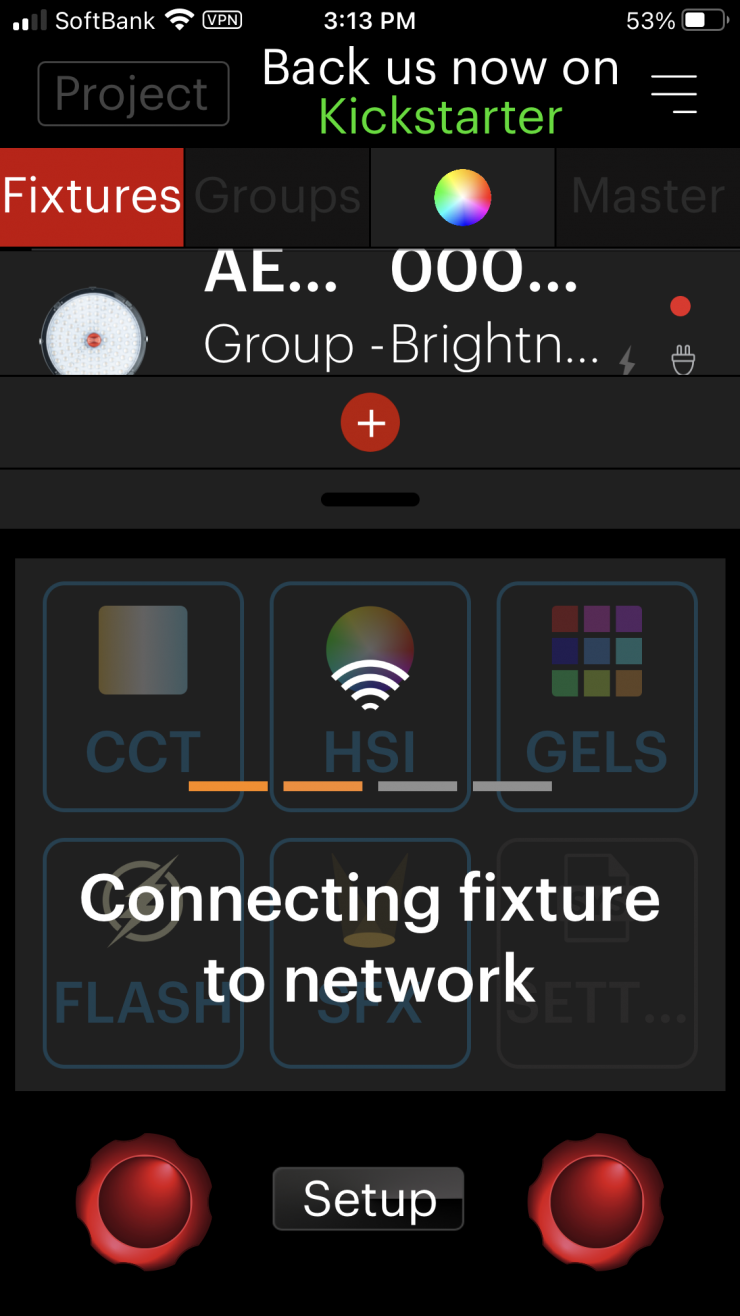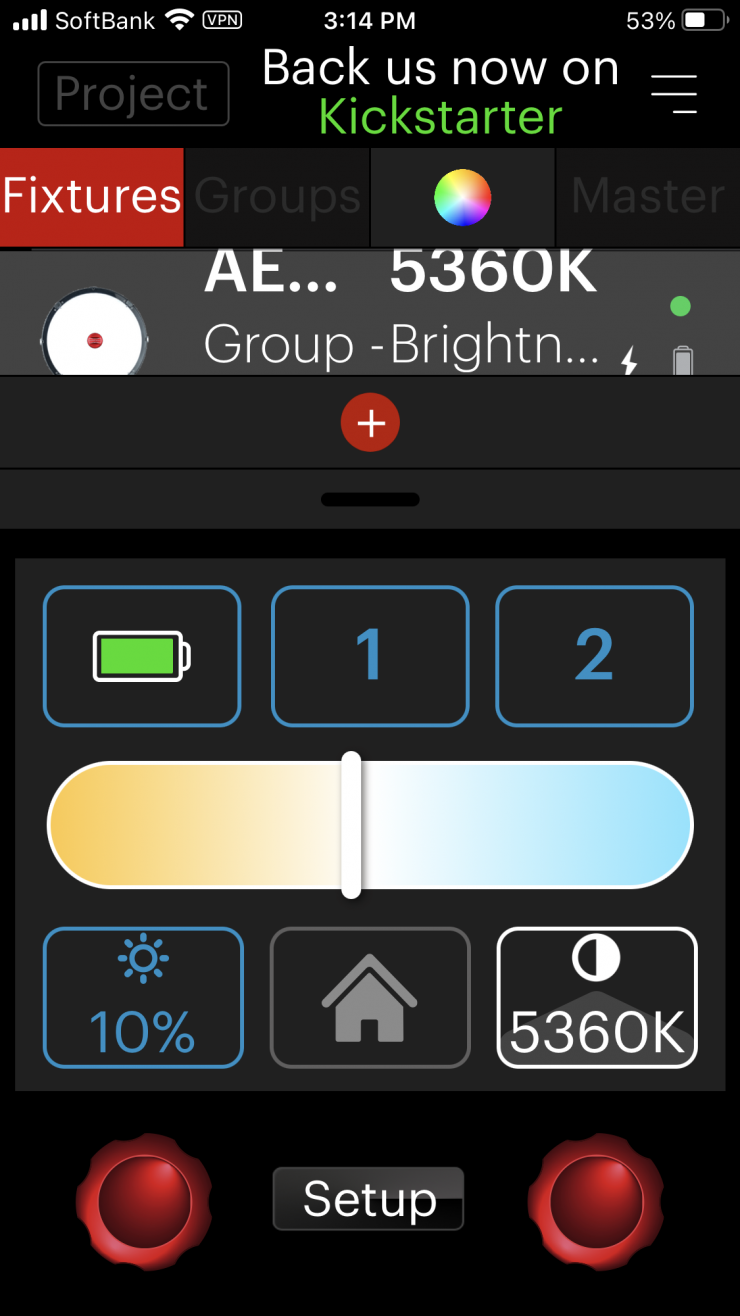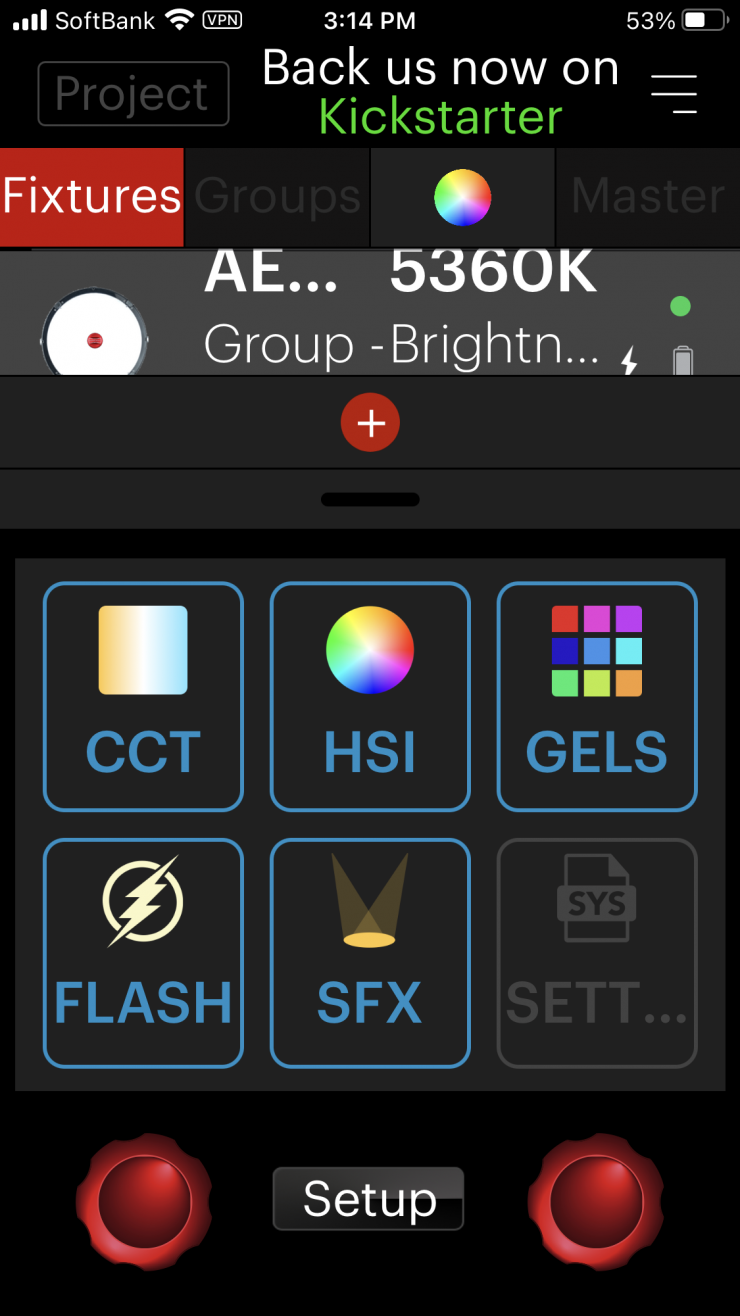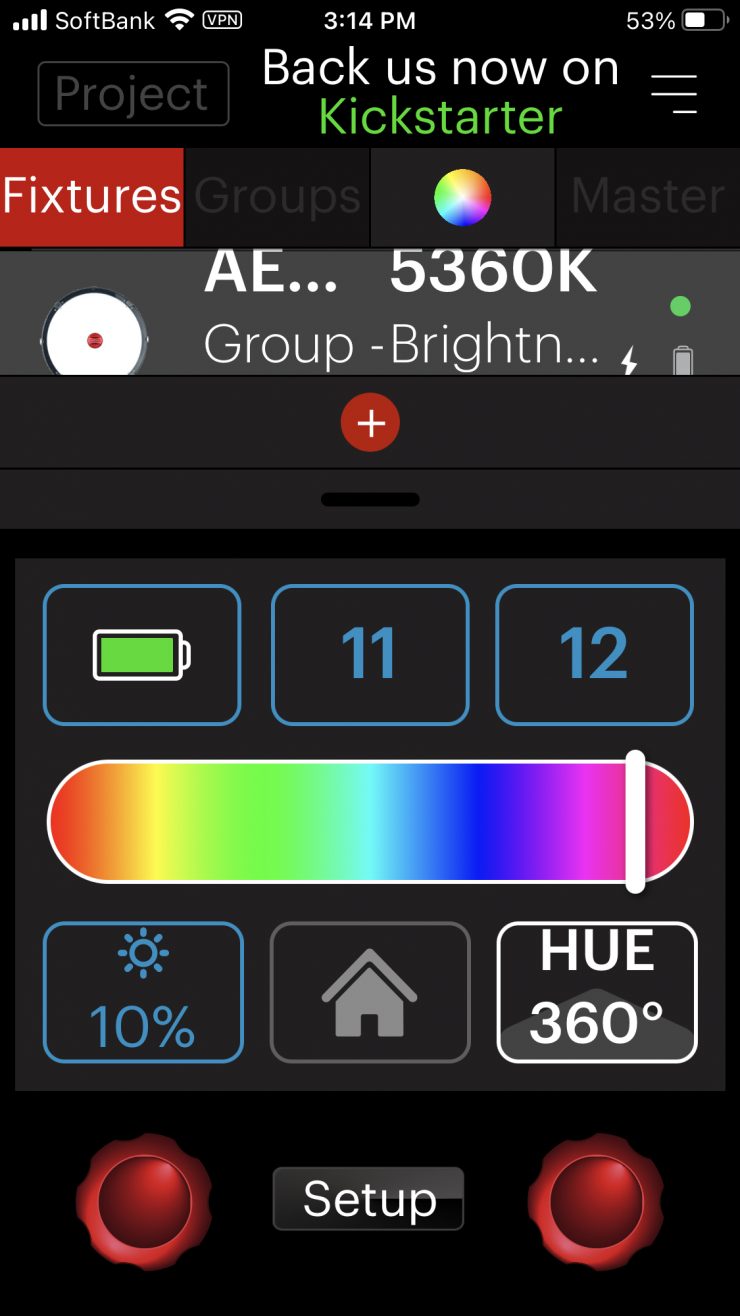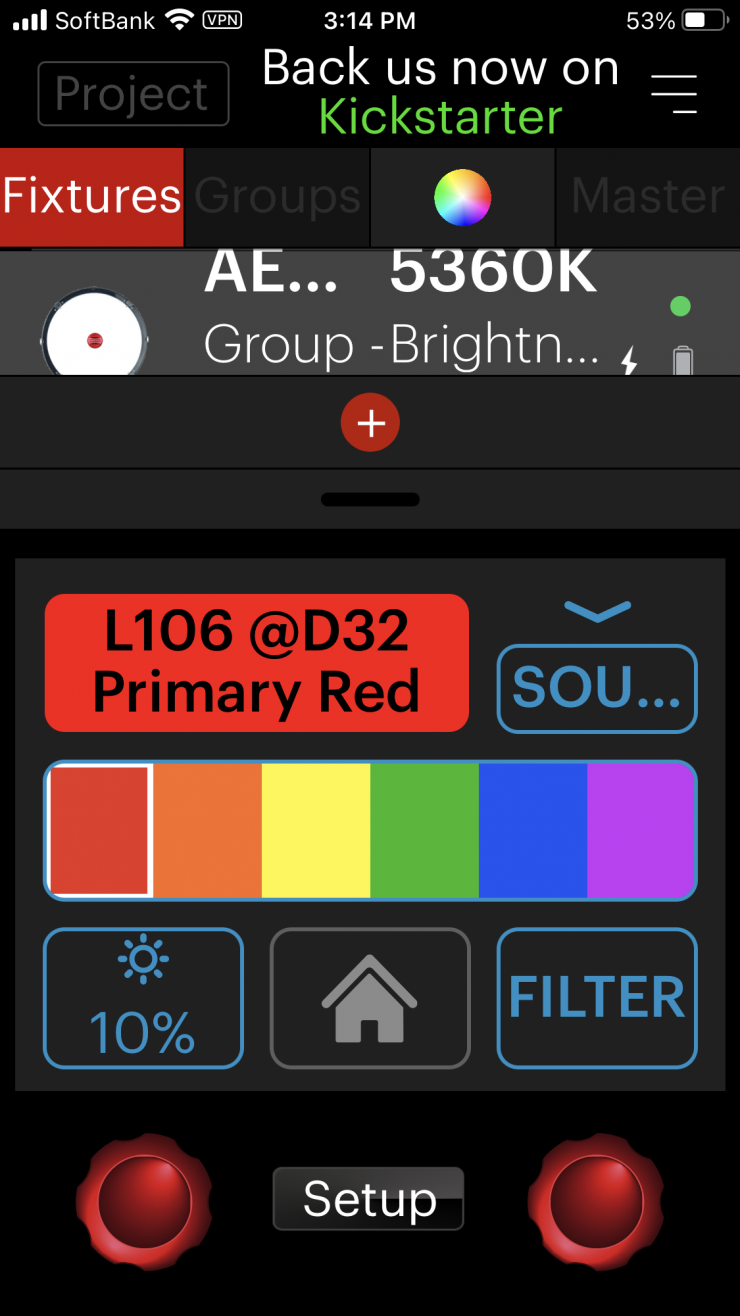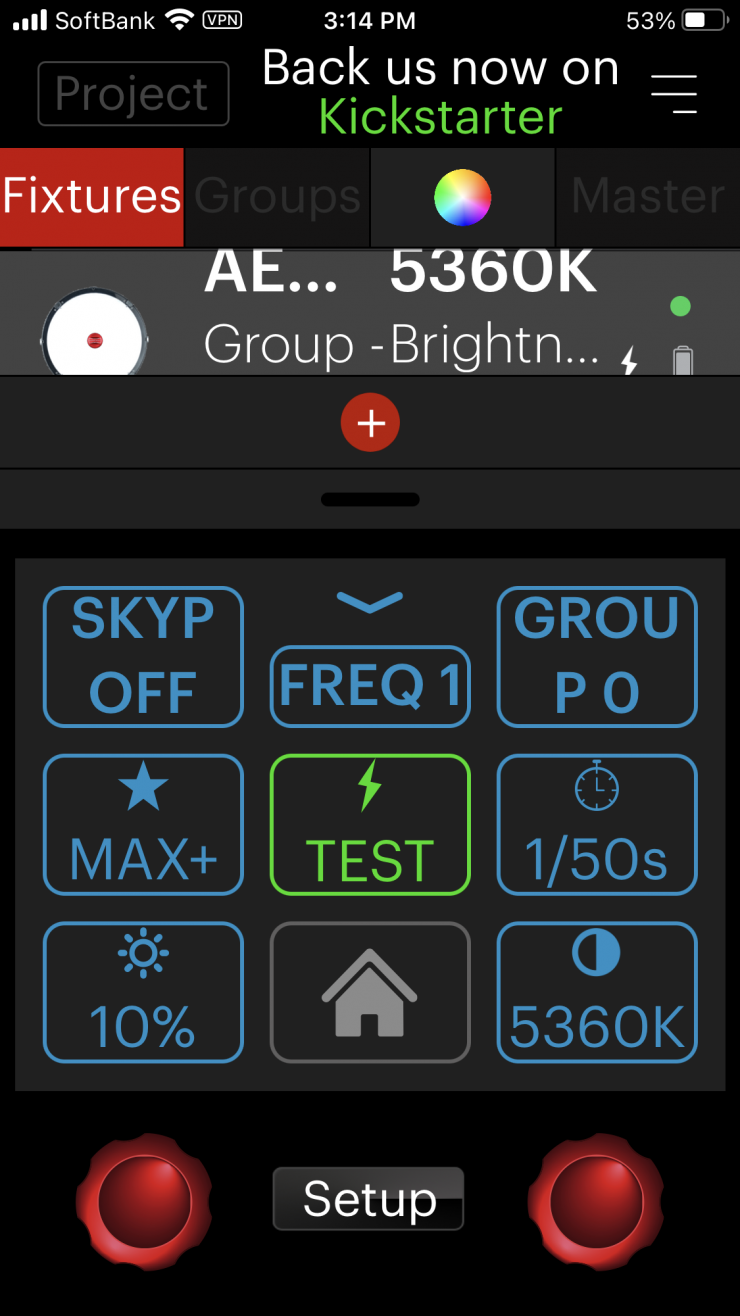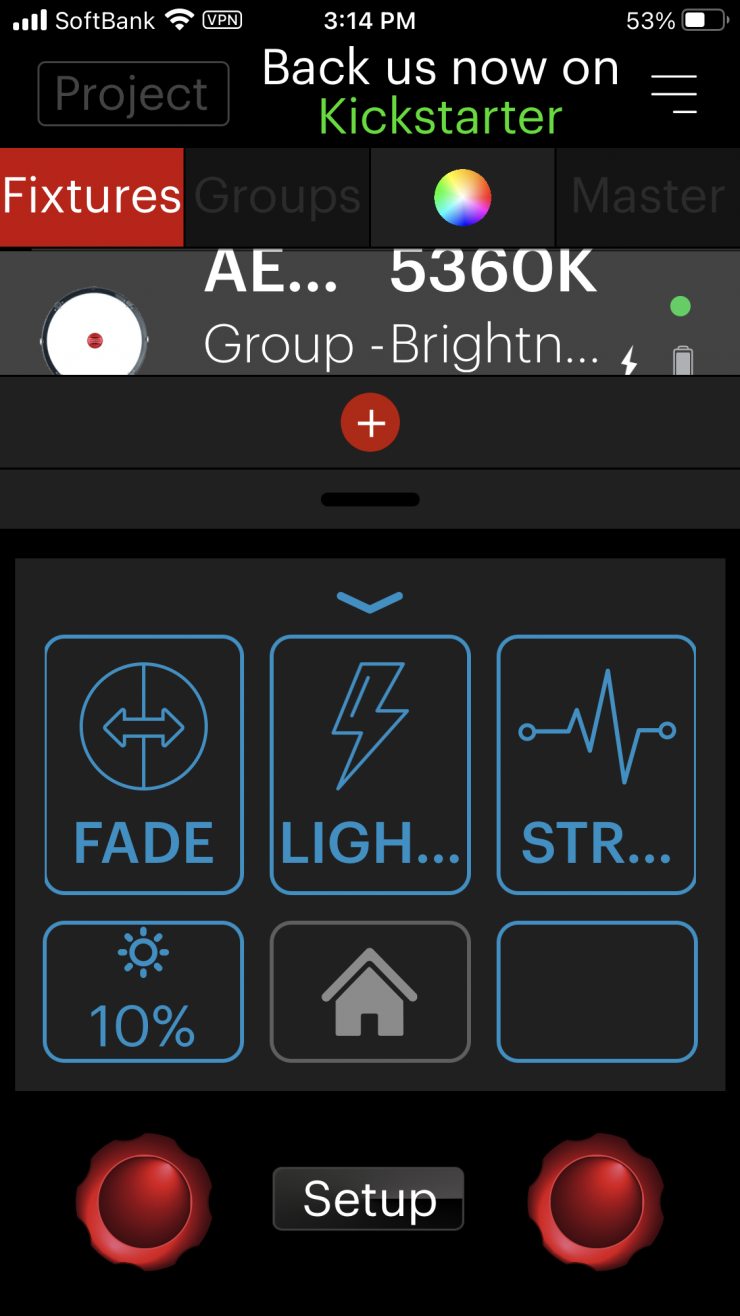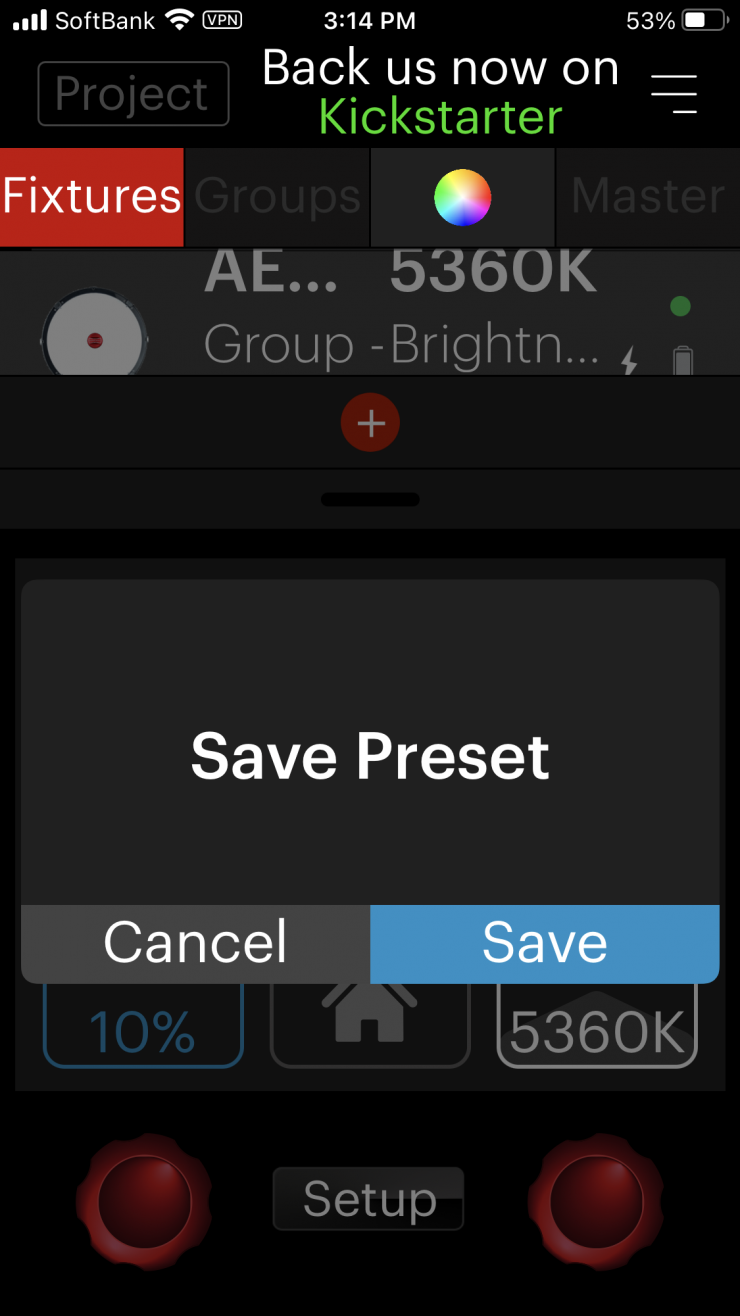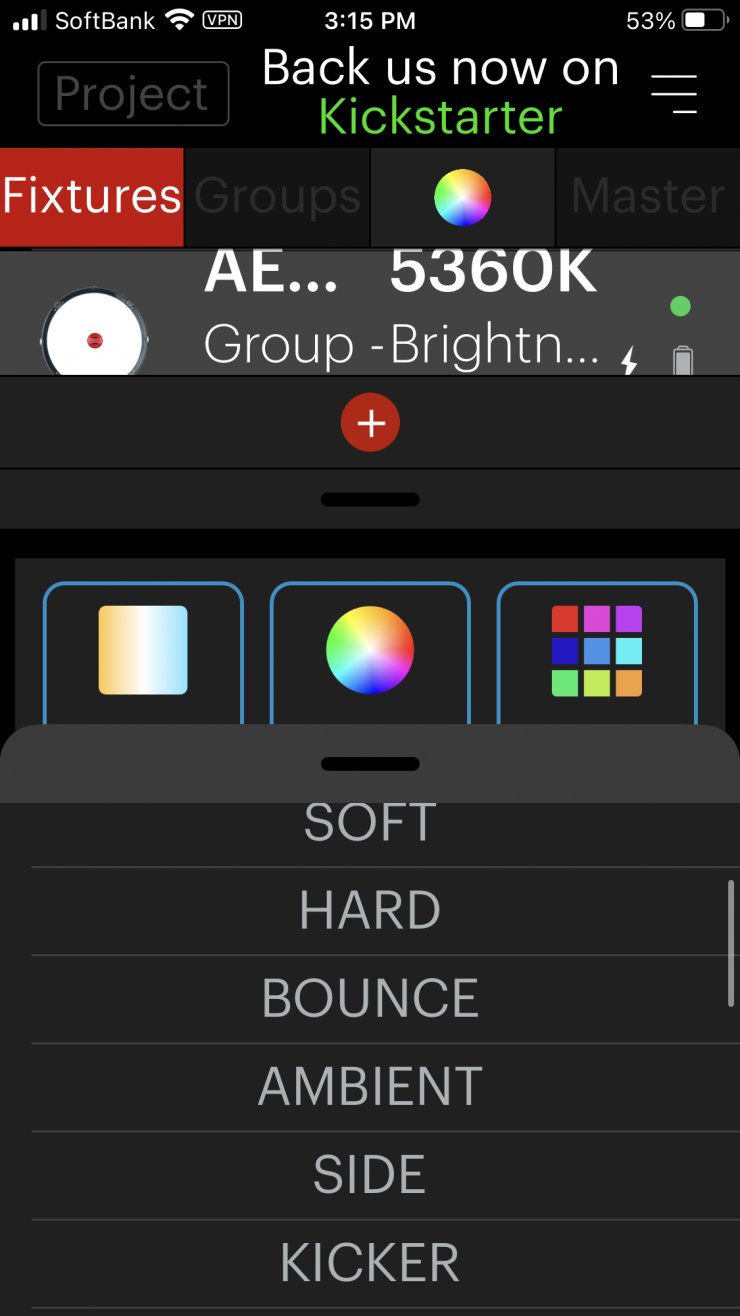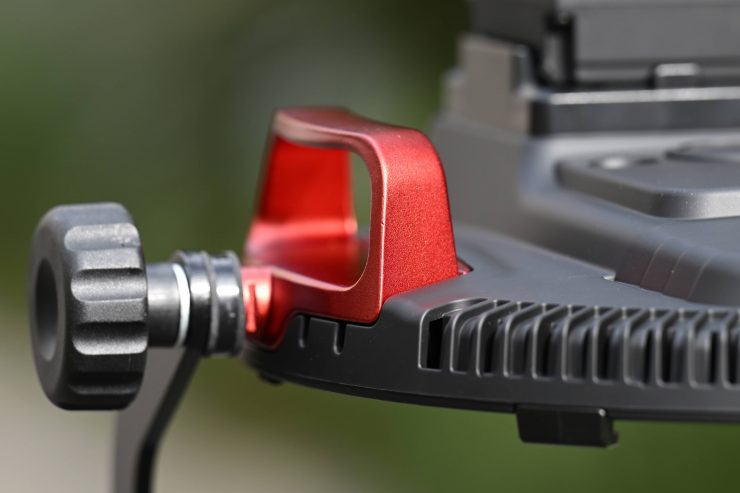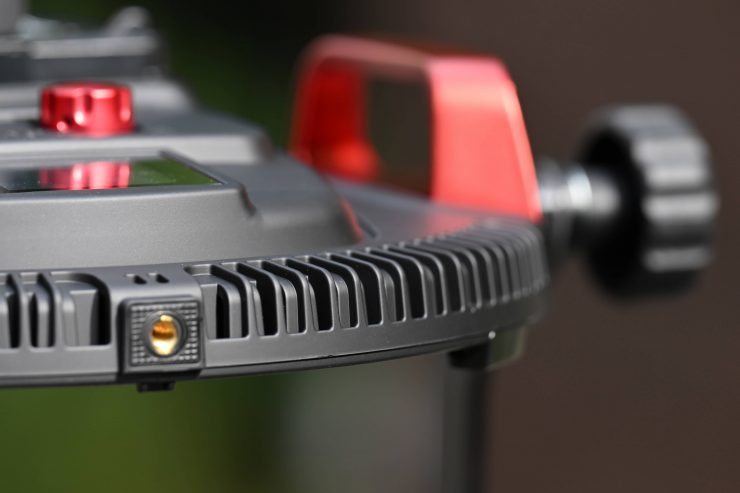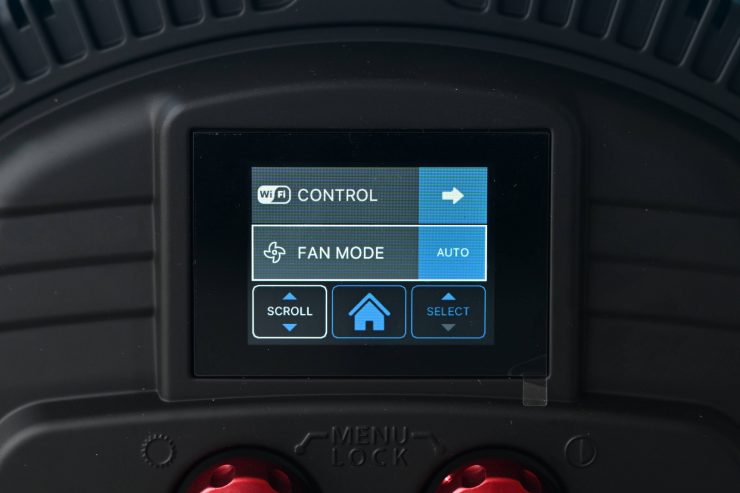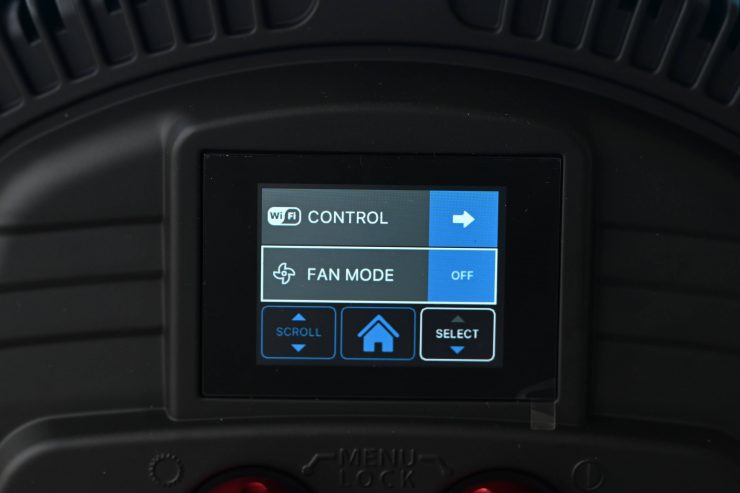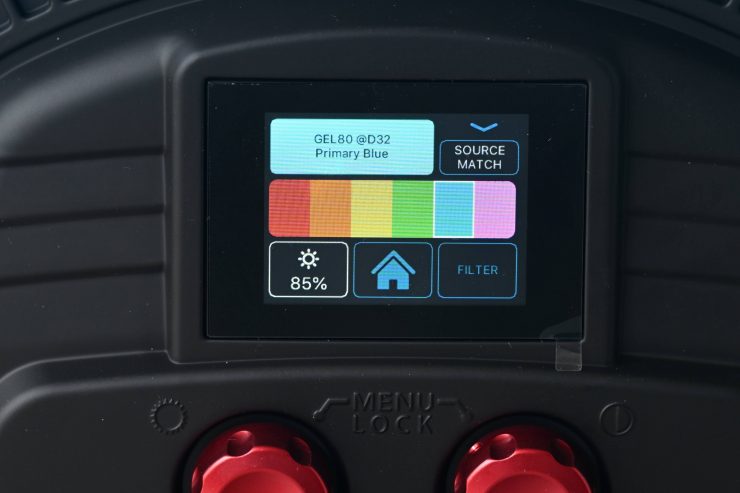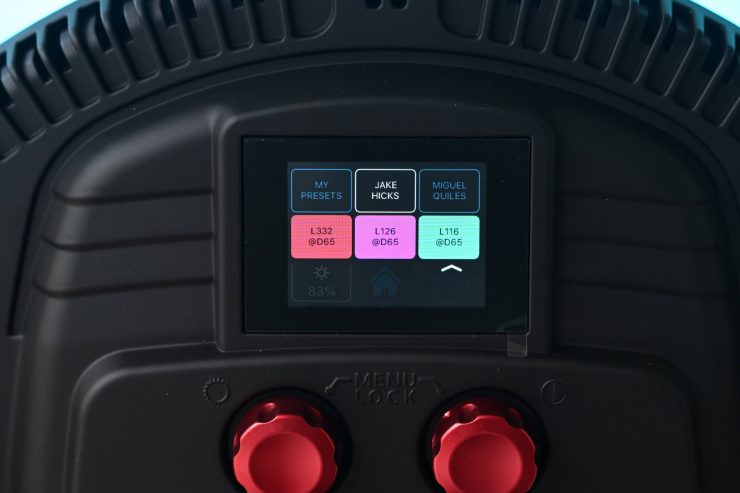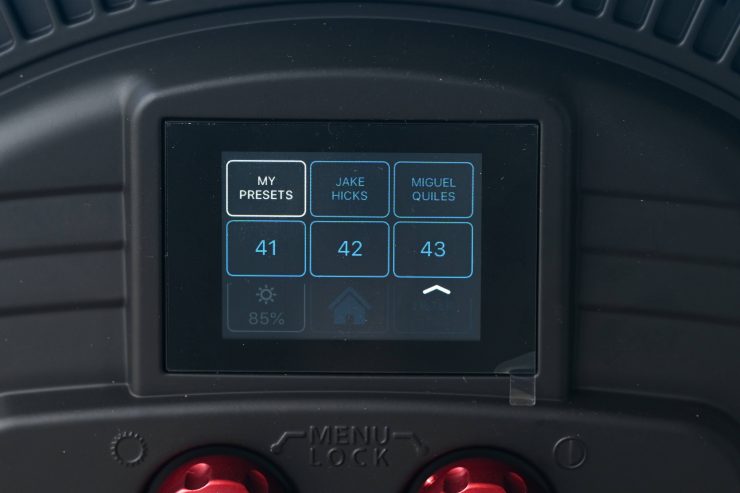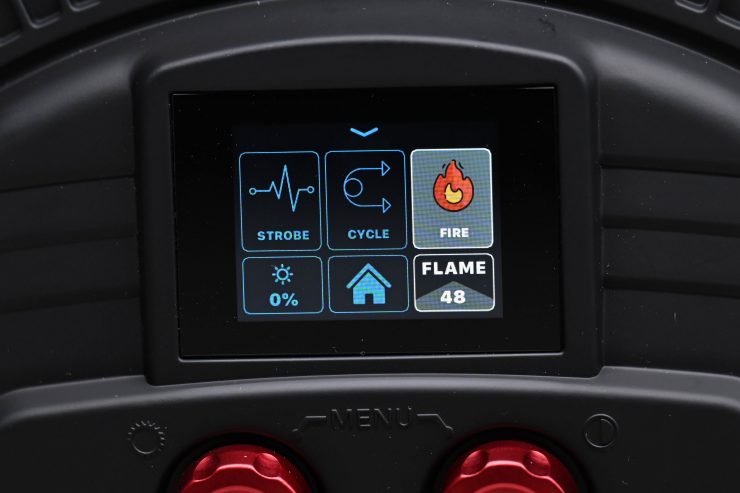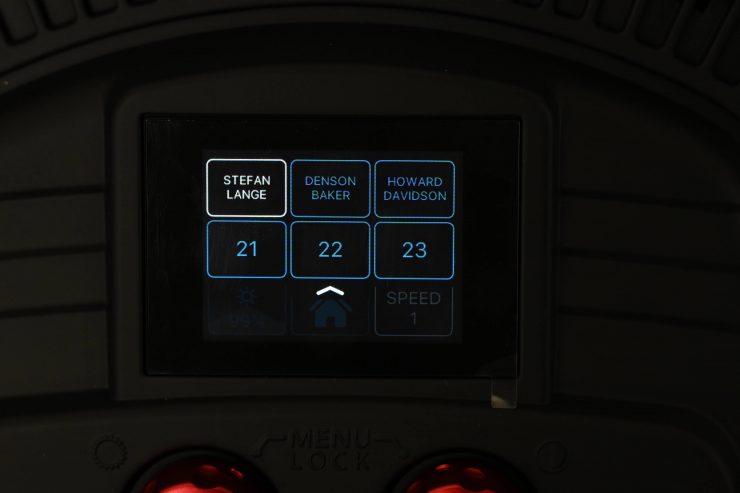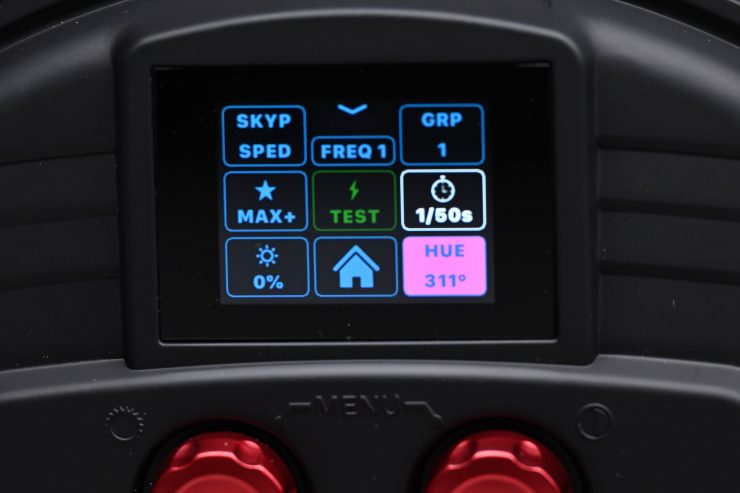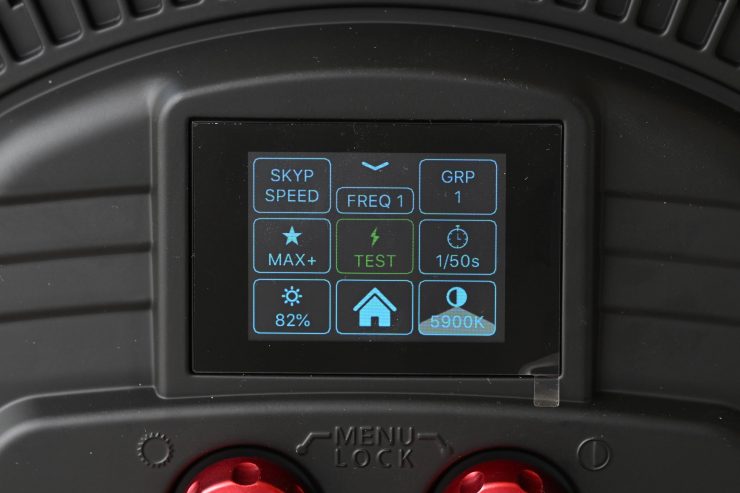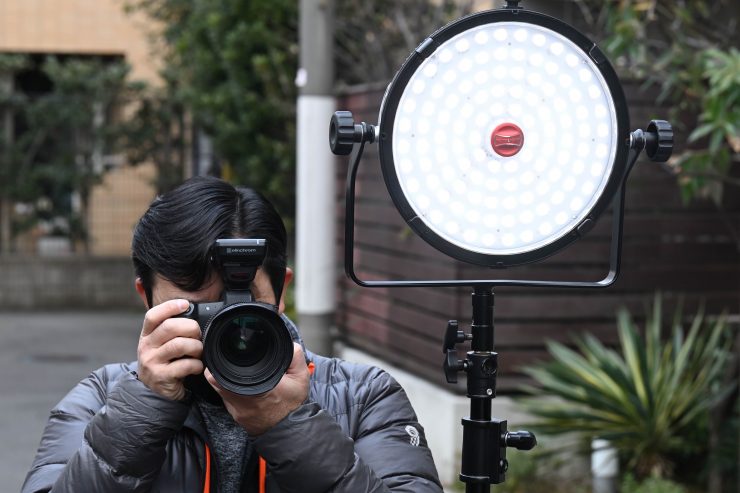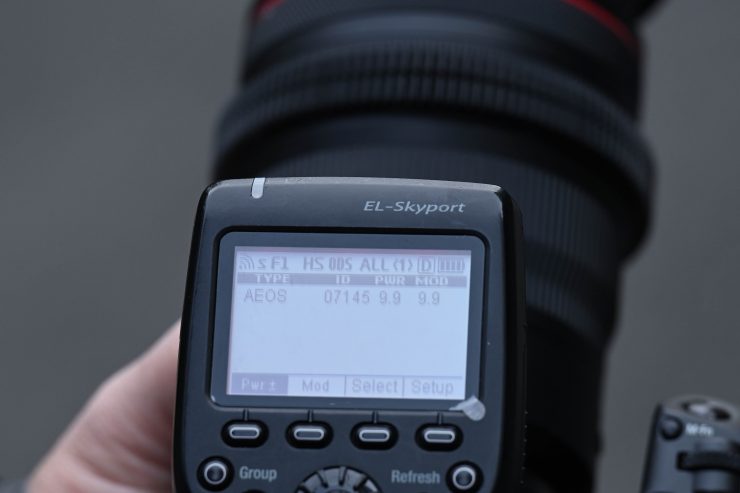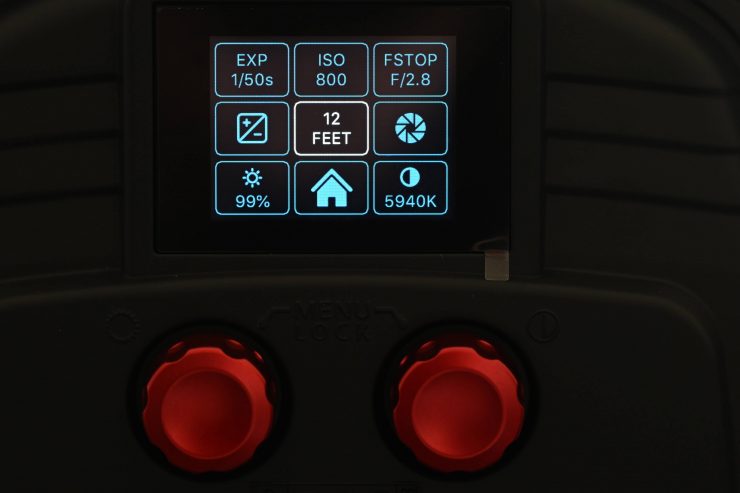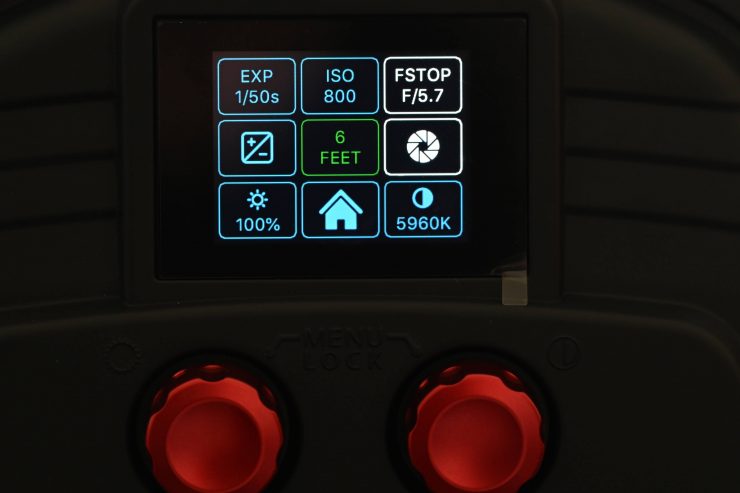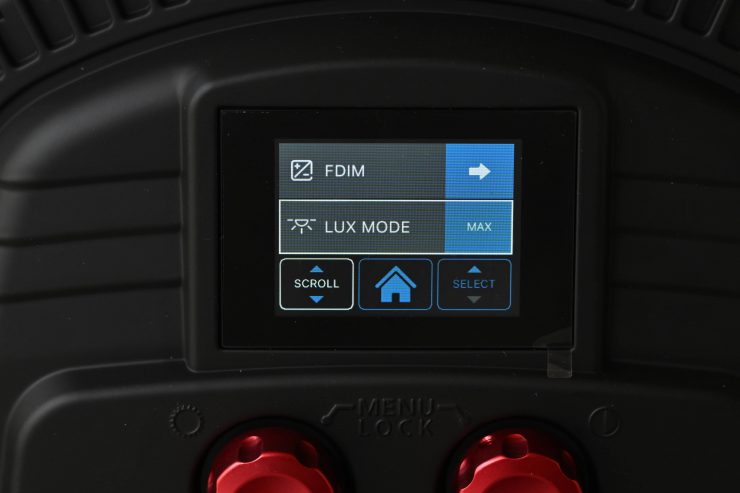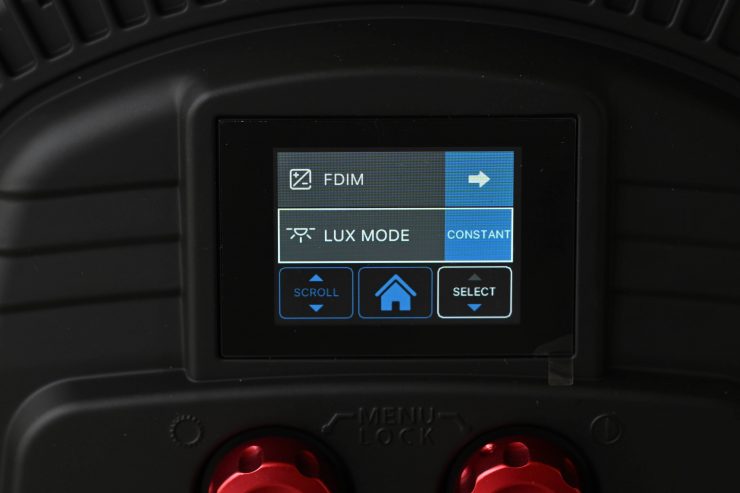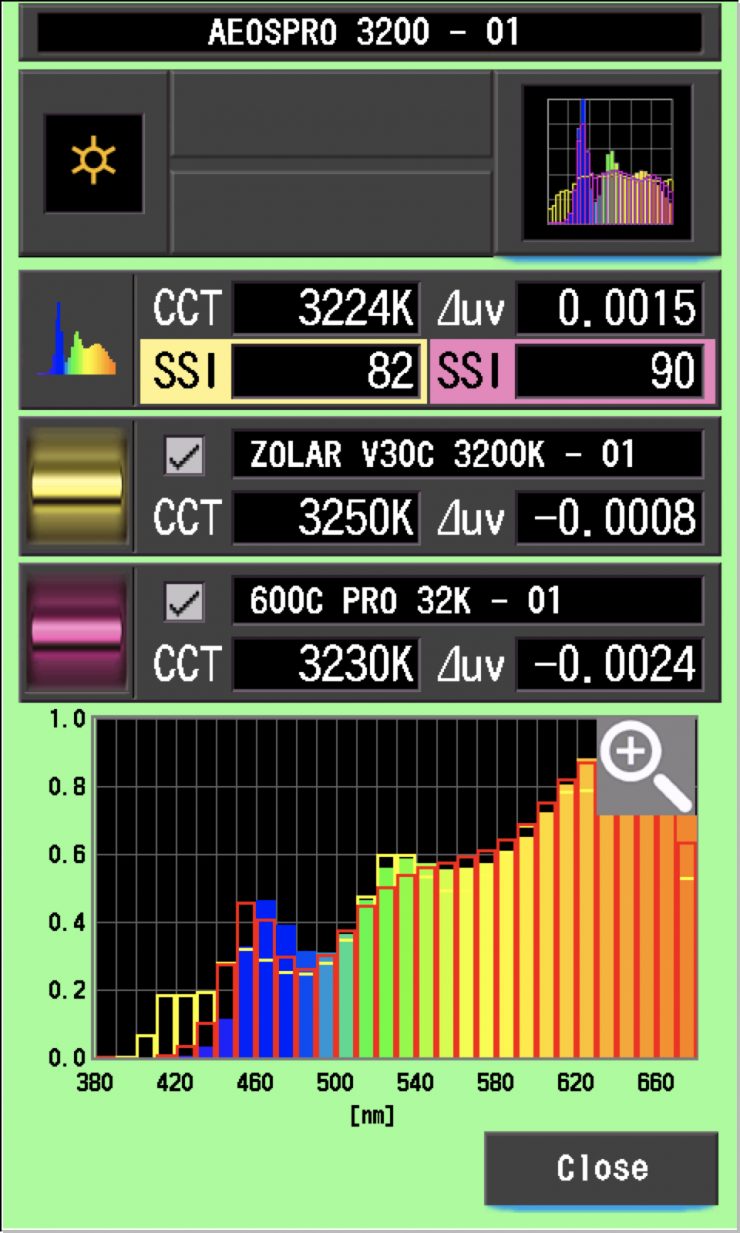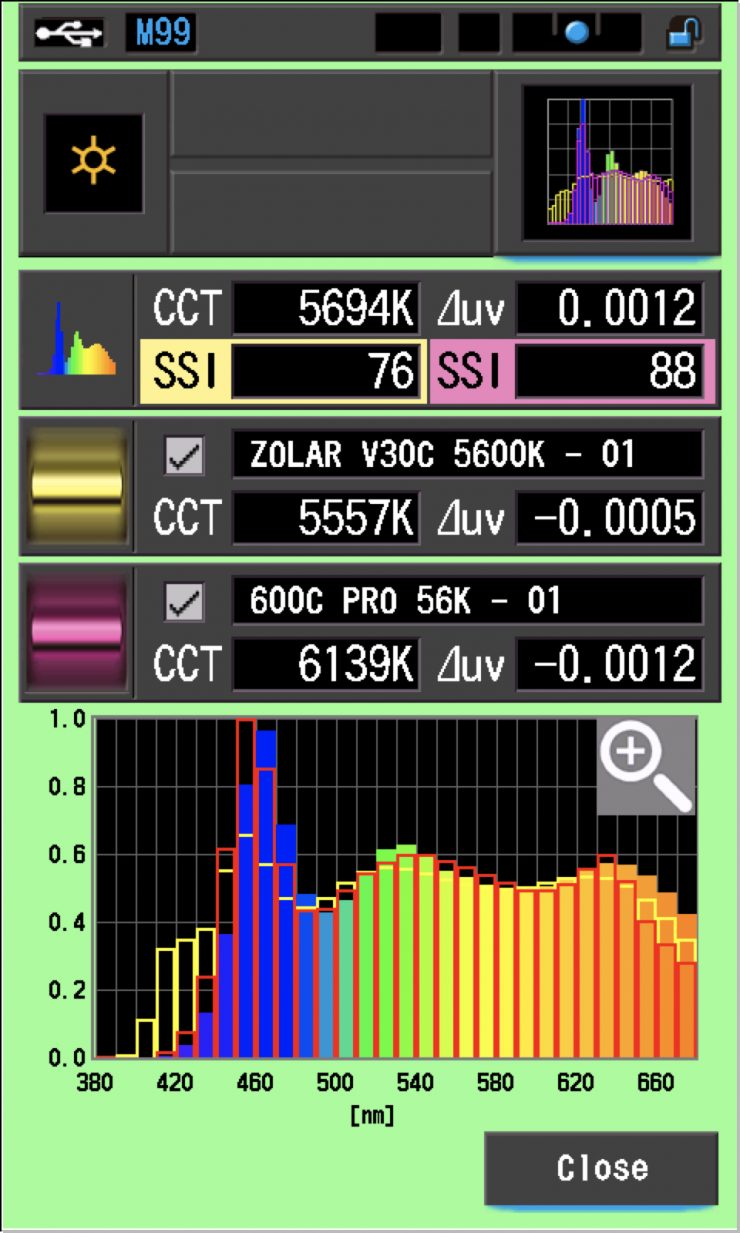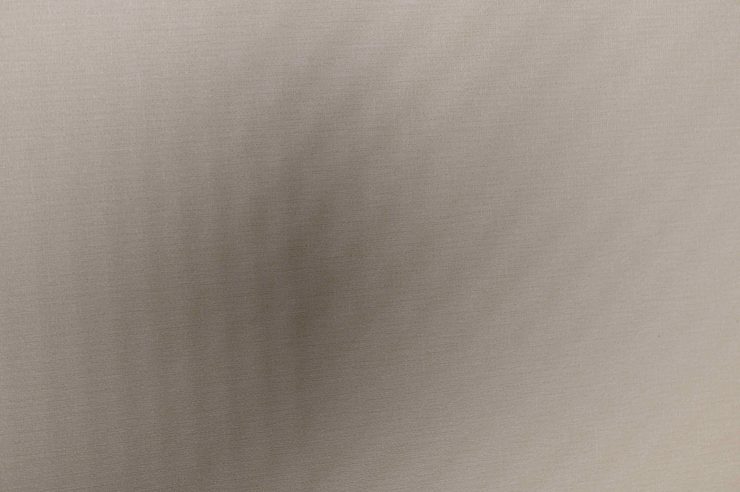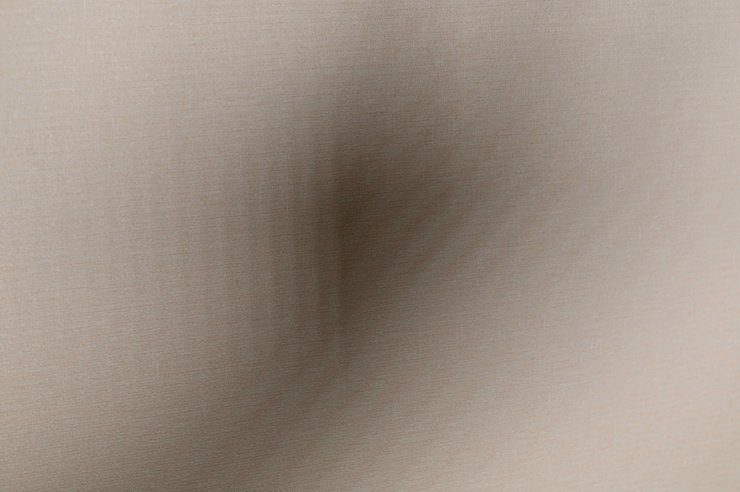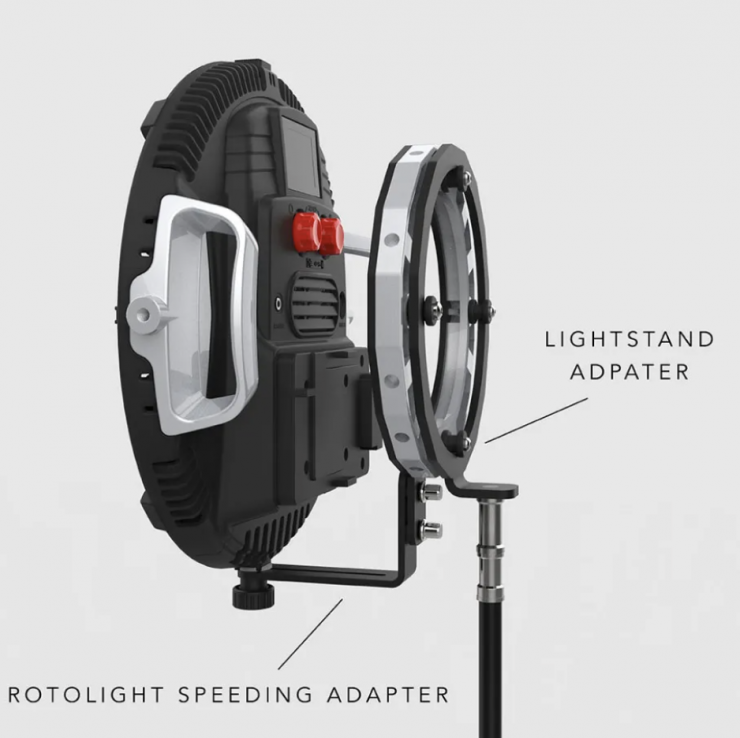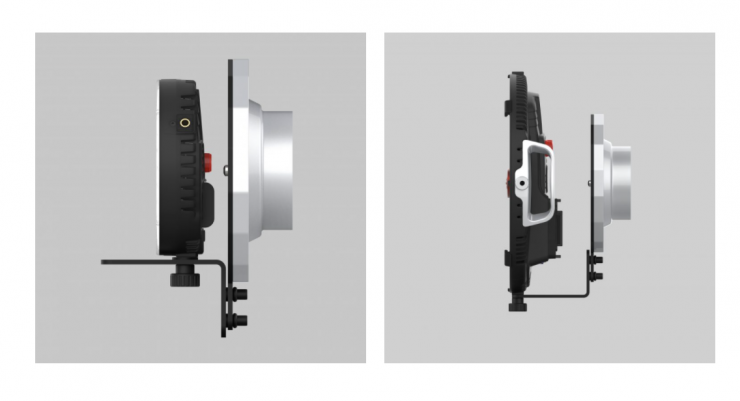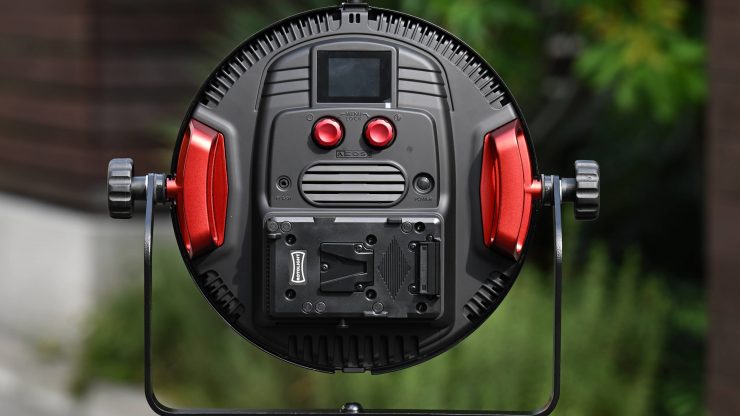
Rotolight’s AEOS 2 PRO is a new lightweight, power-efficient, RGBWW LED light with an impressive range of features. It is a follow-up to the AEOS 2 that was launched at the start of the year, and the original AEOS was launched way back in 2017.
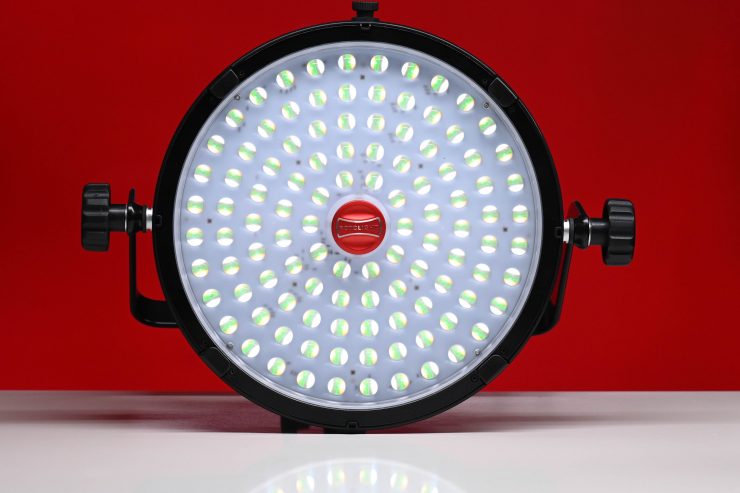
I really liked the original AEOS because it was color accurate, had a decent output, low power draw, and didn’t take up a lot of space in a bag. The AEOS 2 was a good follow up and even though it drew a lot more power, it was far brighter than the original.
So let’s dive in and see what Rotolight has added to the new AEOS 2 PRO.
It’s all Greek to me
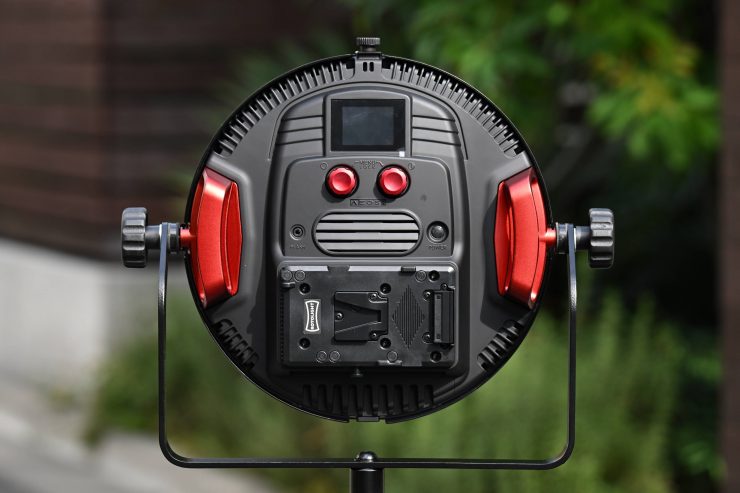
The origin of the name “AEOS” is from ancient Greek mythology, and like any Greek mythological name, there’s a great story behind it. Helios was the Greek god of the sun and each day he drove a chariot across the sky and circled the earth. Pulling his chariot were four Pegusi, one of which was named “AEOS.”
So what’s new?
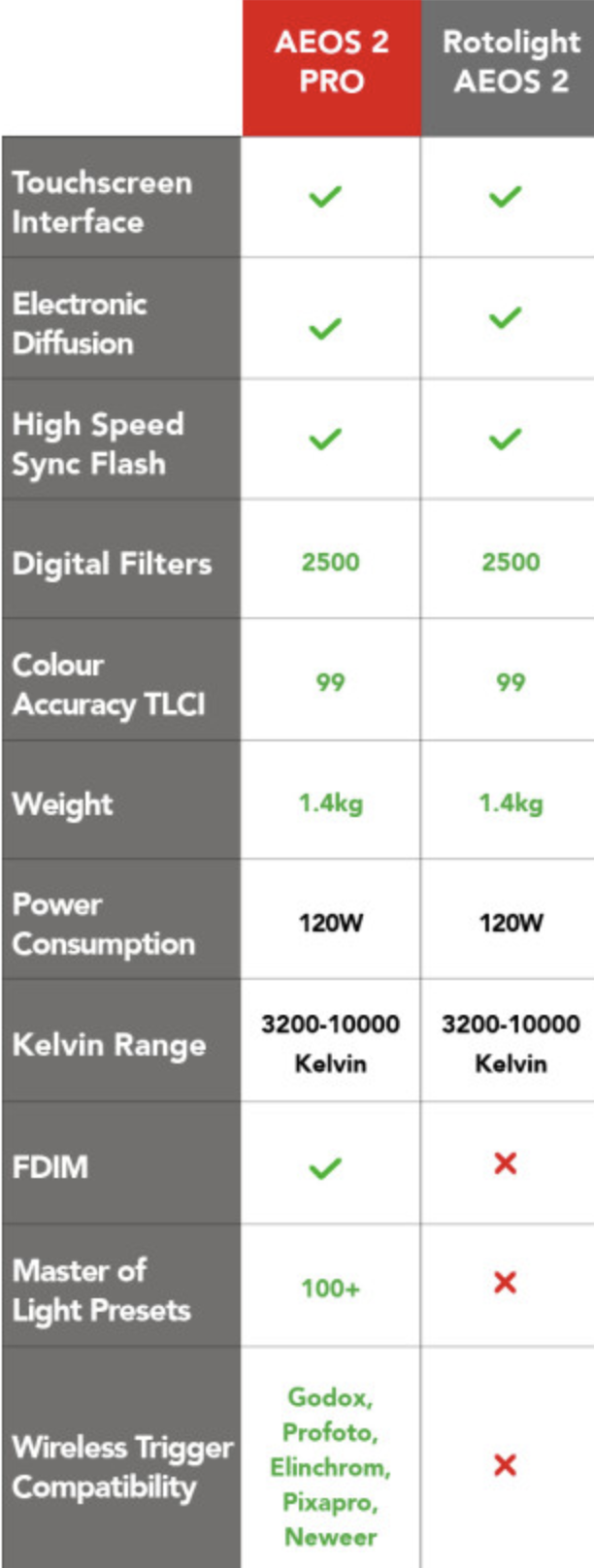
The new Pro version builds on the AEOS 2 by adding some new features and functionality, but essentially it is still based on the exact same platform.
Brightness Boost: Up to +25% greater continuous light output than previous models.
Wireless Flash Trigger Compatibility: Inbuilt Godox, Profoto, Elinchrom, Neewer & Pixapro flash receivers (an industry first), provide flexibility for photographers wanting to wirelessly integrate Rotolight into existing systems or utilize transmitters they already own with Rotolight’s RGBWW HSS flash capability. Flash in any Kelvin from 3000-10,000, 16.7Million colors, or 2500 digital GELS, with zero recycle time.
Masters of Light Preset Packs: The light includes over 100+ built-in exclusive special effects, GEL and HSI color presets, and accompanying tutorial videos from some of the world’s leading photographers and Emmy-winning filmmakers.
Kelvin Presets (CCT mode): An all-new ‘quick-access’ Kelvin presets in CCT mode giving quick access to preset Kelvin temperatures, including 5600K (daylight), 3200K tungsten, 4600K (midpoint), and 6300K (cloudy daylight).
Hardware Upgrades: The PRO edition features metallic red anodized handles.
4 NEW Special FX (SFX): Including ‘Fireworks’, ‘Candle’, ‘Disco’ and ‘Throb’ along with numerous enhancements to many of the existing suite of SFX already found in the standard models.
True Aperture Dimming (FDIM): This mode calculates and displays the light output expressed as an F-stop for a subject at a given distance, ISO, and shutter speed.
Weight & Size
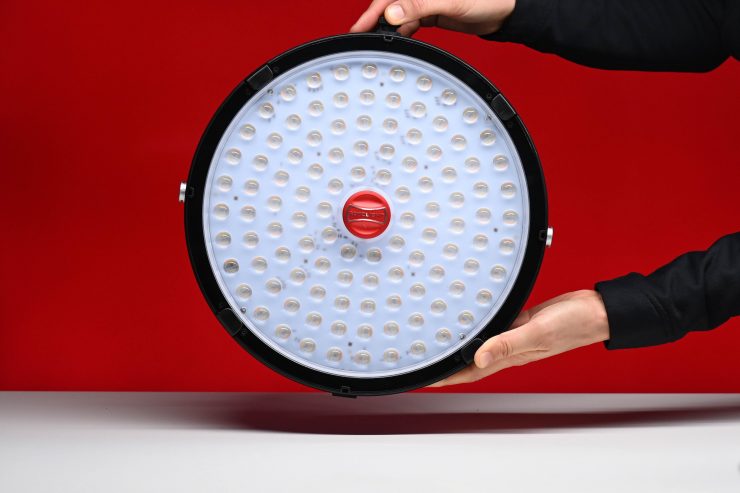
The AEOS 2 PRO weighs 1.4 kg / 3 lbs. It has physical dimensions of 11.5″ x 1″ / 29.5cm x 2.5cm. Rotolight claims that at just 2.5cm (1″) thick, it’s one of the most portable lights on the market.
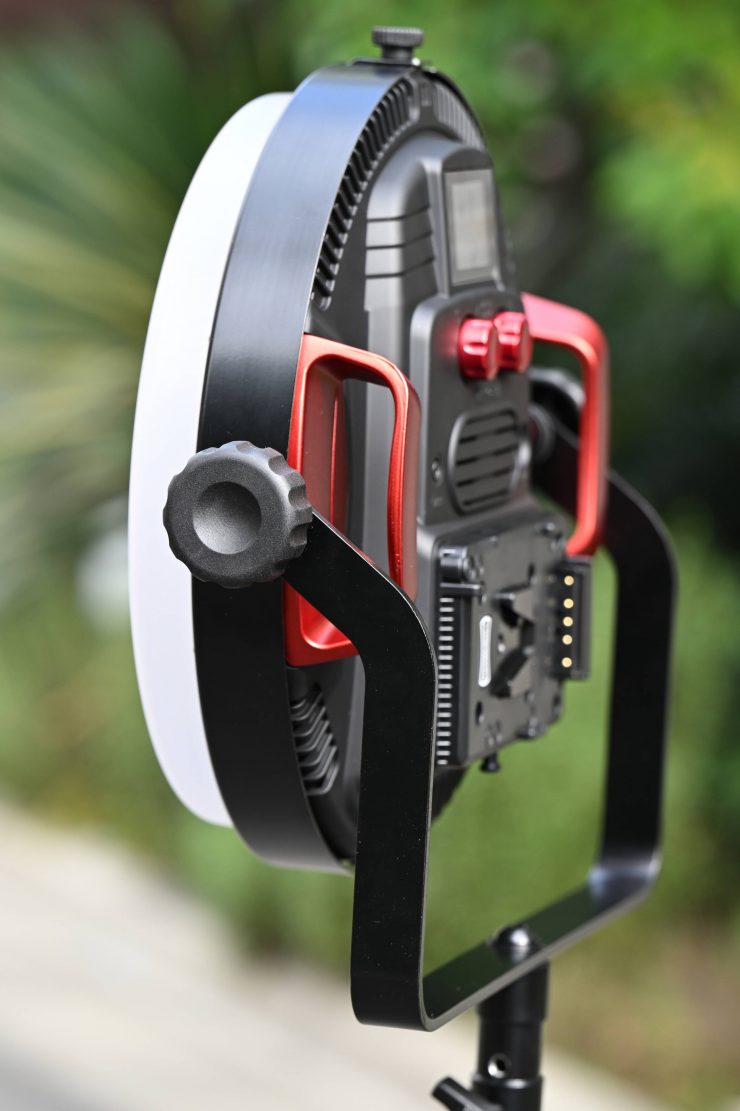
You do need to keep in mind that the 2.5cm of thickness only applies to the actual panel. If you measure the light out to its deepest point, which is the built-in battery plate, the light is closer to 8cm (3.14″). This is still considerably thinner and lighter than most other 1×1 panels.
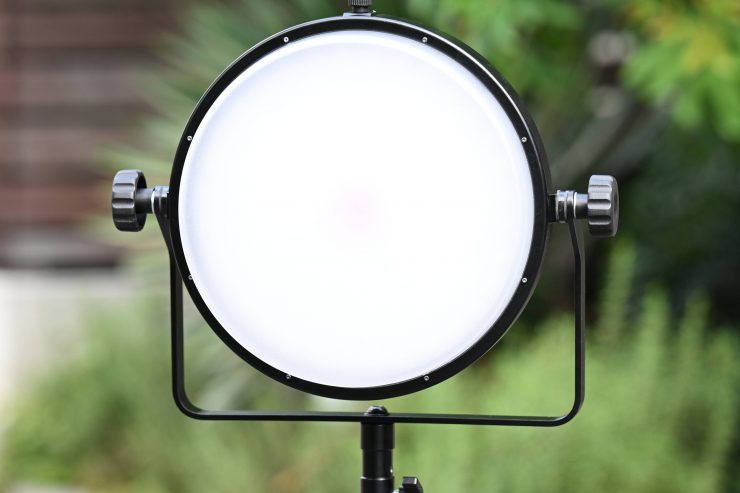
What you clearly need to factor in is that the 1.4 kg / 3 lbs weight figure doesn’t include the yoke frame. With the yoke frame attached the weight is just under 2 kg. Even still, 2 kg is very light for a fixture of this size.
So how does this weight compare to some other 1×1 sized RGBW lights? Below you can see:
| Weight | |
| Rotolight AEOS 2 PRO | 1.4 kg / 3 lbs* |
| Litepanels Gemini 1 x 1 RGBWW LED Hard | 6 kg / 13.2 lb** |
| Luxli Timpani² 1×1 RGBAW LED Light | 4.1 kg / 9 lb (Including Yoke) |
| Z CAM ZOLAR Vega 30C RGBAW | 6.03 kg / 13.26 lb with power supply |
| Aputure Nova P300c RGBWW | 10.35 kg / 22.82 lb (Including Yoke, Cable, Frame, Mount, Receiver) |
| Rotolight Titan X1 RGBWW | 8.6 kg / 19.0 lb* |
| Lupo Superpanel Full Color 30 RGBWW | 3.7 kg / 8.16 lb |
| Lupo Superpanel Soft Full Color 30 1×1 RGBW | 3.7 kg / 8.16 lb |
| Creamsource Vortex4 1×1 RGBW | 11.4 kg / 25.1 lb (Including Yoke) |
* Not including power supply
** Features a built-in power supply.
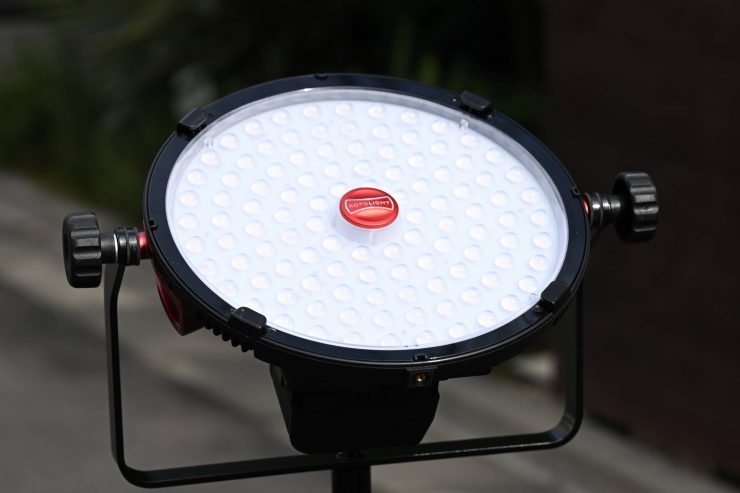
As you can see, the weight of the AEOS 2 PRO is pretty low, considering its size and capabilities. This alone makes it an attractive proposition for anyone who travels a lot and needs to keep weight to a minimum. Excess baggage charges are not cheap and every pound you can save keeps more money in your pocket.
Most traditional 1×1 LED panels as the name implies are 1ft x 1ft. The AEOS 2 PRO is not square, but round. Its 29.5cm diameter is very comparable to that of a 1×1 LED panel but in a much lighter package. Of course, if you do want an even lighter and thinner 1×1 LED then flexible panels from companies such as Intellytech, Westcott, and Aladdin are available, but they don’t tend to produce nearly as much output.
The other big benefit of the AEOS 2 PRO only weighing 1.4kg is that you can attach the light to a ball head. By doing this it gives you a lot more possibilities for lighting angles, shadow control, and creative manipulation of the light. Because most other LED panels weigh upwards of 3.5 kg, they have been too heavy for ball heads, so you had to use a yoke frame. The problem with yoke frames on any panel, is they sometimes limit the tilt angle, especially when you attach a softbox.
Not having to carry around a big yoke frame also allows the AEOS 2 PRO to be packed into smaller bags which is always handy when you are traveling.
One of the biggest reasons for shooters to look at the AEOS 2 PRO is the lack of weight and its small footprint. That is what makes it different from other available options on the market.
Power Draw
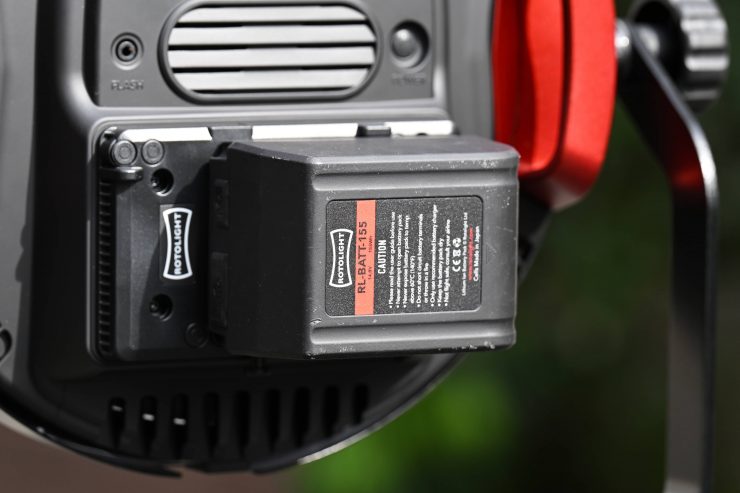
I wouldn’t normally talk about power draw so high up in a lot of lighting reviews, but it was one of the AEOS’s biggest strengths. The original AEOS drew just 42W and that was one of its biggest appeals.
Unfortunately, or fortunately, depending on which way you want to look at it, Rotolight has upped the power draw to 120W for both the AEOS 2 and AEOS 2 PRO. This is a significant increase, however, the upside is that the light is a lot brighter than the original. Yes, you can still run it via a single flight-safe battery, however, I would have liked to have seen the light draw under 100W. In saying that, most 1×1 panel-style lights these days draw significantly more power and can’t be run via a single flight-safe battery.
So how does the power draw compares to other fixtures:
| POWER DRAW | |
| Rotolight AEOS 2 PRO | 120W |
| Litepanels Gemini 1 x 1 RGBWW LED Hard | 200W |
| Luxli Timpani² 1×1 RGBAW LED Light | 120W |
| Z CAM ZOLAR Vega 30C RGBAW | 200W |
| Aputure Nova P300c RGBWW | 360W |
| Rotolight Titan X1 RGBWW | 350W |
| Lupo Superpanel Full Color 30 RGBWW | 200W |
| Lupo Superpanel Soft Full Color 30 1×1 RGBW | 200W |
| Creamsource Vortex4 1×1 RGBW | 325W |
If you combine the lightweight and compact size of the AEOS 2 PRO with its low power draw, it makes it a good solution for news crews or shooters who travel a lot and need to keep their excess baggage to a minimum. The ability to take a light on location and be able to run it off a single flight-safe camera battery is something that shouldn’t be overlooked. This is something that can’t be done with a lot of 1×1 style panels that are on the market.
Build quality
Despite the low weight, the AEOS 2 PRO like all of Rotolight’s latest fixtures is solidly made. The AEOS 2 PRO has gained metallic red anodized handles, but the overall build quality is the same as the AEOS 2.
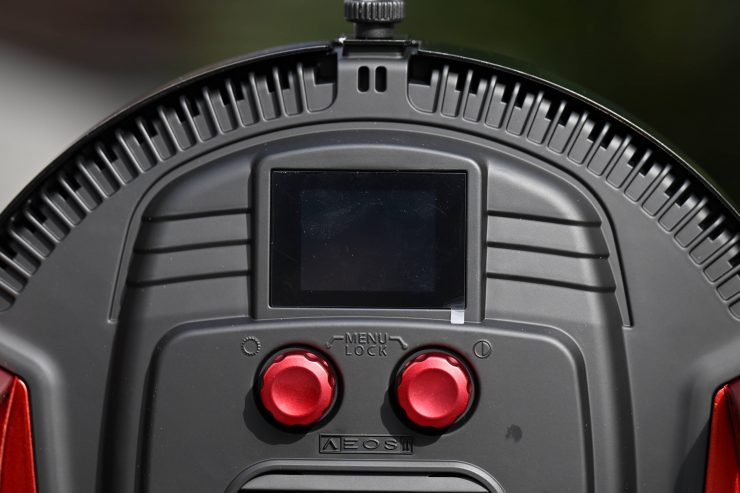
The buttons and controls are all tactile and nice to use.
The casing is robust and the built-in anodized aluminum handles are a nice touch. Sometimes it is nice to have a light that is easy to hold if you are moving around with the camera.
The yoke frame locks in solidly onto the sides of the handles, and if you tighten both of them down the light won’t move at all.
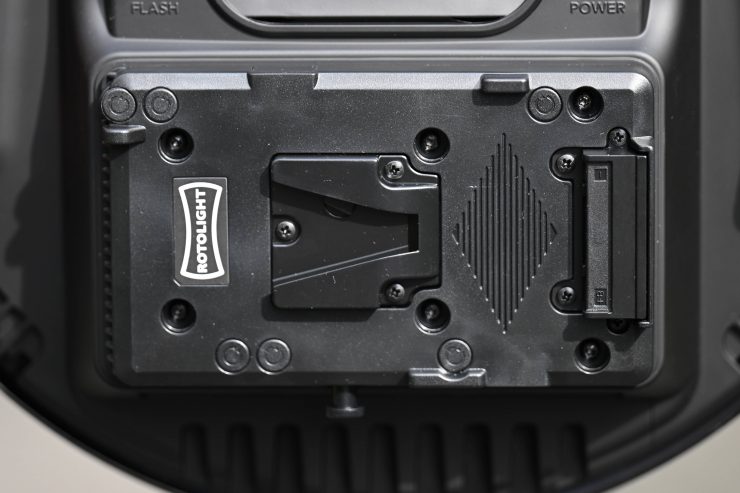
The light comes with a built-in V-lock battery plate (why some manufacturers make this an optional extra on so-called portable field lights is beyond me), which makes a lot of sense given its size and portability, and the fact it can be powered via a single flight-safe battery.
Unfortunately, Rotolight doesn’t make an AB Gold Mount version, however, you could use an adapter plate if all you had was Gold Mount batteries.
RGBWW
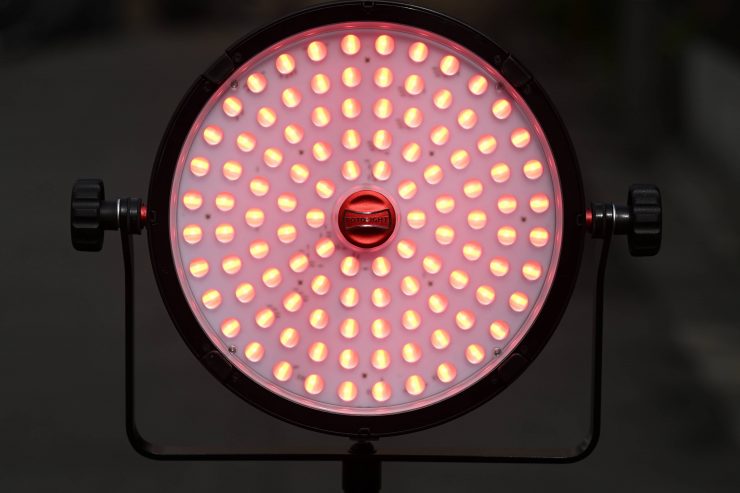
The AEOS 2 PRO features full RGBWW capabilities and it is Kelvin color adjustable from 3000-10,000K.
Physical Controls & Operation
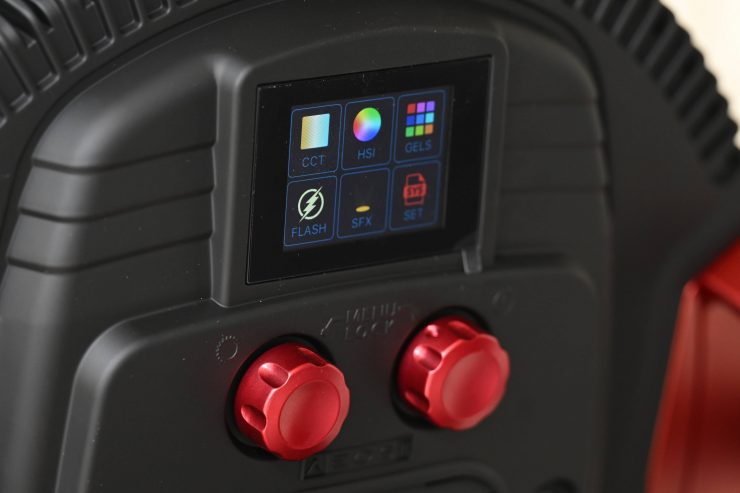
The AEOS 2 PRO, just like the AEOS 2, features a touchscreen menu and interface.
In a lot of ways, it is a scaled-down, smaller version of the touchscreen operating system they introduced on the Titan X2 and Titan X1.
The operating system is so much better than the original AEOS. It is intuitive, easy to see, and most importantly, easy to use. I did find that it can be a little hard to set it to the exact output or CCT value you want using the touchscreen sliders.
As I already mentioned, the light can be adjusted from 3000K up to 10,000K in increments of 20K. It can also be dimmed from 100% to 1% in 0.5% increments.
What I like is that Rotolight allows you to make some changes using the two dials. You can’t access menus or modes with the dials, but you can make changes to things like intensity and Kelvin color temperature, etc. Not having to use the touchscreen can be handy, especially in colder environments where you have to wear gloves.
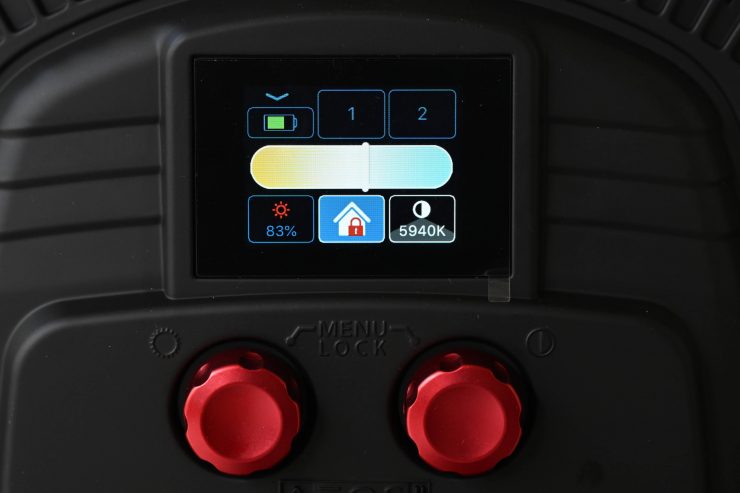
You can also press both of the red dials to lock the screen.
The light has a DC input, Ethernet, a port for flash control, and a USB port.
Rotolight iOS & Andriod App
The AEOS 2 PRO features integrated Bluetooth and WiFi and a new Rotolight iOS and Android app allow users to switch between lighting modes to remotely adjust color, power, SFX, etc. The app also lets you create custom groups and projects for use with up to 20 lights simultaneously.
Having a wireless app is something that is long overdue for Rotolight fixtures.
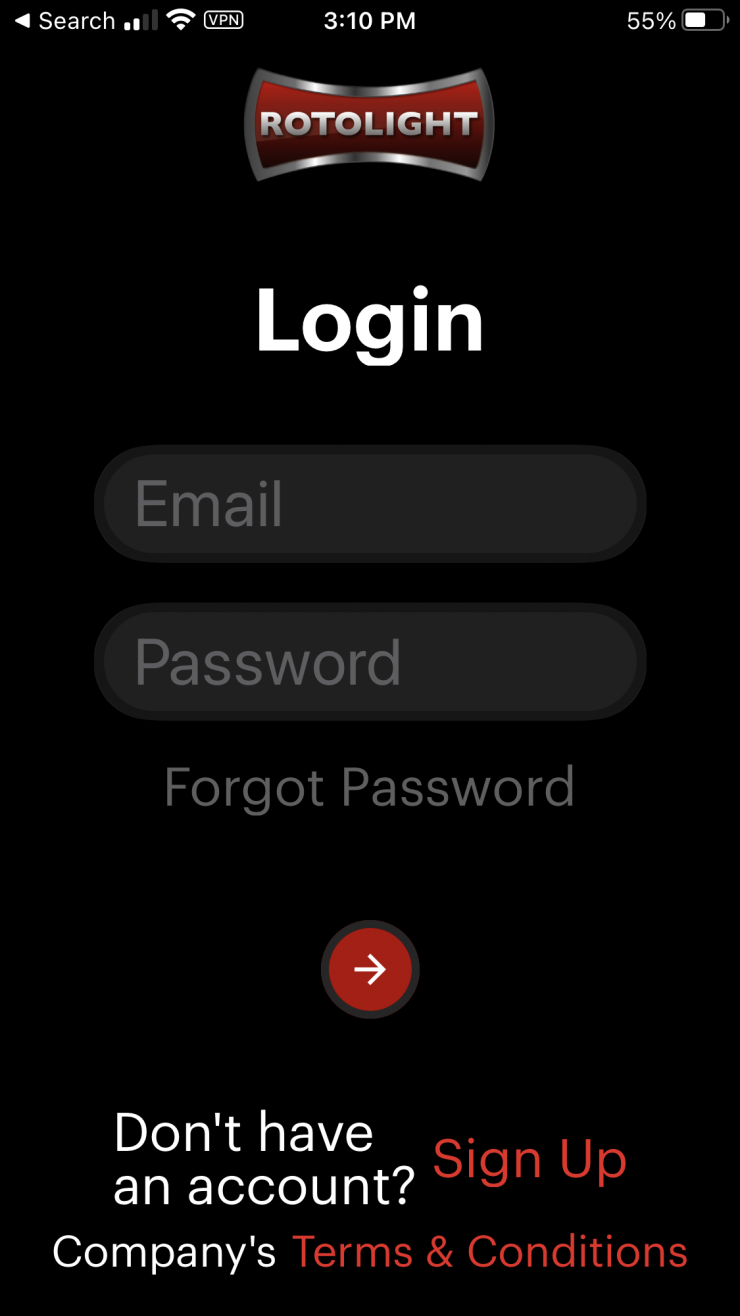
The pet peeve I have with the app is that you need to create an account and register before you can use the app. This requires you to give personal information.
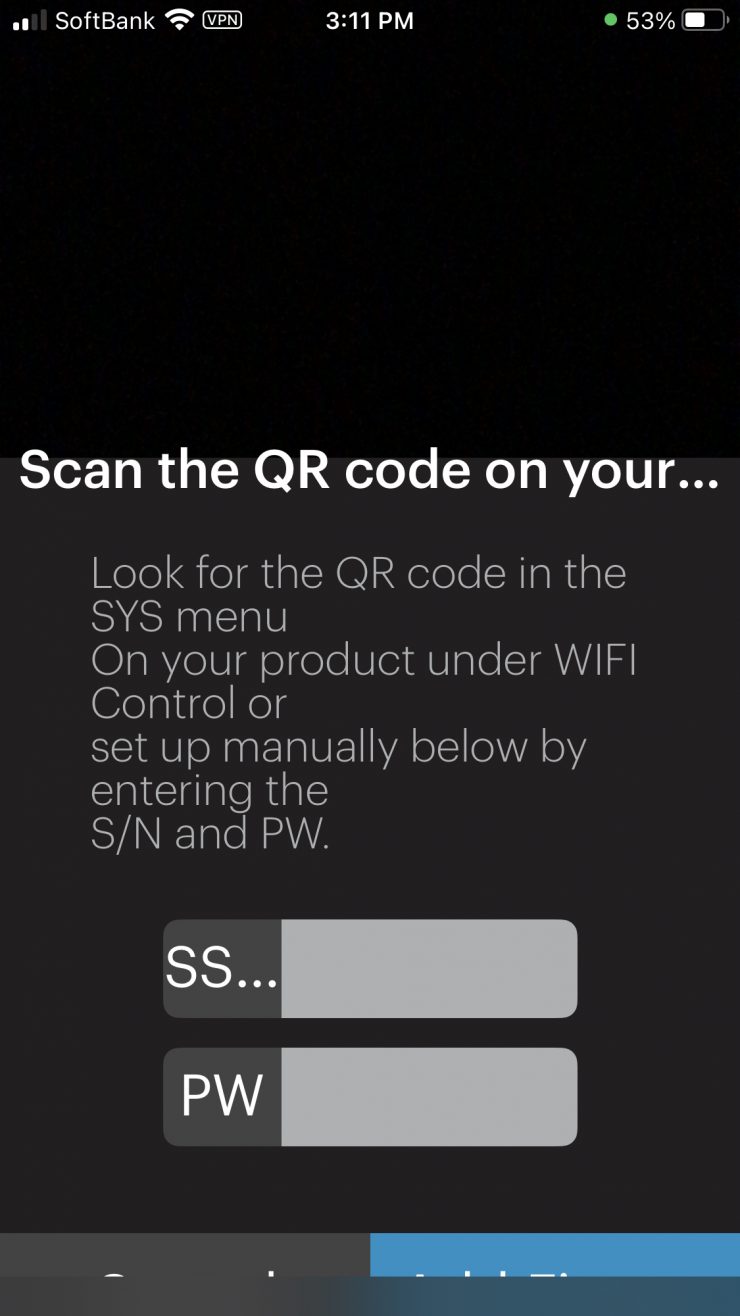
Once you have registered an account you then need to scan the barcode in the System menu (this can be found under the Control tab) or you can enter the S/N and password if you prefer.
Now, after I did this I couldn’t actually use the app unless I enabled location permissions. I am not quite sure why Rotolight needs to know where I am.
Once you have sorted all of this out, which thankfully you only need to do once, you can use the app.
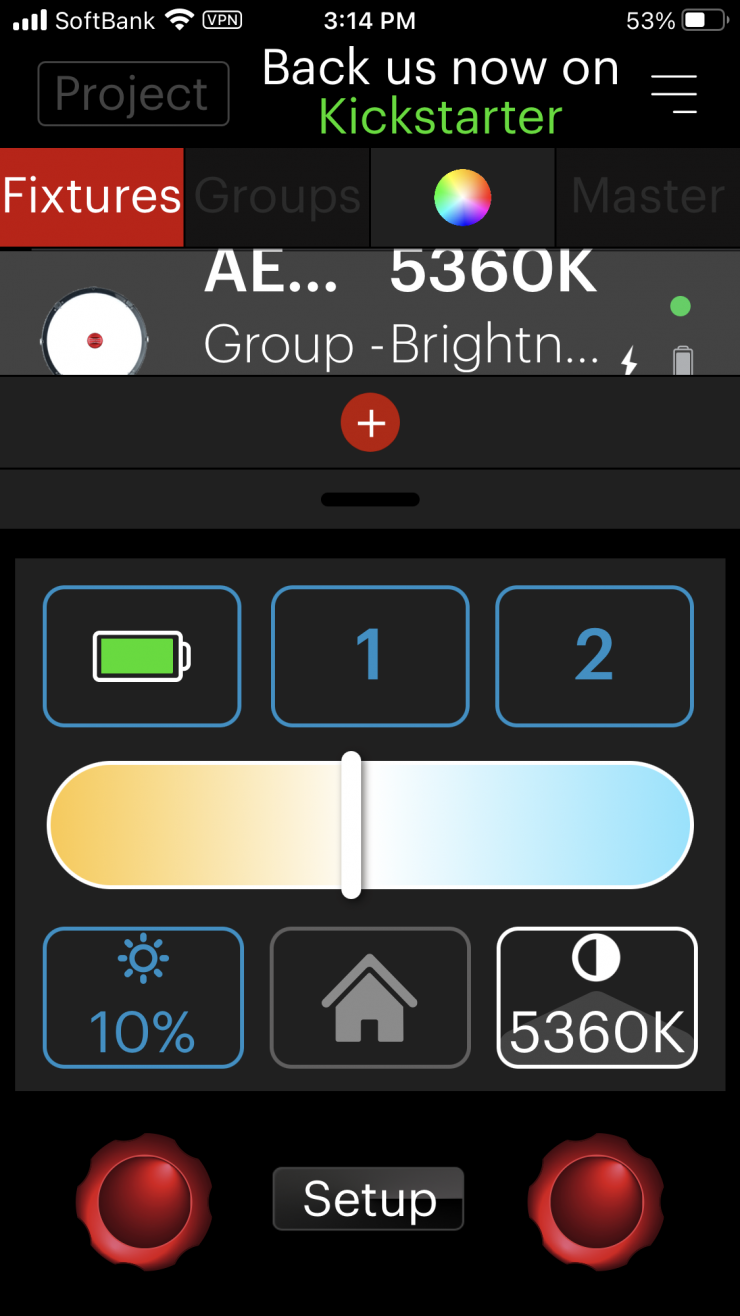
The main interface is fairly straightforward and easy to navigate and use, although I didn’t like the clutter at the top of the screen with a big Kickstarter advertisement.
The interface basically works in the exact same way as the rear control screen on the AEOS 2 PRO.
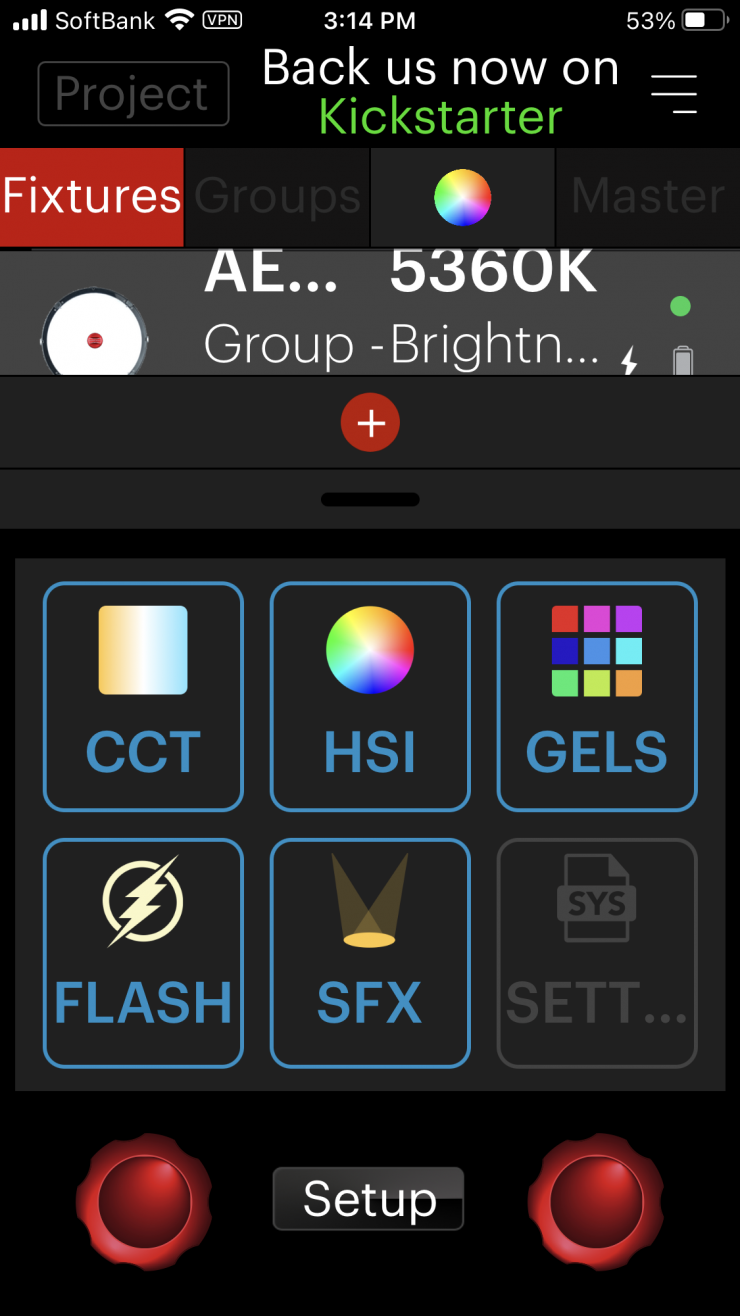
The only thing you don’t have access to on the app is the System Settings.
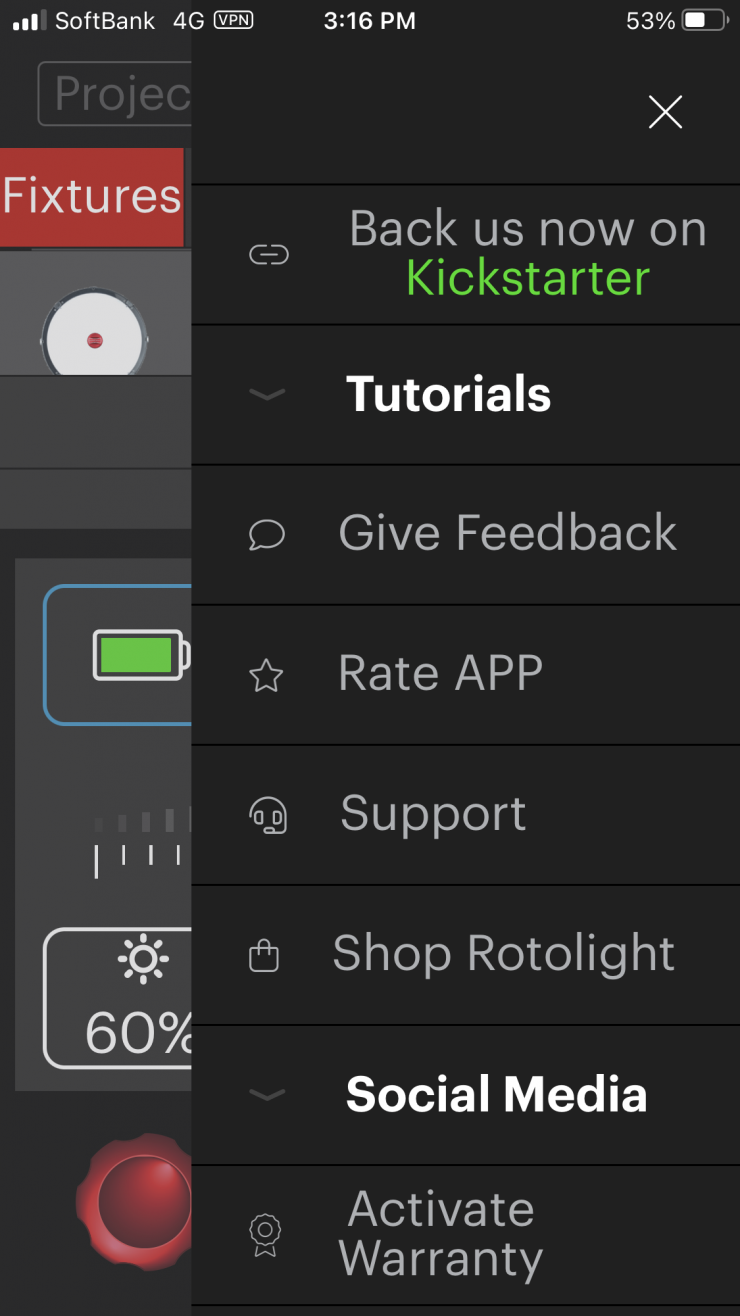
You can also click on the tab in the top right-hand corner of the app and you will get a drop-down menu with tutorials, access to support, etc.
Mounting
The AEOS 2 PRO has four 1/4 20″ mounting points. This gives the user a variety of ways to mount the fixture. However, most times you will probably be using it with the included yoke frame.
Increased Output?
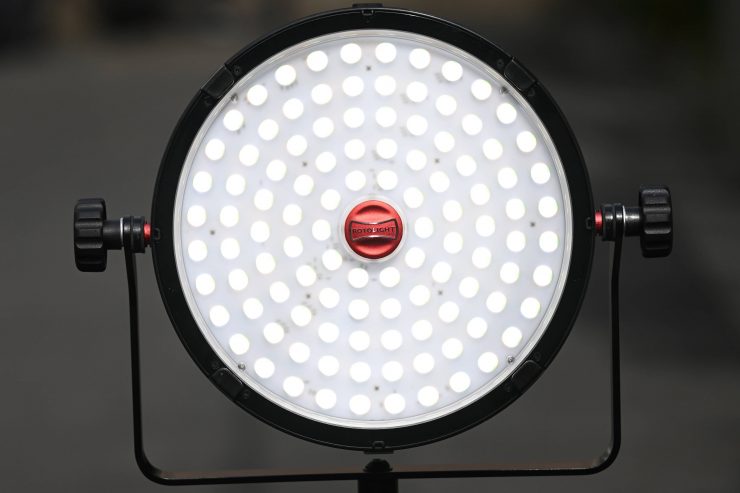
RGBWW 1×1 sized or similar lighting sources are great for solo operators or small-sized crews, but usually to obtain a decent amount of output they feature a high power draw. This can often mean that they aren’t suitable for anyone traveling because they need to be powered by batteries that you cannot take on planes.
What Rotolight didn’t want to do is limit the amount of output, because that is usually what happens if you use a low power draw. There is always a fine line manufacturers have to walk to balance power draw and output. Rotolight has thought carefully about this and kept the AEOS 2 PRO’s power draw to 120W.
Rotolight claims that the AEOS 2 PRO is 25% brighter than the AEOS 2. I will test this claim further down in the review.
Fans
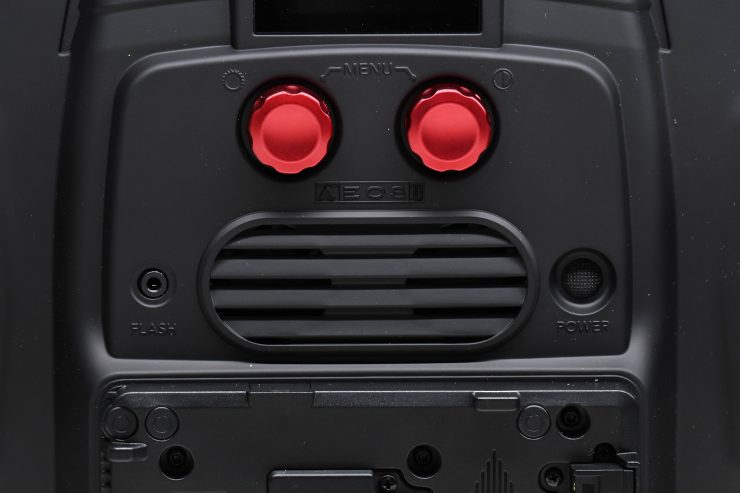
The AOS 2 PRO has two small fans on the back of the fixture.
The fans are quite noisy when the light is on at higher outputs with the fan in its Auto setting. If you have the light on for about 5-7 minutes the fans start to kick in. The fans, at least to my ear, continue to get even louder the longer the light is on. If you reduce the output level down to 50% the fans do get quieter after a couple of minutes. Eventually, they will almost turn off completely if you leave the output at 50%. If you turn the intensity up again, the fans will start making more noise after a few minutes.
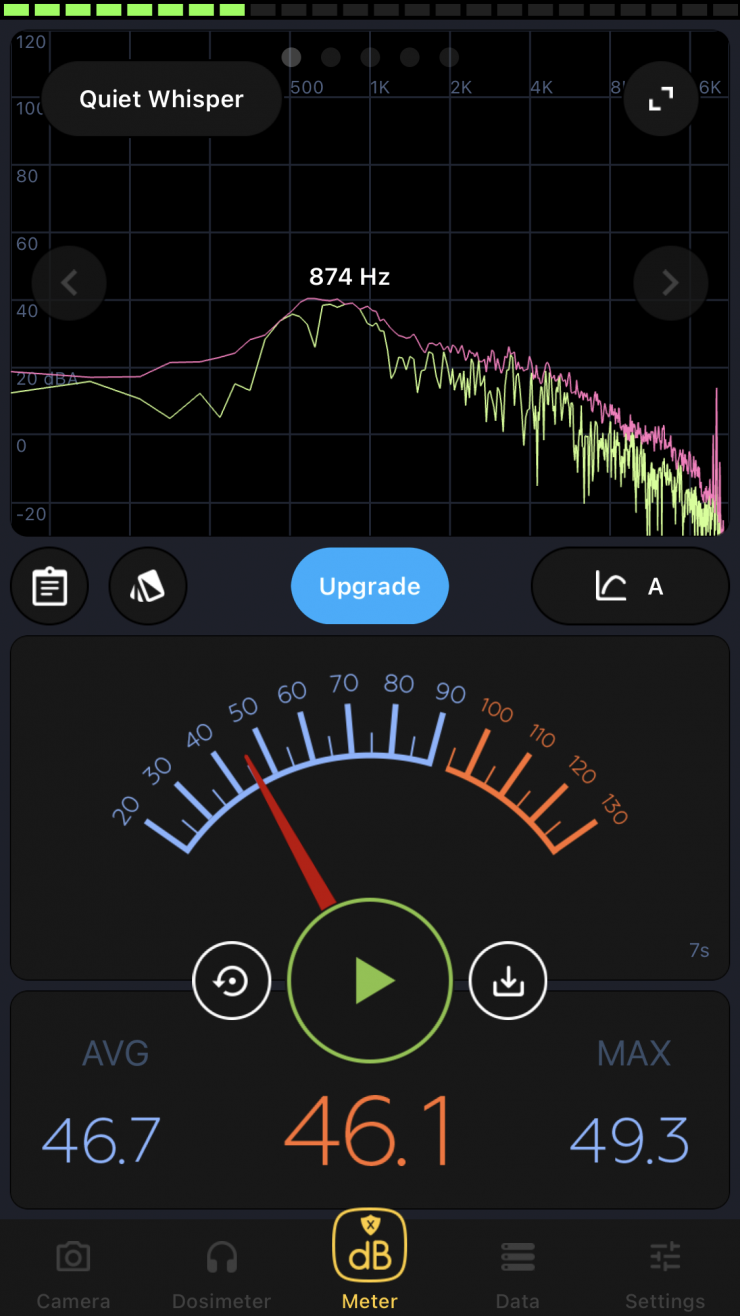
Directly behind the AEOS 2 PRO with the output set at 100% & fan in Auto setting 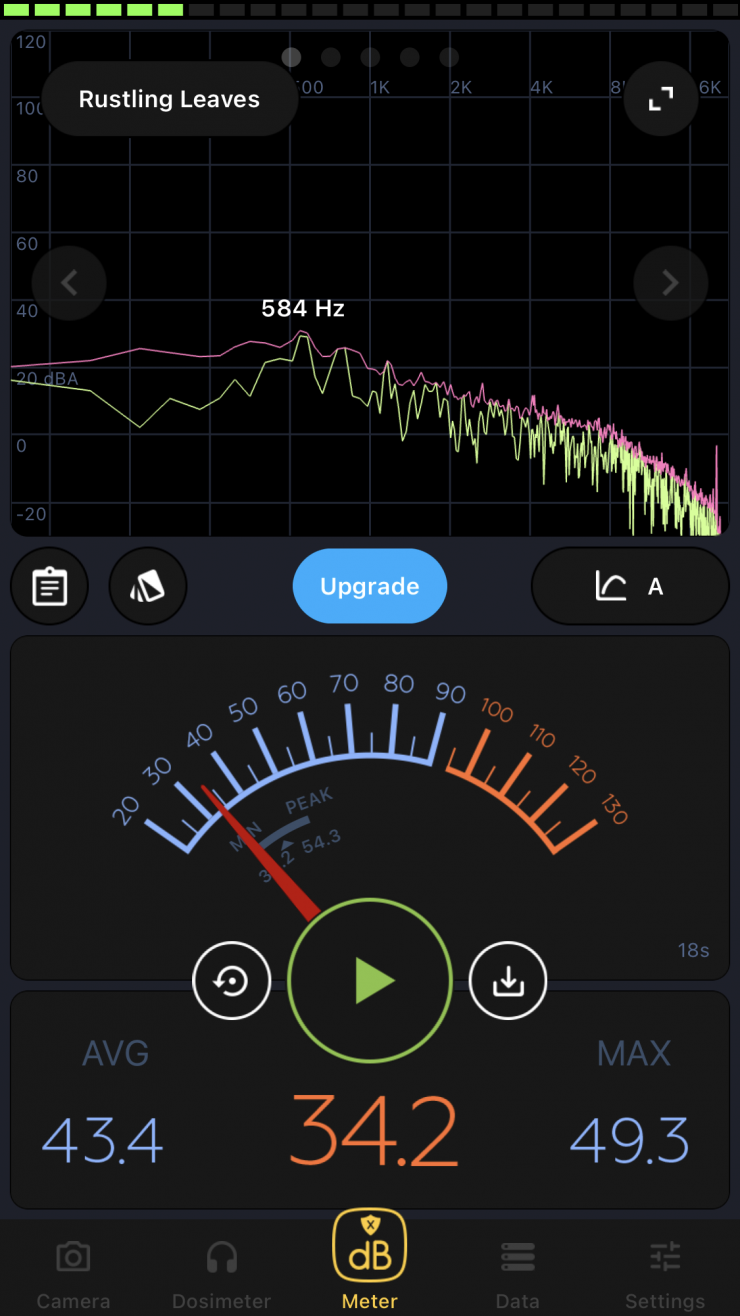
1m / 3.28 ft in front of the AEOS 2 PRO with the output set to 100% & fan in Auto setting
Above you can see measurements I took from directly behind the fixture and at 1m /3.28 ft in front. This was with the light set at 5600K and at 100% output.
When I moved the CCT down to 4660K (where the light has the most output) the fan noise was only marginally louder than when the light was used at 5600K.
RGBWW lights generate a lot more heat than regular LED lights and cooling becomes an issue especially if you are trying to get a lot of output. Rotolight has seemingly traded fan noise for more output.
The AEOS 2 PRO features a fan control setting (Auto, Video, Off) in the system menu, which is similar to what is found on the Titan models. This allows the user to select Off so that if you are shooting video, there will be no audible noise at all. In the Video setting the fans do come on, but they are not overly loud. The AEOS 2 PRO has intelligent temperature sensors and often the fan is not even on at all. It is only when the light is being pushed near maximum brightness levels for prolonged periods of time that the fans kick in even in auto mode.
I left the light on for a considerable period of time at 100% output with it set at 5600K and the fan switched to Off to see what would happen. The fans didn’t kick on at all and the light remained silent.
Now, here’s the catch. If you have the light’s fan setting set to Off, the maximum output gets capped. I measured the light at the same settings with the fan in Auto and the fan in Off and in the Off setting the output was reduced by 32.4%. If I set the fan to Video the light had 30% less output than when used in the Auto setting.
This is something you really need to be aware of because a manufacturer can make all sorts of claims about maximum output, but if you can’t use that output because the fan noise is too loud then that output doesn’t really matter.
Operating Modes
CCT Mode
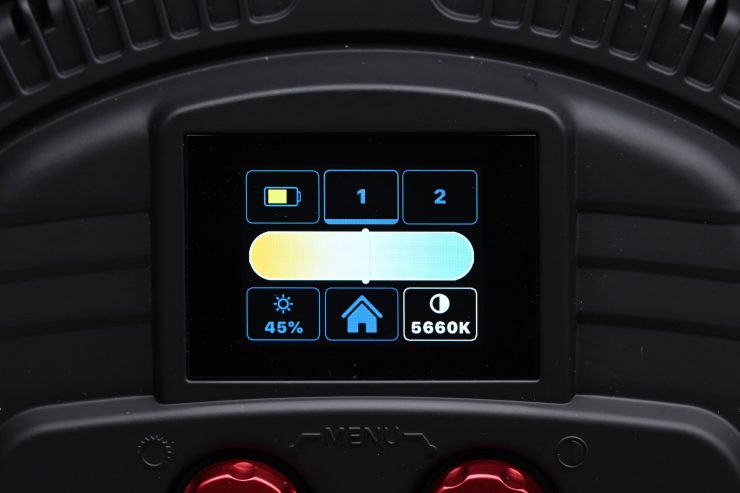
The traditional correlated color temperature (CCT) mode allows you to adjust your color temperature from 3000 to 10,000K in 20K increments. This lets you emulate any lighting condition, from the cool hues of bright sunlight to the warmth of a tungsten bulb. Dimming can be done in increments of 0.5%. Unlike some lights, the AEOS 2 PRO actually stays on all the way down to 1%.
Despite being an RGBWW light, CCT Mode is the one most people will find themselves using the most often.
The AEOS 2 PRO also features an all-new ‘quick-access’ Kelvin presets in CCT mode which gives users quick access to preset Kelvin temperatures, including 5600K (daylight), 3200K tungsten, 4600K (midpoint), and 6300K (cloudy daylight).
HSI Mode
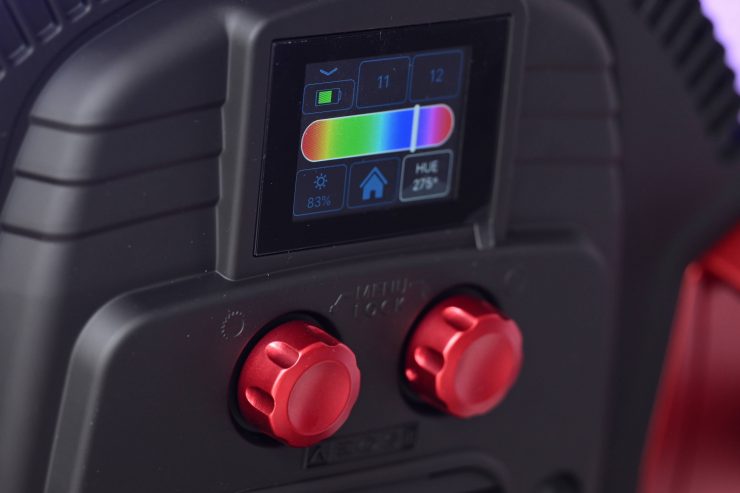
In the HSI Mode, you can independently adjust hue, saturation, and intensity. This is easy to do on the AEOS 2 PRO because of the nice graphic touchscreen interface.
Gels Mode
If you select the Filter Mode you can select from 2,500 different filters. It is very impressive to see so many filters available in the AEOS 2. There is literally a filter for just about any need you may encounter.
The only small caveat when you are in Gel Mode is that you can only scroll through the selections using a button. You can’t do it via the touchscreen.
+/- G/M Correction
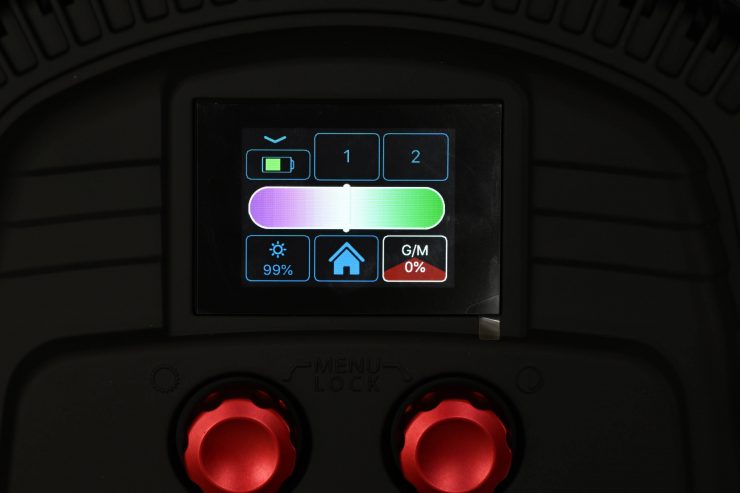
I am glad Rotolight decided to include +/- G/M adjustments on the AEOS 2 PRO. This really should have been included on the AEOS 2.
SFX Mode
Rotolight has always been known for its SFX and the AEOS 2 PRO includes an SFX mode with 16 different effects you can choose from:
- Fade
- Lighting
- Strobe
- Cycle
- Fire
- Police
- TV
- Gunshot
- Neon
- Film
- Weld
- Paparazzi
- Fireworks
- Candle
- Disco
- Throb
4 new Special FX (SFX) Including ‘Fireworks’, ‘Candle’, ‘Disco’ and ‘Throb’ along with numerous enhancements to many of the existing suite of SFX already found in the standard models.
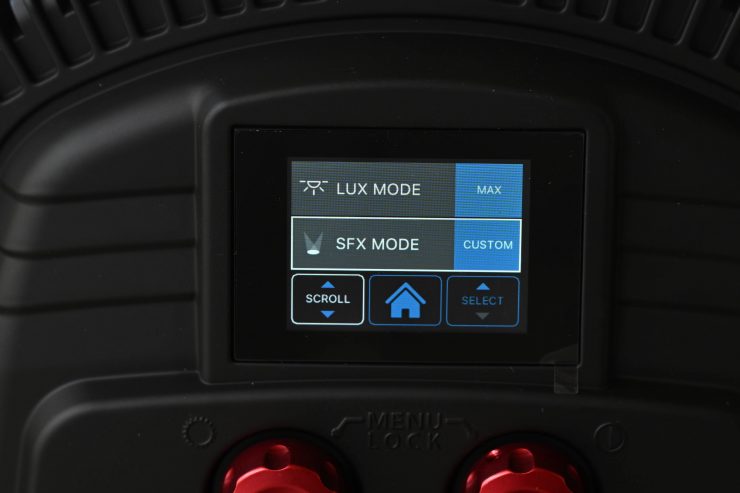
In the Sytems settings, there is an option to change the SFX from Default to Custom.
These SFX are nice to have, and depending on what type of work you do they could come in very handy.
Flash Mode
The AEOS 2 PRO combines the benefits of continuous light, with a High-Speed Sync RGB flash, for more power or to freeze action.
Having an inbuilt HSS flash means that the AEOS 2 PRO is a very attractive proposition for anyone doing multi-media work, particularly in studios.
The AEOS 2 PRO features an HSS Flash Mode. So what is HSS flash? High Speed Sync works by continuously pulsing the flash at very high speeds creating a stroboscopic effect that illuminates the shutter slit as it moves down the sensor. As HSS outputs so many pulses (flashes of light), it creates the illusion of having a continuous light source. The drawback of HSS is that the actual light output from the flash will be lower and the output changes depending on the shutter speed. By using HSS you can create a consistent lighting source on your subject, but the flash (or in our case the AEOS 2 PRO) needs to be reasonably close to your subject.
As the AEOS 2 Pro is an RGBWW fixture you can now flash in any one of 16.7 million colors or 2,500 digital filters.
So how does the AEOS 2 PRO use HSS? Rotolight has an Elinchrom Skyport chip built right into the fixture. This 2.4 GHz Elinchrom Skyport Receiver makes it possible to use the AEOS 2 as a remote flash with high-speed sync support up to 1/8000 second.
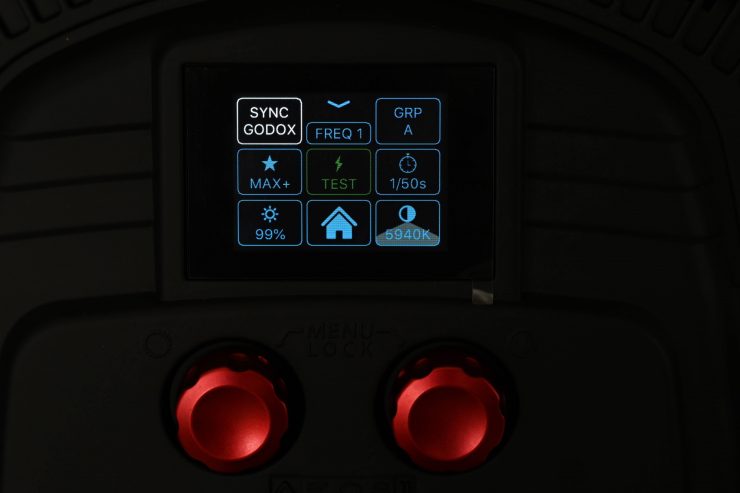
What is new with the PRO version is that Rotolight has now added greater wireless flash trigger compatibility. The AEOS 2 PRO will now work with Godox, Profoto, Elinchrom, Neewer & Pixapro flash receivers (an industry first), providing flexibility for photographers wanting to wirelessly integrate Rotolight into existing systems or utilize transmitters they already own with Rotolight’s RGBWW HSS flash capability.
You can wirelessly trigger the SFX on up to 10 lights in 4 groups at the same time. Rotolight claims this can be done up to 656′ (200m) away. You can also use any other flash trigger with a PC sync port, but you won’t be able to control the power output remotely.
One of the problems with using traditional flash photography is the recycle time. Photography strobes can only keep firing for a certain amount of time before they need to re-charge up to be used again. The AEOS 2 PRO has no such problem as it doesn’t need any recycling time so it can keep firing the flash continuously.
I previously tested this functionality with the AEOS 2 so I will tell you what I found. From my tests, I found that if you used the HSS mode on the AEOS 2 (5600K) and compared it directly to a Canon 600 EX-RT flash (set to HSS Mode ISO 400, F4, and 1/400th shutter speed) at a distance of 1m /3.28′, the Canon flash had to be set at 1/32 power to match the AEOS 2 when it was set at 100% (with Max + activated) to achieve the same result. Please note that these tests with the AEOS 2 were done using a battery and not mains power.
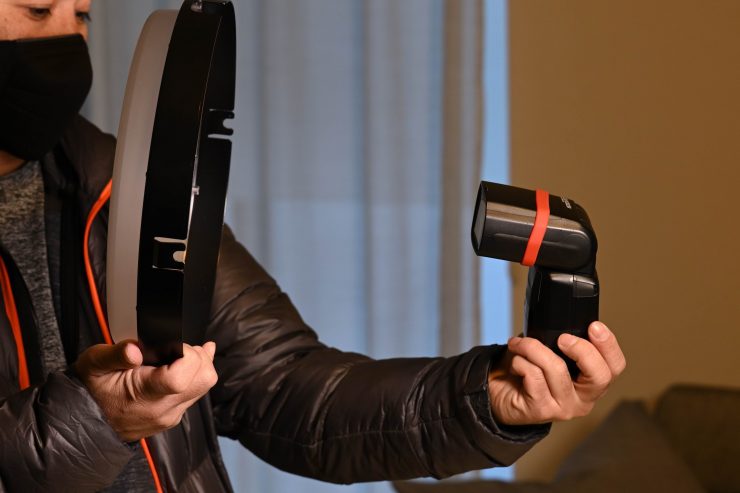
To keep this test even, the Diffusion Dome was attached to the AEOS 2 and the Canon flash was punched through the same Diffusion Dome.
One thing traditional flashes can’t do is HSI or change CCT values without the use of filters or gels. This is an advantage that the AEOS 2 PRO has. You also can’t shoot video with a flash, whereas with the AEOS 2 PRO you have the ability to shoot both stills and video with one light. This is handy for anyone doing multi-media work. While it isn’t going to have anywhere near the power of a flash or strobe, it will work reasonably well indoors in controlled environments.
True Aperture Dimming (FDIM)
True Aperture Dimming (FDIM) calculates and displays the light output expressed as an F-stop for a subject at a given distance, ISO, and shutter speed. This works reasonably well, while I don’t find it to be totally precise it does certainly put you in the ballpark where you then only need to make minor adjustments.
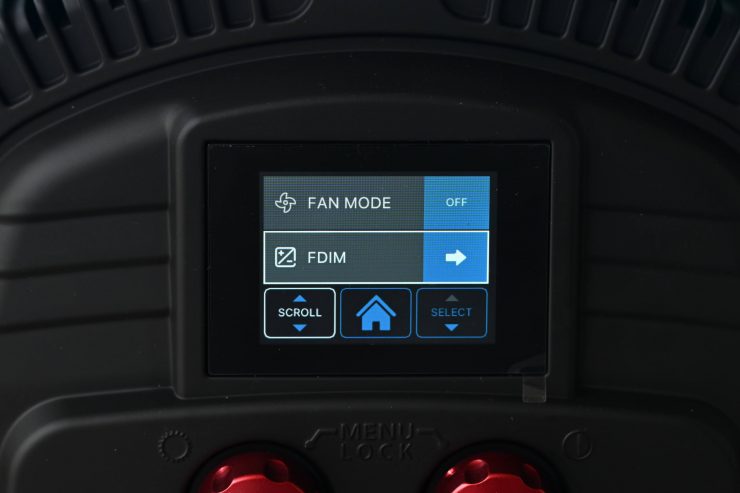
You might find True Aperture Dimming hard to find in the menu. You need to go to System settings and then look for FDIM.
I am glad Rotolight put this into the AEOS 2 PRO, but I am still a bit puzzled as to why it wasn’t put into some of the latest Rotolight offerings, especially since it is a feature that was found on lots of their earlier lights.
Max Lux or Constant Lux
You can set the light to be in Max Lux or Constant Lux mode. In Max Lux mode the light will output the maximum amount it is capable of at every CCT setting. If you select Constan Lux, it will output roughly the same amount at every CCT setting. What you clearly need to be aware of is that the light will have reduced output when operating in the Constant Lux mode.
Connectivity
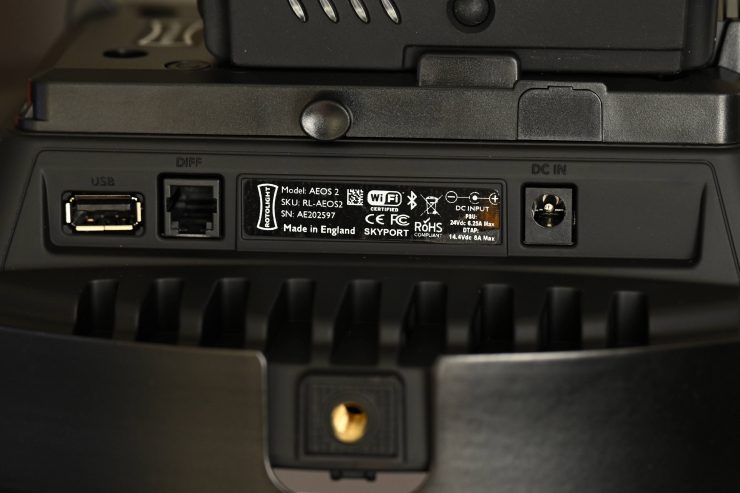
The AEOS 2 PRO has an Ethernet port, a Flash Sync Port, and a USB input for firmware updates.
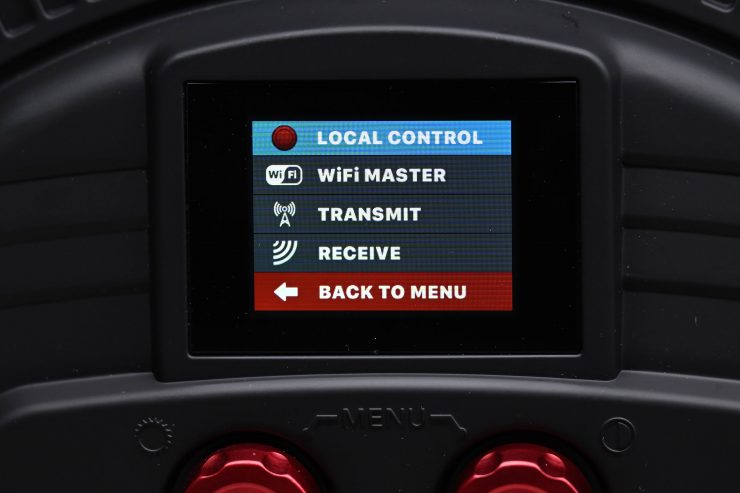
There is WI-FI & Bluetooth via iOS & Android app and you can use the fixture as a transmitter or receiver for HSS flash.
Beam Angle
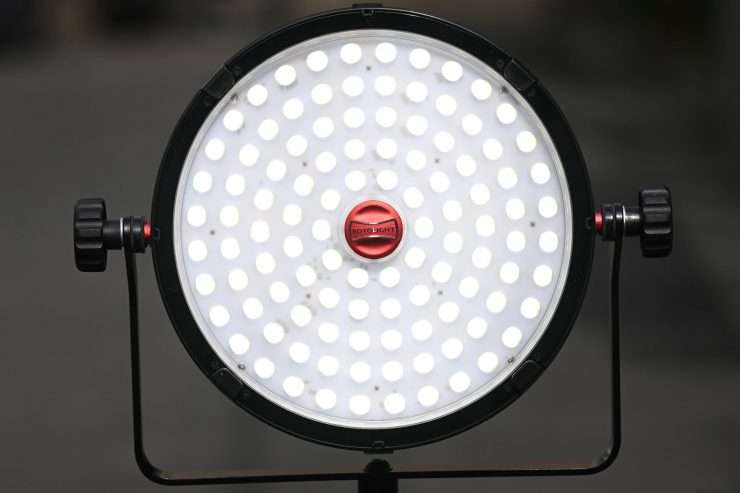
The AEOS 2 PRO has a pretty tight beam angle of 50 degrees. Tight beam angles can be found on quite a few 1×1 RGBW lights.
Below you can see what the beam angle is of other 1×1 or similar-sized lights:
| BEAM ANGLE | |
| Rotolight AEOS 2 PRO | 50° |
| Litepanels Gemini 1 x 1 RGBWW LED Hard | 46° |
| Luxli Timpani² 1×1 RGBAW LED Light | 78° |
| Z CAM ZOLAR Vega 30C RGBAW | 90° |
| Aputure Nova P300c RGBWW | 120° |
| Rotolight Titan X1 RGBWW | 68° to 150° |
| Lupo Superpanel Full Color 30 RGBWW | 40° |
| Lupo Superpanel Soft Full Color 30 1×1 RGBW | 115° |
| Creamsource Vortex4 1×1 RGBW | 20° |
As you can see, the beam angle of some other 1×1 style RGBWW fixtures varies dramatically.
Is there a need for two different models?
I am going to play the Devil’s advocate for a second here because a lot of people will probably be asking, why make two versions of the same fixture? If you already bought an AEOS 2 you might be thinking, hold on, why didn’t Rotolight just improve my fixture via a firmware update instead of creating another light? That is a valid question and I can certainly see why some owners of the AEOS 2 may feel that way.
While a lot of the new features and functionality in the AEOS 2 PRO are probably just software, the ability for the light to now work with a variety of wireless flash transmitters may have presumably required some sort of new hardware.
In my perspective, there is nothing wrong with having two models, but I still question why two models were made that are essentially the same fixture, with a few minor changes.
What I will argue, and this is just my personal opinion, is that by designating a product PRO you undermine the existing AEOS 2, because suddenly is that not PRO anymore? Of course not, but that is the impression you give potential customers.
Photometrics
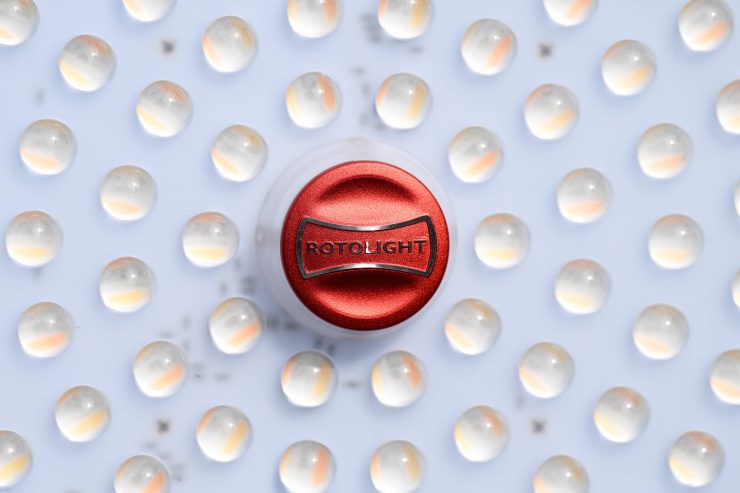
So now let’s get to the photometric results. I always test lights in this way so that I get a reference to how they compare to other fixtures. Results only tell part of the story and should never be used alone to judge a light. I have found from extensive testing over the years that certain lights that have good photometric results don’t always look good, and lights that have worse photometric scores can sometimes look better than their results indicate. It is important that you don’t judge a light from one individual result. You have to gather all the data to make a comprehensive conclusion.
Different lights can also look different depending on what camera you happen to be using.
Output & Color Temperature Accuracy
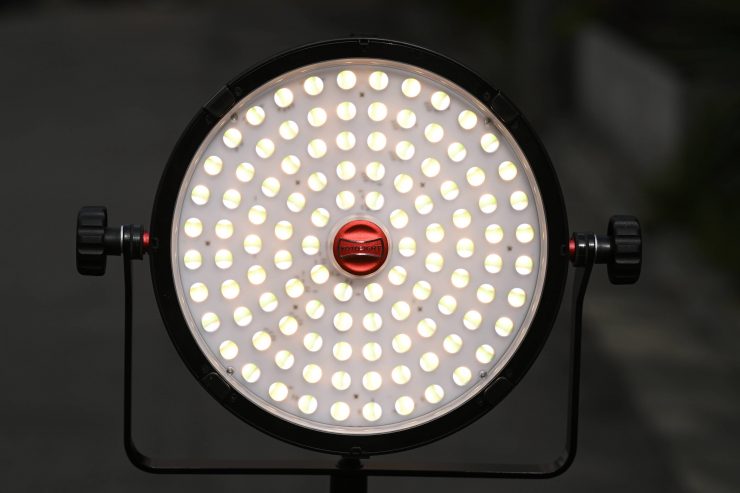
I tested the Rotolight AEOS 2 PRO at a variety of Kelvin color temperatures with a Sekonic C-800 Spectrometer to find out how much output the light had and how accurate the Kelvin color temperature reproduction was.
All readings are taken at a distance of 1m (3.28ft) in a controlled environment. The readings were all done with the light in its Max Lux mode and with the fan set to Auto.
The most output I could obtain was when I measured the light at 4700K where it produced 8120 lx. This was lower than Rotolight’s claim of the light having a maximum output of 9230 lx.
Below you can see recorded results at a variety of CCT temperatures.
5600K (no diffusion dome)
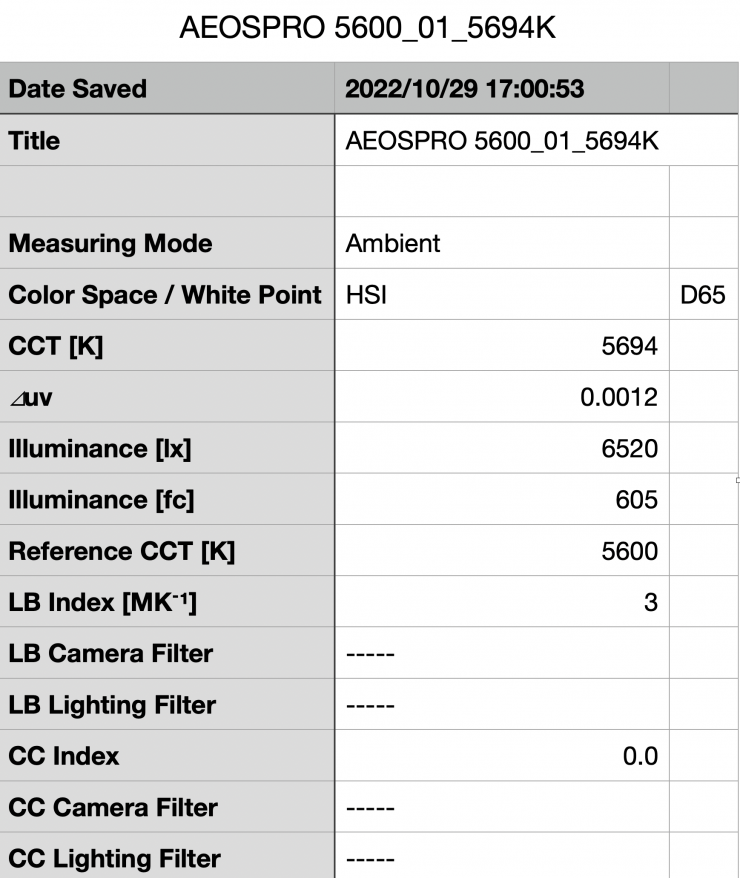
Above you can see the AEOS 2 PRO when set at 5600K recorded an output of 6520 lx (605 fc) when set at 5600K. As a comparison, the Rotolight AEOS 2 had an output of 7060 lx (655 fc). This was a little strange considering the PRO version is claimed to be brighter by up to 25%.
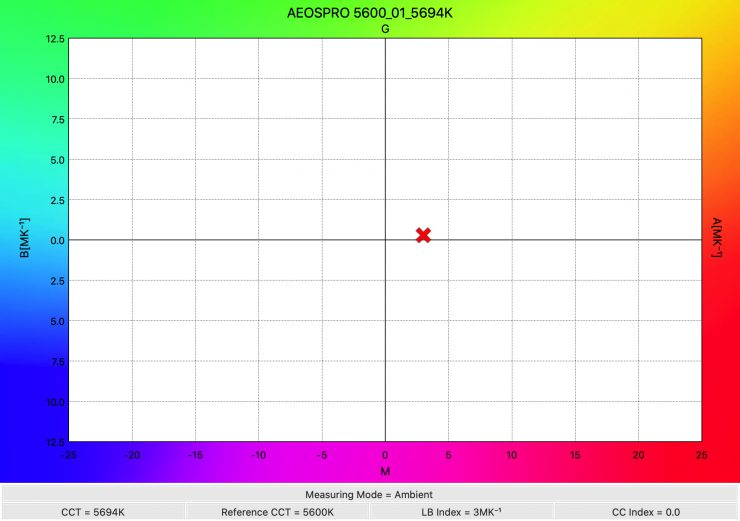
The light recorded a CCT reading of 5694K which was reasonably accurate. As a reference, the original Rotolight AEOS 2 recorded a figure of 5674K.
So, how does the output at 5600K compare to some other 1×1 style RGBW lights that I previously reviewed? Well, let’s see.
| OUTPUT | |
| Rotolight AEOS 2 PRO | 6520 lx |
| Litepanels Gemini 1 x 1 RGBWW LED Hard | 15700 lx |
| Luxli Timpani² 1×1 RGBAW LED Light | 6260 lx |
| Z CAM ZOLAR Vega 30C RGBAW | 7870 lx |
| Aputure Nova P300c RGBWW | 9600 lx |
| Rotolight Titan X1 RGBWW | 8210 lx |
| Lupo Superpanel Full Color 30 RGBWW | 16900 lx |
| Lupo Superpanel Soft Full Color 30 1×1 RGBW | 4380 lx |
The Rotolight AEOS 2 PRO has a decent amount of output, but it isn’t going to have as much output as a lot of the competition. However, it does draw quite a lot less power and it is significantly lighter than a lot of those fixtures. What you need to take into account when looking at the output of any light is what the beam angle is. Comparing different lights that have different beam angles and power draws is never an apples-to-apples comparison.
What you also clearly need to take into consideration, and this goes for any light with a decent amount of output, is that if a light doesn’t feature any type of diffusion it is not going to be suitable for lighting situations where talent needs to look towards its direction.
As far as an accurate rendition of creating a 5600K source here is how it compares to those other lights:
| CCT | |
| Rotolight AEOS 2 PRO | 5694K |
| Litepanels Gemini 1 x 1 RGBWW LED Hard | 5370K |
| Luxli Timpani² 1×1 RGBAW LED Light | 6171K |
| Z CAM ZOLAR Vega 30C RGBAW | 5571K |
| Aputure Nova P300c RGBWW | 5426K |
| Rotolight Titan X1 RGBWW | 5512K |
| Lupo Superpanel Full Color 30 RGBWW | 6322K |
| Lupo Superpanel Soft Full Color 30 1×1 RGBW | 5423K |
As you can see, the AEOS 2 PRO is reasonably CCT accurate at 5600K, and only just behind Rotolight’s own Titan X1, but it wasn’t quite as good as the Z CAM ZOLAR Vega 30C RGBAW. We shouldn’t jump to any conclusions just yet, we need to look at all of the data to come up with an accurate assessment of a light.
5600K (Diffusion Dome)
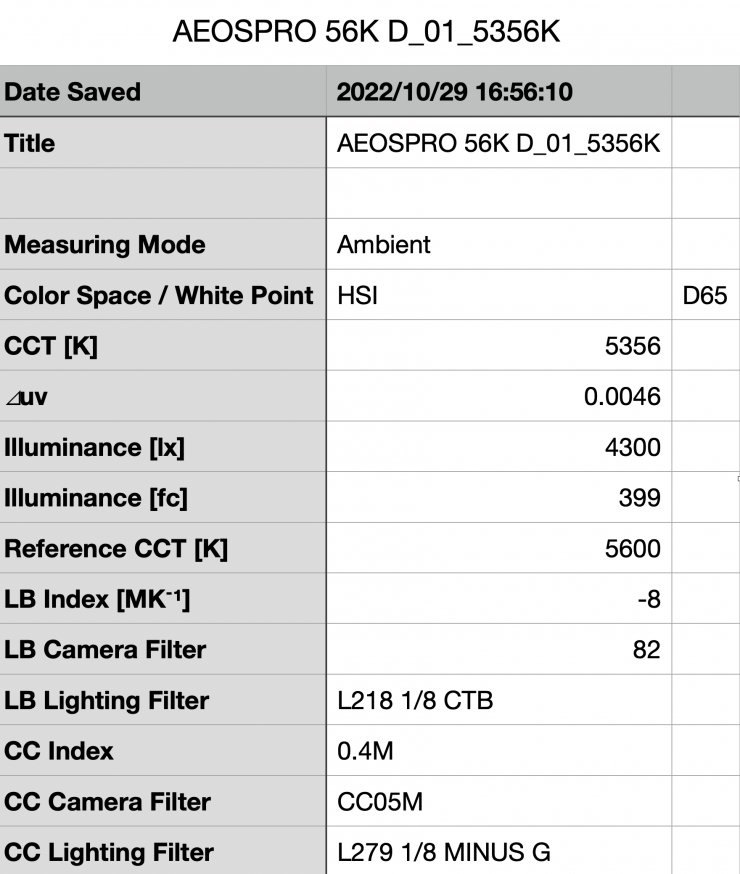
Above you can see the AEOS 2 PRO when set at 5600K with the diffusion dome attached recorded an output of 4300 lx (413 fc). This was 34% less than what it put out with the diffusion dome removed.
As a direct comparison, the AEOS 2 recorded an output of 4440 lx (413 fc).
As another comparison, the Lupo Superpanel Soft Full Color 30 1×1 RGBW which has a non-removable diffusion panel in front of it puts out 4380 lx. The Lupo has a beam spread of 115°, but I am not sure what the beam angle of the Rotolight is once you use it with the diffusion dome. You also need to factor in that the Rotolight draws 120W and the Lupo draws 200W.
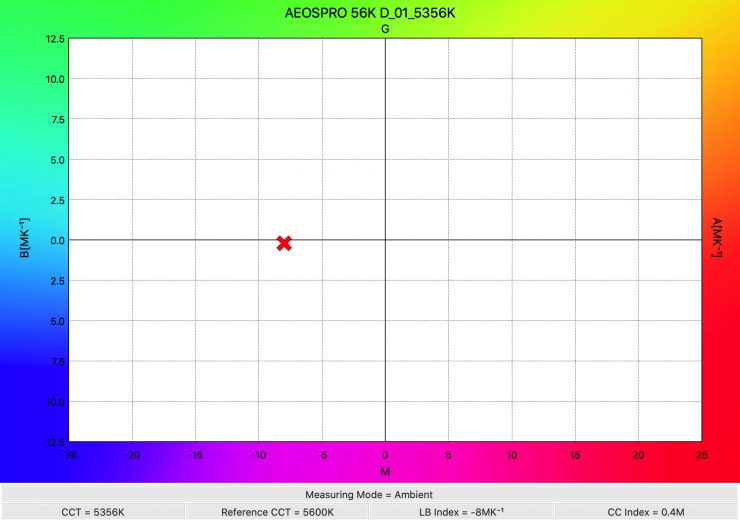
The light recorded a CCT reading of 5356K which was around 150K from being accurate. This clearly shows me that the diffusion dome is altering the CCT by a few hundred Kelvin.
3200K
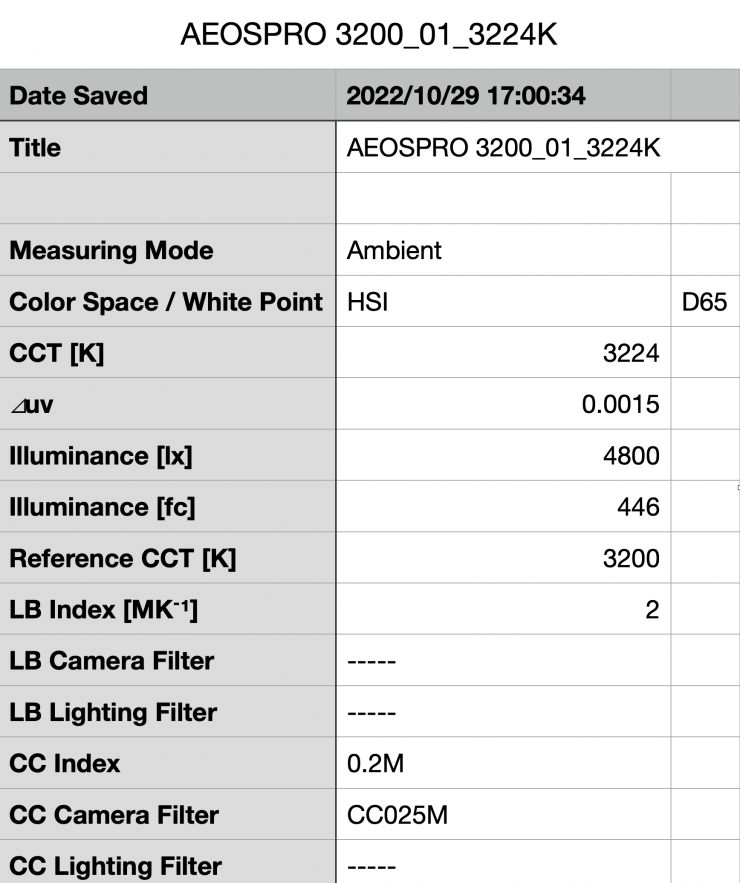
Above you can see the light’s output when it was set at 3200K. It produced 4800 lx (446 fc), which was 26.3% less than the 6520 lx it produced at 5600K. As a comparison, the AEOS 2 had an output of 4860 lx (452 fc).
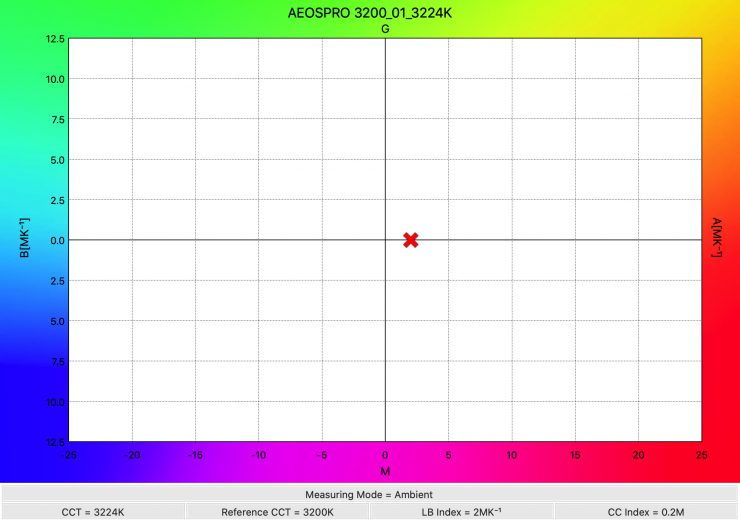
As far as CCT accuracy goes, it recorded a reading of 3224K. This was an excellent result.
So, how does the output at 3200K compare to some other 1×1 style RGBW lights that I previously reviewed? Well, let’s see.
| OUTPUT | |
| Rotolight AEOS 2 PRO | 4800 lx |
| Litepanels Gemini 1 x 1 RGBWW LED Hard | 12500 lx |
| Luxli Timpani² 1×1 RGBAW LED Light | 6290 lx |
| Z CAM ZOLAR Vega 30C RGBAW | 7820 lx |
| Aputure Nova P300c RGBWW | 8500 lx |
| Rotolight Titan X1 RGBWW | 8480 lx |
| Lupo Superpanel Full Color 30 RGBWW | 13900 lx |
| Lupo Superpanel Soft Full Color 30 1×1 RGBW | 4150 lx |
The Rotolight AEOS 2 PRO has a lot less output at 3200K than it has at 5600K. This is unlike lights like the Luxli Timpani² 1×1 RGBAW that has consistent output at all CCT settings.
As far as an accurate rendition of creating a 3200K source here is how it compares to those other lights:
| CCT | |
| Rotolight AEOS 2 PRO | 3224K |
| Litepanels Gemini 1 x 1 RGBWW LED Hard | 3145K |
| Luxli Timpani² 1×1 RGBAW | 3364K |
| Z CAM ZOLAR Vega 30C RGBAW | 3299K |
| Aputure Nova P300c RGBWW | 3087K |
| Rotolight Titan X1 RGBWW | 3150K |
| Lupo Superpanel Full Color 30 RGBWW | 3181K |
| Lupo Superpanel Soft Full Color 30 1×1 RGBW | 3065K |
As you can see, the AEOS 2 PRO has a very accurate CCT reading at 3200K and it was right up there with the best results I have seen.
3200K (Diffusion Dome)
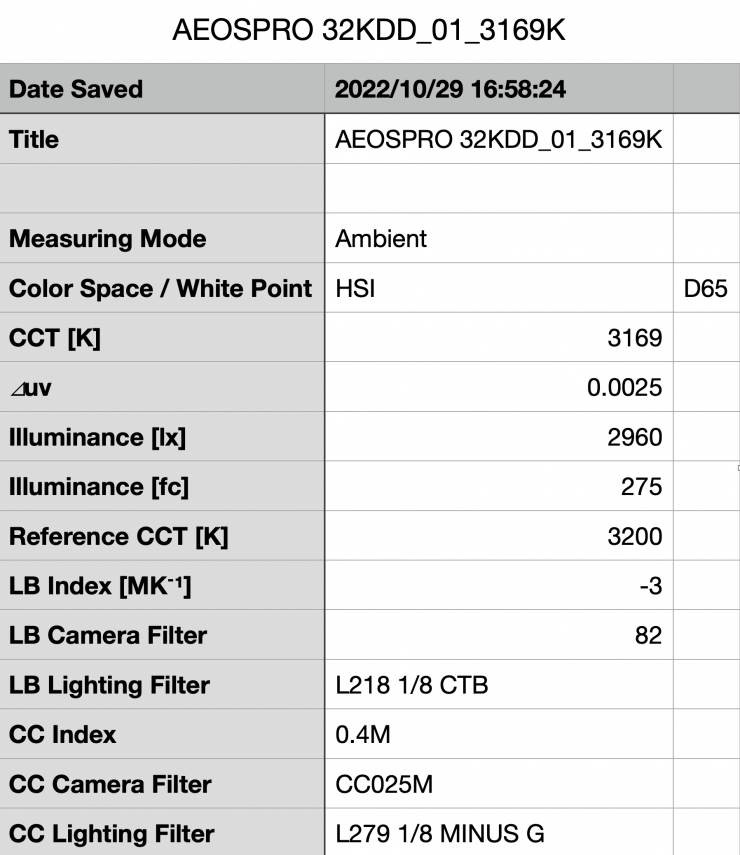
Above you can see the light’s output when it was set at 3200K and used with its diffusion dome. It produced 2960 lx (275 fc), which was 31.1% less than the 4300 lx it produced at 5600K.
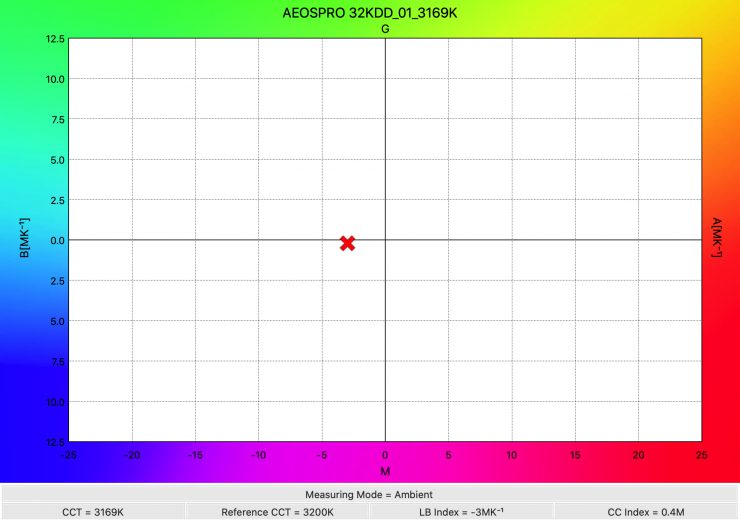
As far as CCT accuracy goes, it recorded a reading of 3169K. This was an excellent result.
How does it perform at various CCT Settings?
Summary of results (Diffusion dome used)
| SETTING | OUTPUT | CCT READING |
| 3000K | 2740 lx | 2989K |
| 3200K | 4300 lx | 3169K |
| 4500K | 4830 lx | 4400K |
| 5600K | 4300 lx | 5356K |
| 6500K | 3330 lx | 6204K |
| 8000K | 3120 lx | 7572K |
| 10000K | 3270 lx | 9704K |
These results show me that the light’s CCT is pretty consistent up to 4500K, but after that, it is a little off.
The AEOS 2 PRO’s output varies by a whopping 76.2% across the whole CCT range. You clearly need to be aware of this when using the light. It might be very bright in some CCT settings, but in others, it can be way less. I personally would have liked to have seen a bit more consistency across the CCT range even if it was at the expense of output.
Now, I reached out to Rotolight about this issue and they told me:
As with Titan, the AEOS 2 PRO features a selectable brightness mode control for “constant lux” or “max lux” mode in the system page, with Max Lux as factory default (as with both Titan’s). In Max lux mode, the Rotolight system extracts the maximum possible output from the LEDs at all times, at all color temperatures. This is significantly advantageous where raw power is critical and very useful in closed studio environments (and photographers wanting more power) where camera white balance can be set to match 4600K and therefore utilize all available power. To test peak lux output, please set the light to 4600 Kelvin “midpoint”, where both the warm and cool channels of the RGBWW chip at set to max power (as per the technical specifications).
In constant lux mode, the light will deliver an entirely consistent lux output across all power settings, at the expense of a raw performance peak at the midpoint.
By providing customers with the choice, you maximize the opportunities for users to get the most out of the light depending on their usage. Photographers would almost always prefer raw maximum output, whereas videographer/filmmakers may prefer totally consistent lux regardless of CCT.
Titan has always worked in this way with exactly the same performance characteristics and customers really appreciate the choice in our experience (in Titan system menu you’ll find the Brightness Mode > Constant Lux/ Max Lux ).
RGB Output
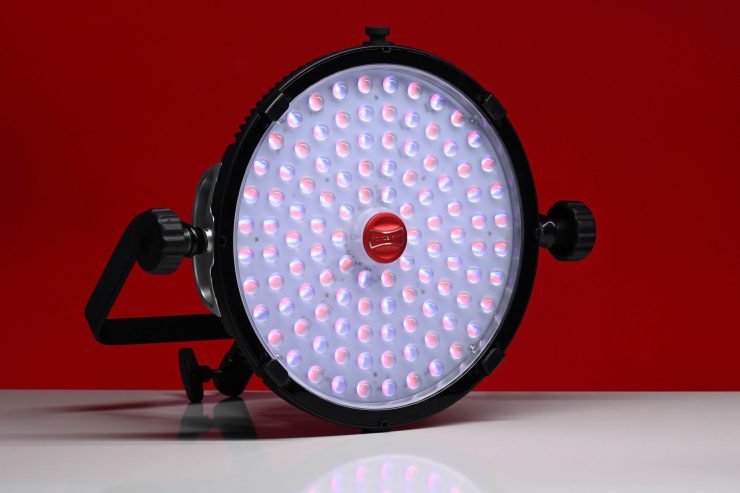
With most RGB lights if you use them to generate or create colors the output gets massively reduced. So how does the AEOS 2 PRO fare?
I decided to do a test to see how much output the light had when I created a super-saturated color.
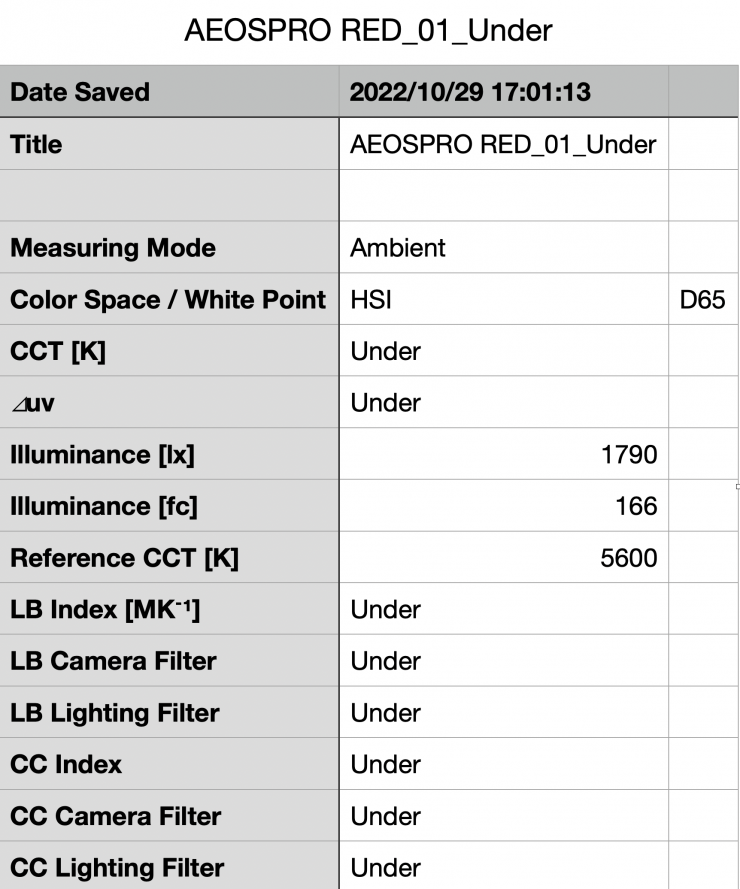
In the HSI mode, choosing a saturated red, and set to 100% output, the light recorded an output of 1790 lx / 166 fc. This is something you need to be clearly aware of when using the HSI mode. The output is going to be significantly lower than when using the light in CCT mode. In saying that, this is an impressive amount of output from a light of this size.

What I found is that the light was able to create a fairly accurate fully saturated RED.
Thoughts on output
While the AEOS 2 PRO has a decent amount of output for a light of its size with a power draw of 120W, from my testing I found that it didn’t produce more output than the AEOS 2. This was surprising, but the data doesn’t lie.
Color Rendering
5600K
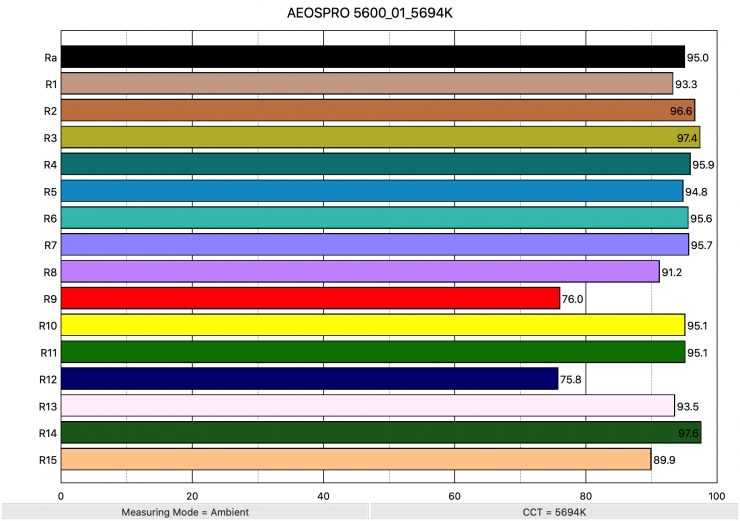
So now that we have seen how much output the AEOS 2 PRO produces, how does it perform when it comes to replicating accurate colors? Above you can see that when the light was set at 5600K it recorded an average CRI (R1-R8) of 95.0 and an extended CRI (R1-R15) of 92.24. For replicating accurate skin tones it recorded for R9 76.0 (red), 93.5 for R13 (closest to caucasian skin tones), and 88.9 for R15 (closest to Asian skin tones). These were not bad results, but I expected to see higher scores. The scores for R9 (Red) and R12 (Blue) were both below 80.
As a comparison, the AEOS 2 recorded an average CRI (R1-R8) of 96.0 and an extended CRI (R1-R15) of 93.29. For replicating accurate skin tones it recorded for R9 79.5 (red), 95.4 for R13 (closest to caucasian skin tones), and 91.7 for R15 (closest to Asian skin tones). These were not bad results, but I expected to see slightly higher scores. The score for R9 (Red) was below 80, as was the score for R12 (Blue).
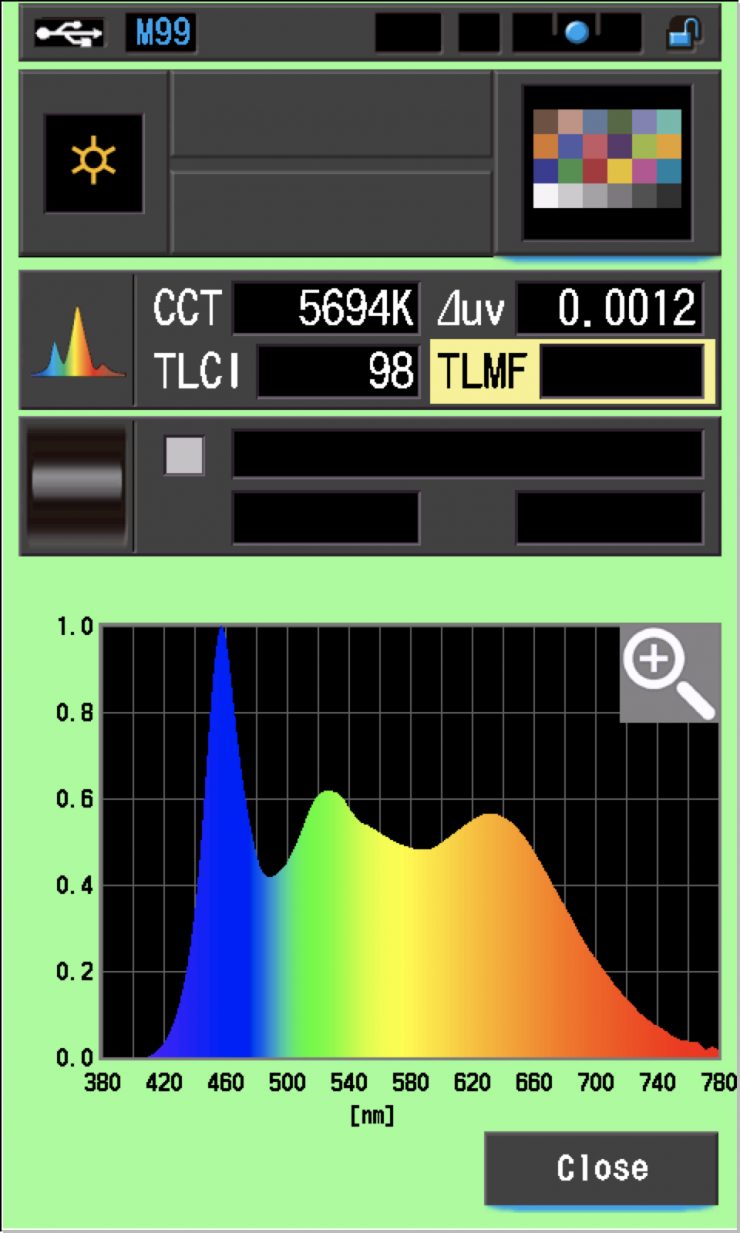
The light, when set at 5600K, recorded a TLCI score of 98.
How does this compare to some other RGBW 1×1 style lights that we have previously reviewed when used at 5600K? Below you can see:
| EXTENDED CRI | |
| Rotolight AEOS 2 PRO | 92.24 |
| Litepanels Gemini 1 x 1 RGBWW LED Hard | 96.52 |
| Luxli Timpani² 1×1 RGBAW LED Light | 94.70 |
| Z CAM ZOLAR Vega 30C RGBAW | 96.60 |
| Aputure Nova P300c RGBWW | 95.34 |
| Rotolight Titan X1 RGBWW | 95.44 |
| Lupo Superpanel Full Color 30 RGBWW | 93.59 |
| Lupo Superpanel Soft Full Color 30 1×1 RGBW | 93.4 |
The scores from the AEOS 2 PRO were not quite as good as some of the competition, however, any score in the 90s is good for a LED light.
3200K
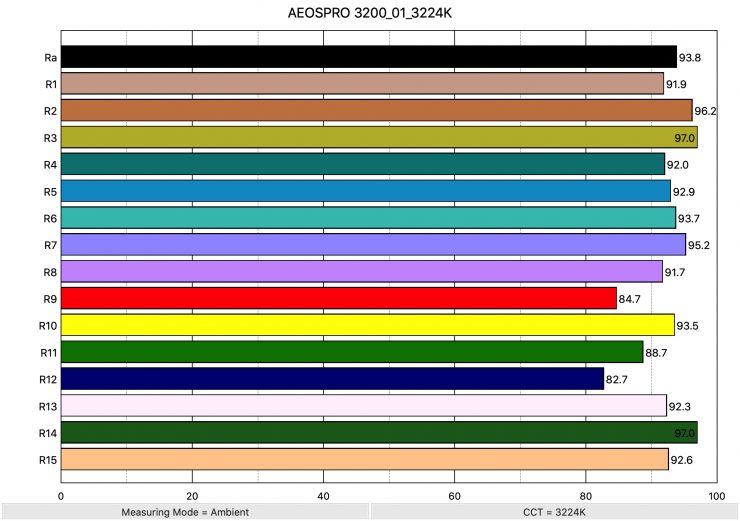
Above you can see the scores for when the light was used at 3200K. It recorded an average CRI (R1-R8) of 93.8 and an extended CRI (R1-R15) of 92.13. For replicating accurate skin tones it recorded 84.7 for R9 (red), 92.3 for R13 (closest to caucasian skin tones), and 92.6 for R15 (closest to Asian skin tones). The light had three Ra values under 90.
These results weren’t as good as when the light was used at 5600K.
As a comparison, the AEOS 2 recorded an average CRI (R1-R8) of 93.3 and an extended CRI (R1-R15) of 91.28. For replicating accurate skin tones it recorded 81.1 for R9 (red), 91.3 for R13 (closest to caucasian skin tones), and 91.3 for R15 (closest to Asian skin tones).
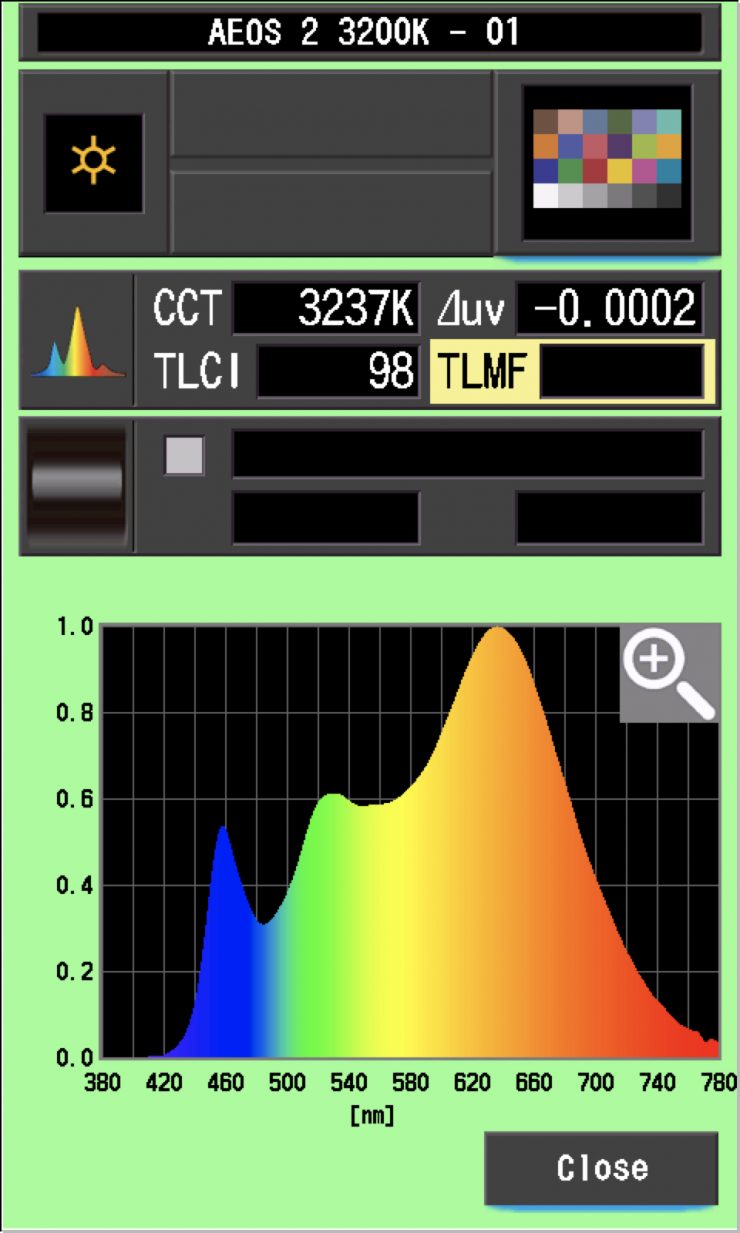
The light, when set at 3200K, recorded a TLCI score of 98.
How does this compare to other similar lights when used at 3200K? Below you can see:
| EXTENDED CRI | |
| Rotolight AEOS 2 | 92.13 |
| Litepanels Gemini 1 x 1 RGBWW LED Hard | 93.22 |
| Luxli Timpani² 1×1 RGBAW LED Light | 96.90 |
| Z CAM ZOLAR Vega 30C RGBAW | 94.68 |
| Aputure Nova P300c RGBWW | 95.64 |
| Rotolight Titan X1 RGBWW | 91.83 |
| Lupo Superpanel Full Color 30 RGBWW | 90.7 |
| Lupo Superpanel Soft Full Color 30 1×1 RGBW | 91.86 |
It was interesting to see that the AEOS 2 PRO had almost an identical score to the Titan X1. This makes sense as both lights are supposed to be using the same LEDs and light engine. The score of 92.13 was decent, but it wasn’t as good as the Luxli Timpani² 1×1 RGBAW, Z CAM ZOLAR Vega 30C RGBAW, or Aputure Nova P300c RGBWW.
Thoughts
The Rotolight AEOS 2 Pro recorded pretty good results, however, the scores weren’t as high as most of the other similar lights that I have tested. Now, we shouldn’t jump to conclusions and we still need to consider a lot more factors.
CC Index & ⊿uv
The CC Index displays the CC correction value and whether any magenta or green need to be added or subtracted. 1 CC corresponds to 035 Kodak CC values or 1/8 Rosco filter values. Any reading less than +1.00 or -1.00 and you’re probably not going to need to make any kind of adjustment. The ⊿uv is the value to show how much this light is away from being an ideal light source (black body radiation = incandescent lamp). As with the CC Index you want this number to theoretically be zero. Kelvin is not a linear value, so we need to convert from Kelvin to MK-1 to compare the values of color temperature. To calculate from Kelvin to Mired is MK-1= 1*1000000/Kelvin. While this may sound confusing, it is the only way of measuring if the Kelvin shift is significant enough to warrant having to use a filter for correction. Below are the results for the AEOS 2 PRO:
Kelvin Vs MK-1
| Kelvin | Difference in K | MK-1 | Difference in MK-1 | |
| SET VALUE | 3000K | 0 | 333.33 | 0 |
| ACTUAL READING | 2984K | 16 | 335.12 | -1.79 MK-1 |
| SET VALUE | 3200K | 0 | 312.50 | 0 |
| ACTUAL READING | 3169K | 31 | 315.55 | -3.05 MK-1 |
| SET VALUE | 4500K | 0 | 222.22 | 0 |
| ACTUAL READING | 4400K | 100 | 227.27 | -5.05 MK-1 |
| SET VALUE | 5600K | 0 | 178.57 | 0 |
| ACTUAL READING | 5356K | 244 | 186.70 | -8.13 MK-1 |
| SET VALUE | 6500K | 0 | 153.85 | 0 |
| ACTUAL READING | 6204K | 296 | 161.18 | -7.33 MK-1 |
| SET VALUE | 8000K | 0 | 125 | 0 |
| ACTUAL READING | 7572K | 428 | 132.06 | -7.06 MK-1 |
| SET VALUE | 10000K | 0 | 100 | 0 |
| ACTUAL READING | 9704K | 296 | 103.05 | -3.05 MK-1 |
These figures might look confusing, but what it tells me is that the light is reasonably CCT accurate across its range. Any MK-1 score of -/+6 or under is considered to be very good.
CC INDEX & ⊿uv
| CC INDEX | ⊿uv | |
| 3000K | 0.3M | 0.0027 |
| 3200K | 0.4M | 0.0025 |
| 4500K | 0.3M | 0.0026 |
| 5600K | 0.4M | 0.0046 |
| 6500K | 0.0 | 0.0026 |
| 8000K | 0.2G | 0.0022 |
| 10000K | 0.7G | 0.0017 |
The ⊿uv scores were reasonable for this light, but they weren’t as good at the AEOS 2, which again, surprised me. The CC index readings were ok.
TM-30
TM-30 is a relatively new color rendering standard that was developed to deal with the limitations of CRI. TM-30 looks at 99 individual colors. These 99 colors are categorized into seven groups: nature, skin color, textiles, paints, plastics, printed material, and color systems.
TM-30 scores go from 0 – 100. The higher the score, the more accurate a light is at producing colors. Any TM-30 Rf score in the ’90s is considered to be good. What is interesting and something that you need to be very aware of is that two separate light sources with the exact same CRI scores can render colors very differently. A light with a high CRI rating could have a low TM-30 score. Conversely, a light with a good TM-30 score could have a bad CRI score.
Now, there are two measurements associated with TM-30, Rf and Rg.
- Rf (Color Fidelity)
- Rg (Color Gamut)
With Rf value, ideally, you want a score in the 90’s.
With Rg value, a score below 100 indicates that the light source renders colors with less saturation than the reference source. So ideally you want this score to be above 100.
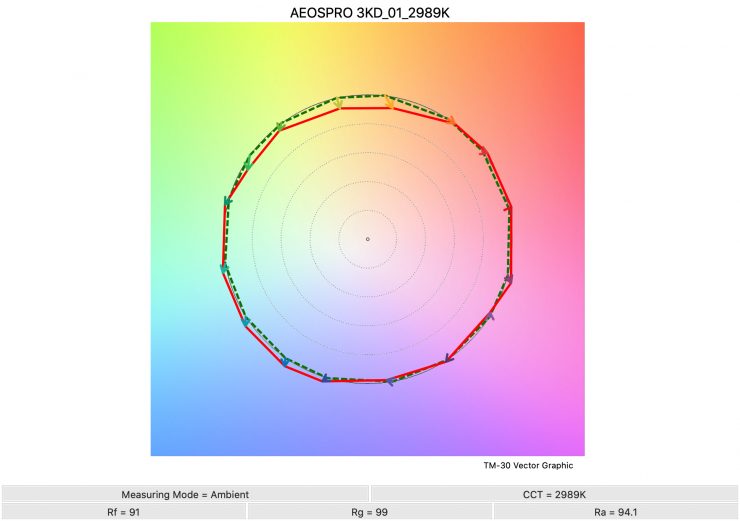
3000K 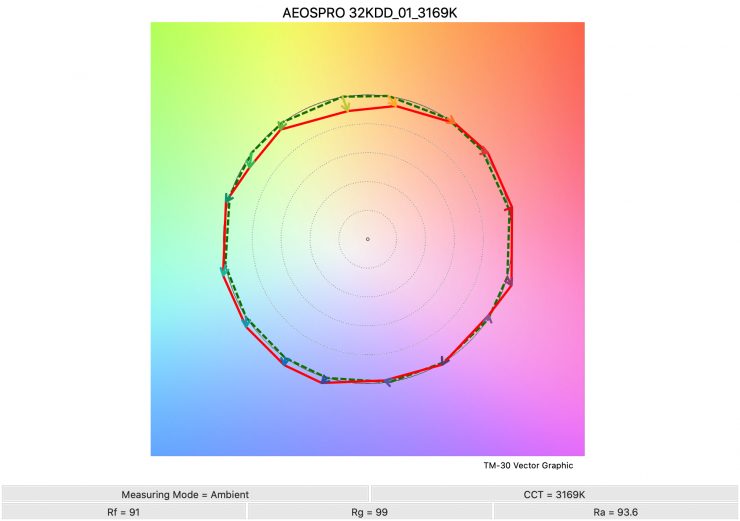
3200K 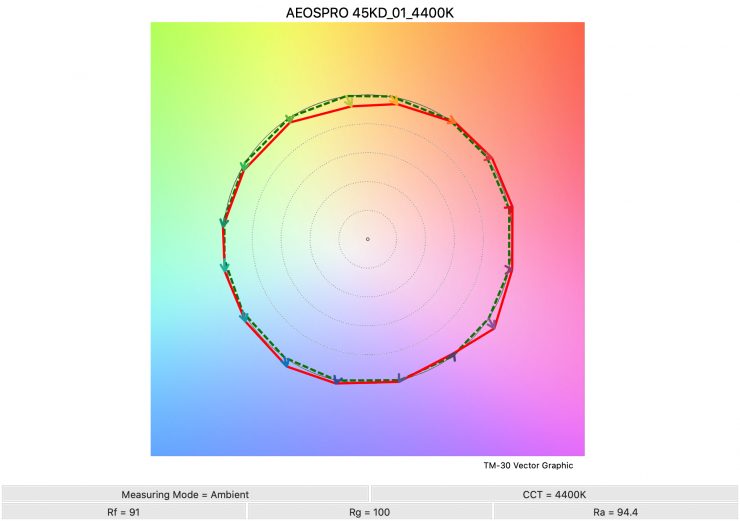
4500K 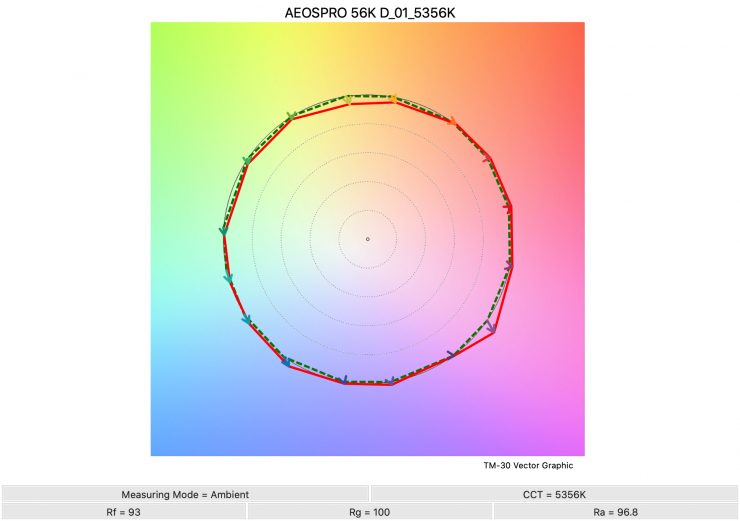
5600K 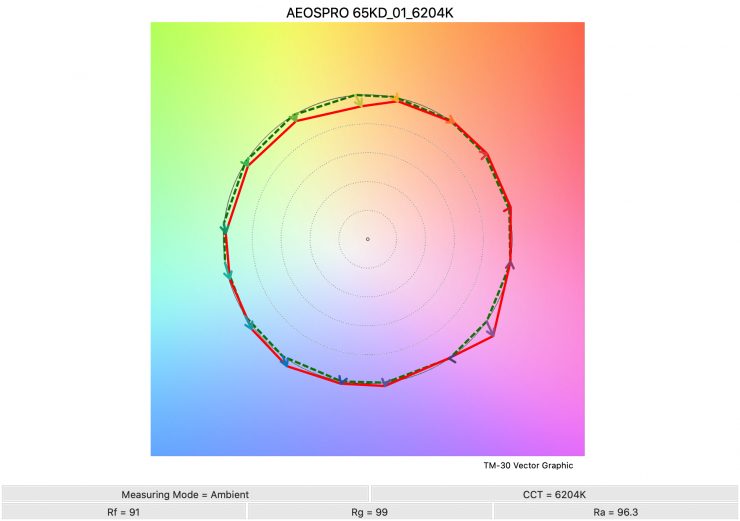
6500K 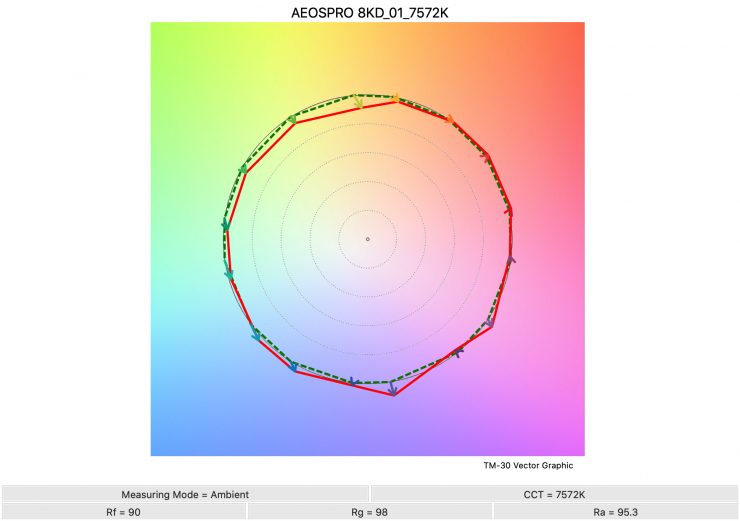
8000K 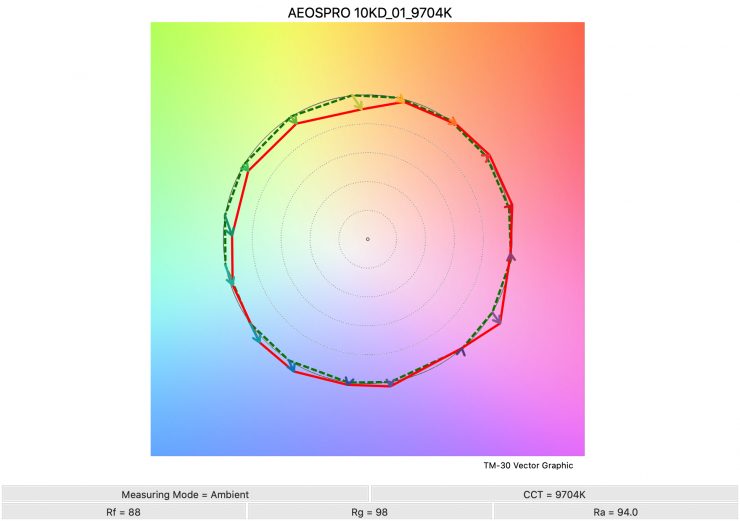
10000K
Above you can see the scores for the AEOS 2 PRO at various CCT settings.
Here are the results:
| Rf | Rg | |
| 3000K | 91 | 99 |
| 3200K | 91 | 99 |
| 4500K | 91 | 100 |
| 5600K | 93 | 100 |
| 6500K | 91 | 99 |
| 8000K | 90 | 98 |
| 10000K | 88 | 98 |
The results were reasonably good, but the light only managed to achieve 100 for Rg for 4500K and 5600K.
SSI
SSI (Spectral Similarity Index) was developed by the Sci-Tech Council of the Academy. SSI gives me the ability to set any light as a standard, or use predefined standards (such as CIE D55), and then give other lights an SSI score based upon how well they will match standards such as CIE D55. This way I can measure spectral response and compare it directly against an ideal light source. This is actually a much better test than recording CRI scores.
3200K
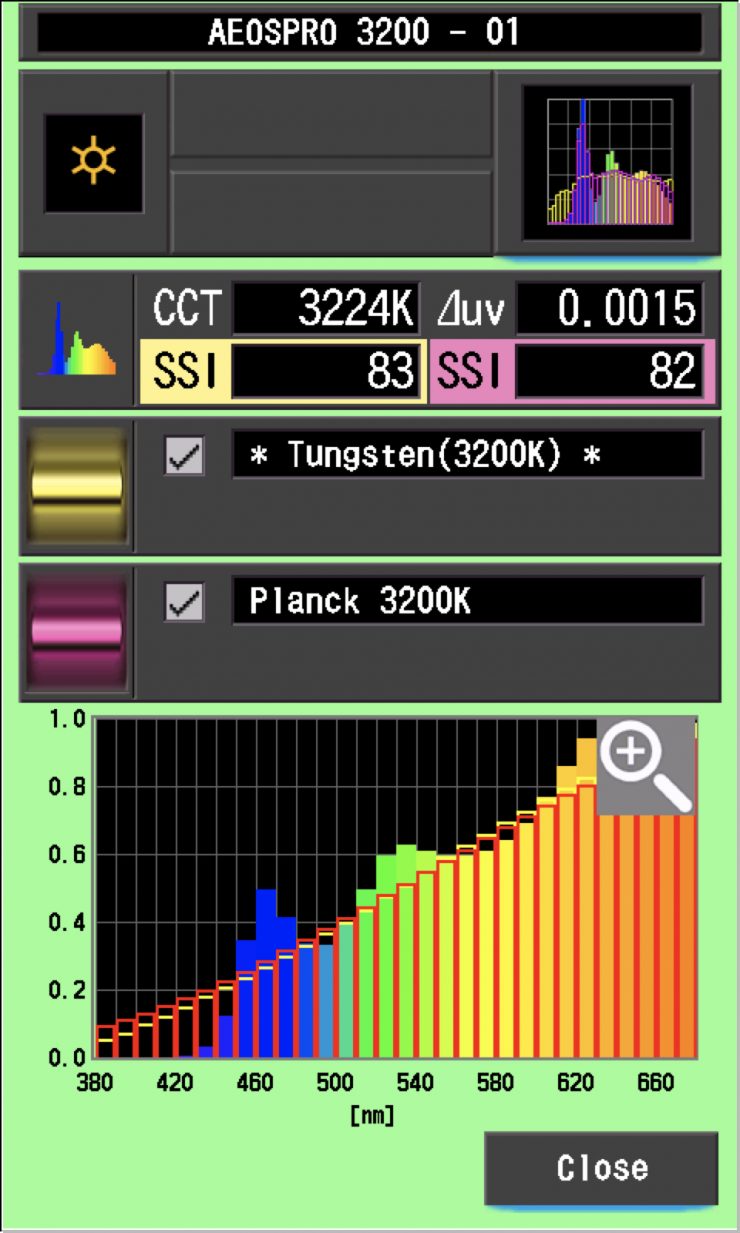
In this graph, the red bars indicate a perfect Planck 3200K source. The gold bars indicate a perfect 3200K Tungsten source. This lets us compare how close to a perfect 3200K lighting source the AEOS 2 PRO is. Any SSI score in the low ’80s is very good for a 3200K LED light. As you can see, LED lights have a hard time replicating colors below about 450nm.
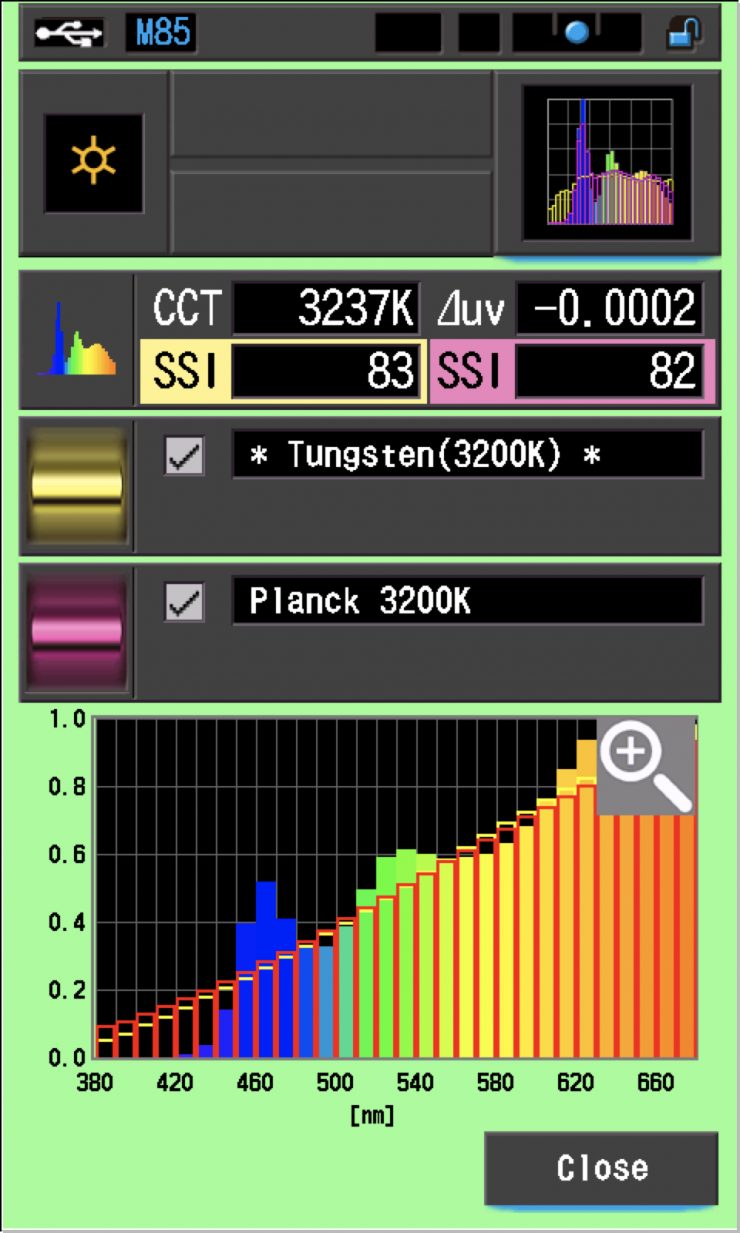
As a comparison, above you can see the results for the AEOS 2. It is no real surprise that both the AEOS 2 and the AEOS 2 PRO had the exact same scores
5600K
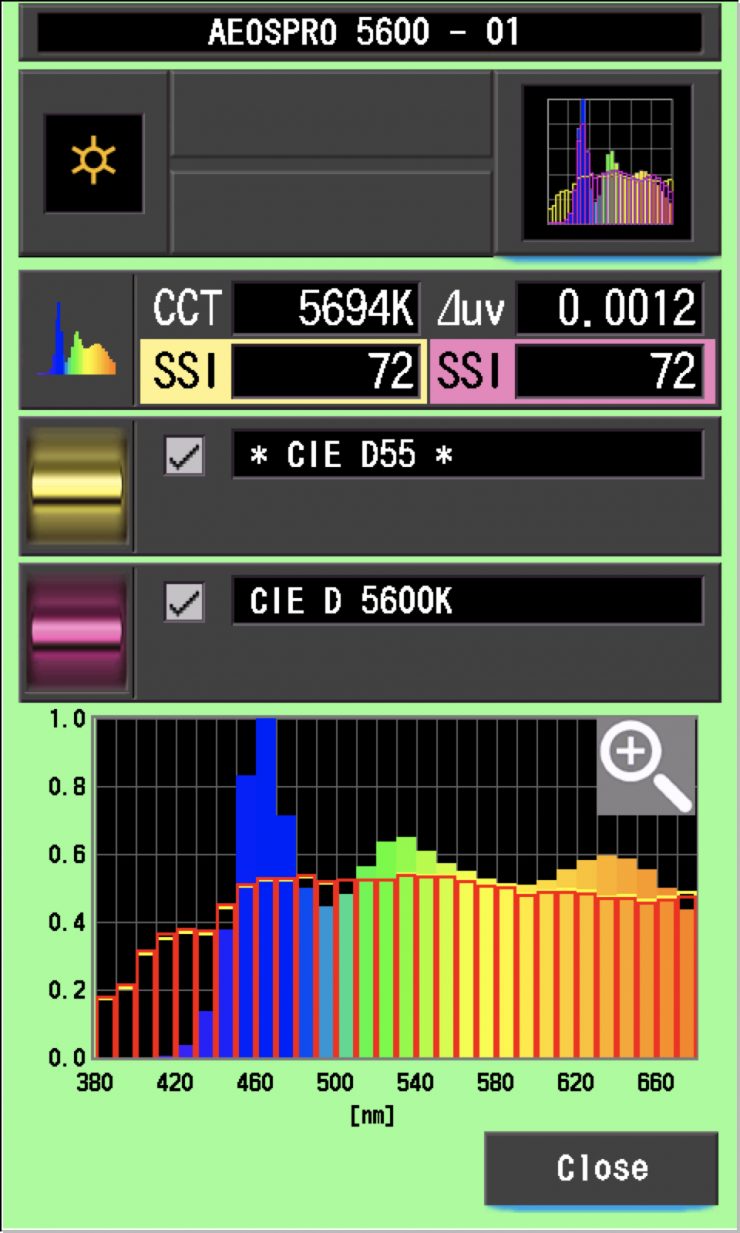
In the graph above the gold bars indicate a perfect CIE D55 source. The red bars indicate a perfect CIE D 5600K source. A score in the low to mid 70’s is good for a 5600K LED source. The AEOS 2 scored 71.
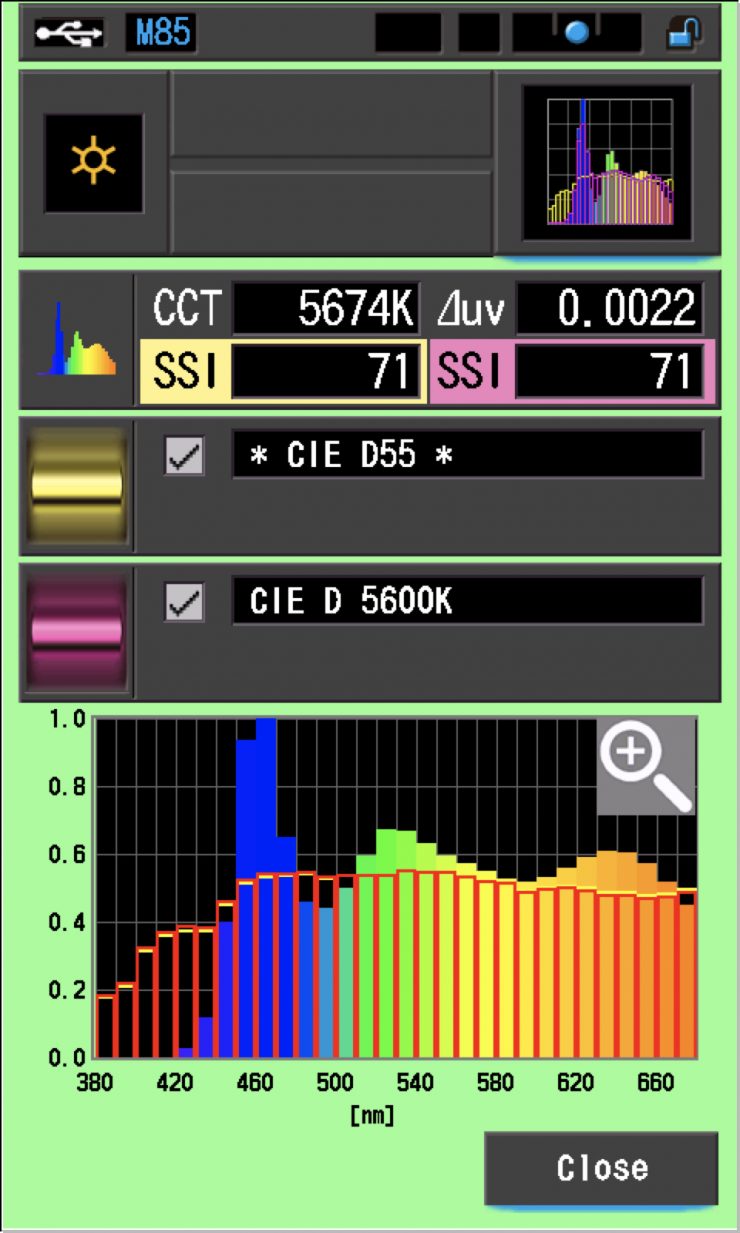
As a comparison, above you can see the results for the AEOS 2.
The main reason we want to record SSI scores is so we can see how well they match with other lights. As an example, let’s see how well it matches with a Z CAM ZOLAR Vega 30C RGBAW and an Aputure LS 600c Pro. Above you can see the results at 3200K and 5600K. As you can see, the AEOS 2 PRO was an ok match with the Aputure, but not as good of a match with the Z CAM.
SSI tests are a great way of telling you what lights you own or use will work well together.
Spectral Distribution
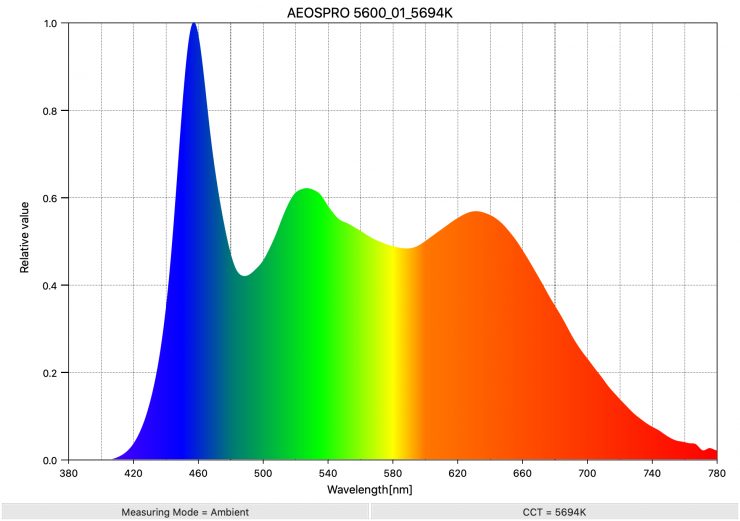
Above you can see the spectral distribution of the AEOS 2 PRO when it is set at 5600K. The spectral distribution is not overly linear and you can see spikes about 520nm and 640nm.
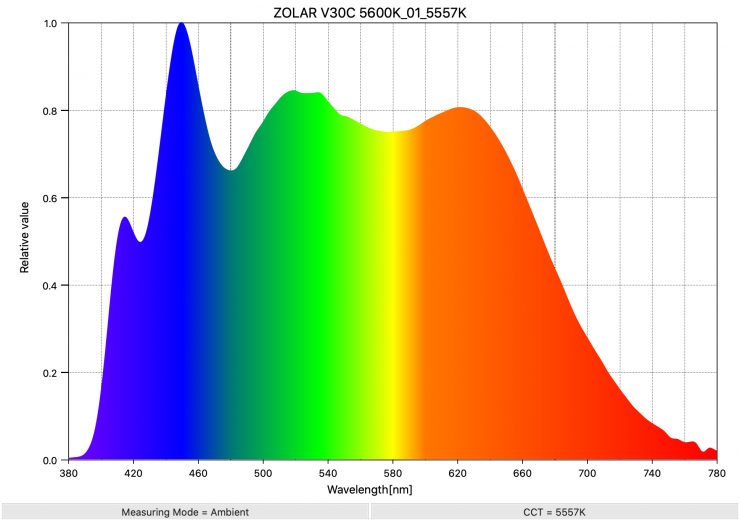
As a comparison, above is the spectral response for the Z CAM ZOLAR VEGA 30C RGBAW.
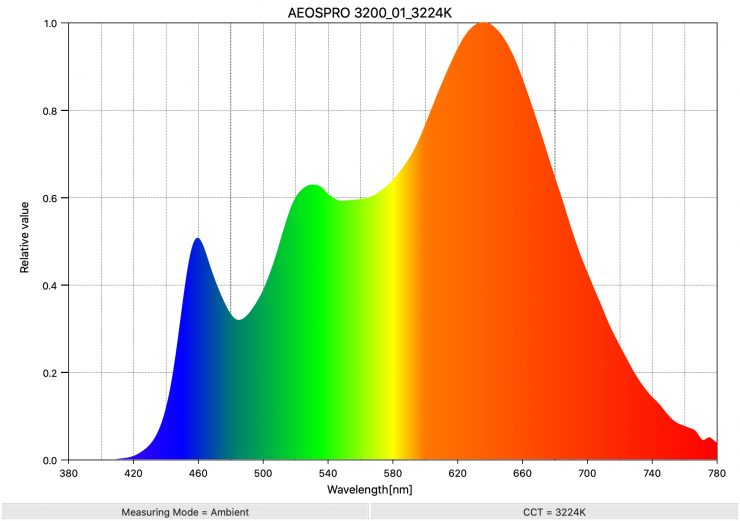
Above you can see the spectral distribution of the AEOS 2 PRO when it is set at 3200K. The spectral distribution is reasonably full but there is a small push toward green.
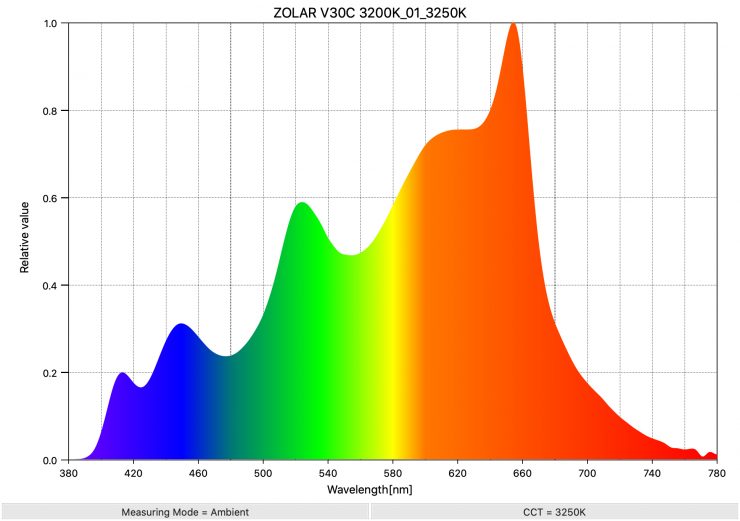
As a comparison, above is the spectral response for the Z CAM ZOLAR VEGA 30C RGBAW.
Real-World Performance & Quality of Light
As I always say, photometric scores only tell you part of the story. So do the scores from the AEOS 2 PRO translate into real-world performance? The photometric data can only give me scientific data and it is much more important for me to see how the light actually looks and performs.
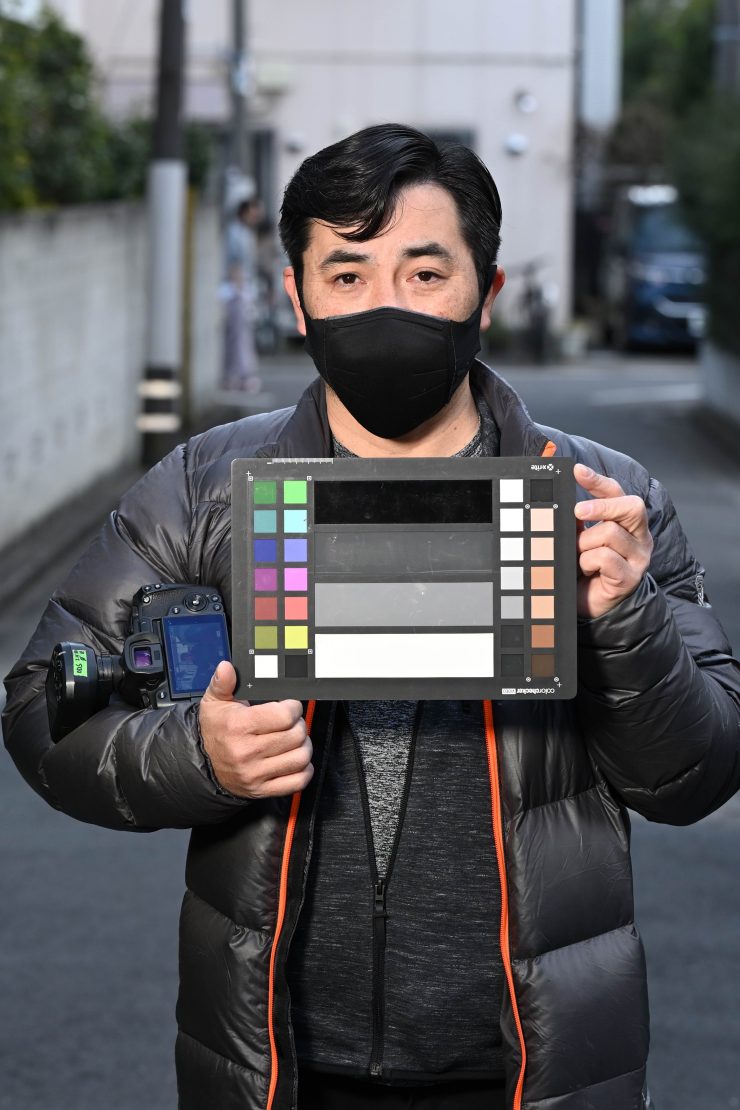
The light can be made to look quite soft, but again, anytime you diffuse a lighting source you are going to lose a lot of output.
Despite having a decent amount of output, a single AEOS 2 PRO isn’t going to help you match a very bright background if you are using it outdoors, however, that is the case for quite a few 1×1 style lights. The other issue when using this light or any other light that doesn’t have diffusion is that it is very hard for talent to look towards it. The light really needs to be positioned so that it isn’t in the direct eye line of talent because they won’t be able to look towards it. In most cases, if you are lighting talent for a live cross, etc. and you only have access to 1×1 style lights, it is best to use two lights coming in on angles so you don’t blind your talent.
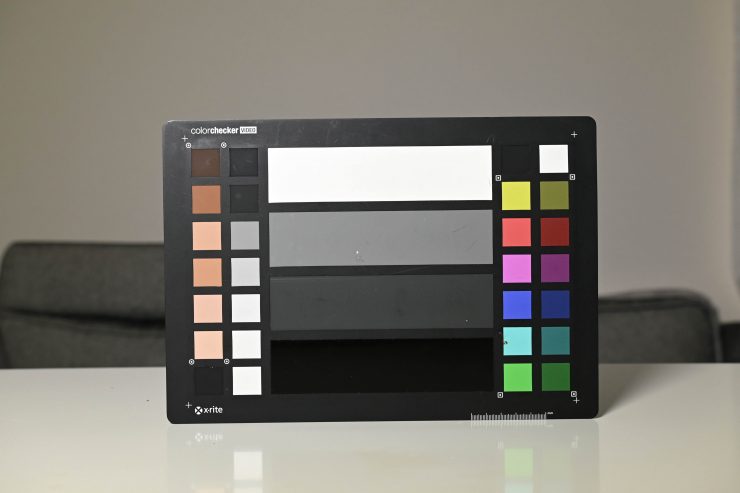
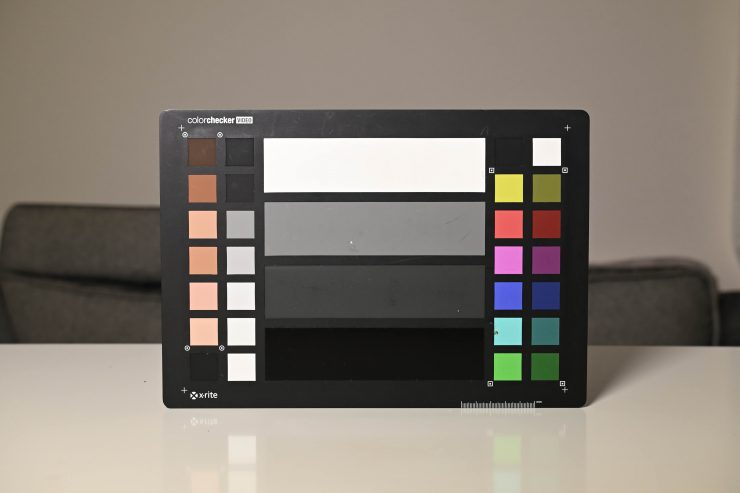
Above you can see a color checker chart that I shot using the AEOS 2 PRO as the lighting source. I preset the camera’s WB to 5600K to see what the colors looked like with the light set at 5600K and then I did a WB on the camera to see how much it changed. As you can see there isn’t a massive difference between the two images, however, once I did a manual WB the image did become a little warmer.
If you don’t diffuse it you will get cross-hatched shadows if the object you are illuminating to too close to something else. In most instances, you probably won’t be doing this with a light, but it is important that you are aware of it.
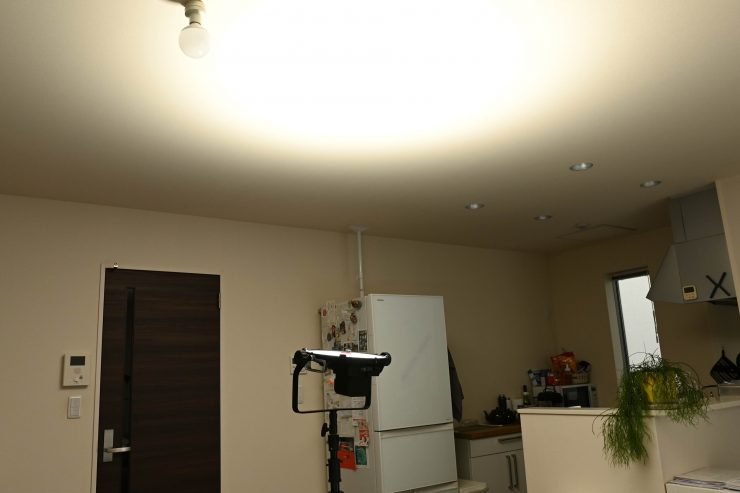
Light On 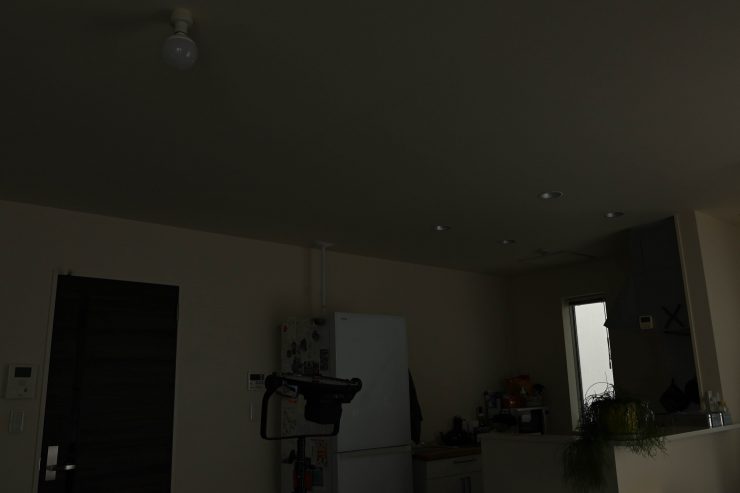
Light Off
Above you can see how much output it produces if I punch the light directly into a ceiling. There is also a comparison image with the light turned off where the camera settings remain the same.
The AEOS 2 PRO has a good amount of output considering its size and power draw. It is solidly made and easy to use and operate. The color rendering and CCT accuracy are reasonably good, but not as good as some of the competition.
Having RGBWW capabilities, digital filters, and special effects is nice, but most users will just want to create really nice white light, and that is something the AEOS 2 PRO can certainly do.
Firmware Updatable
Like a lot of today’s lights, the AEOS 2 PRO is fully firmware upgradeable. Above you can see a video that shows you how to do the update. This video is for the AEOS 2, but it is exactly the same process for the AEOS 2 PRO.
Competition
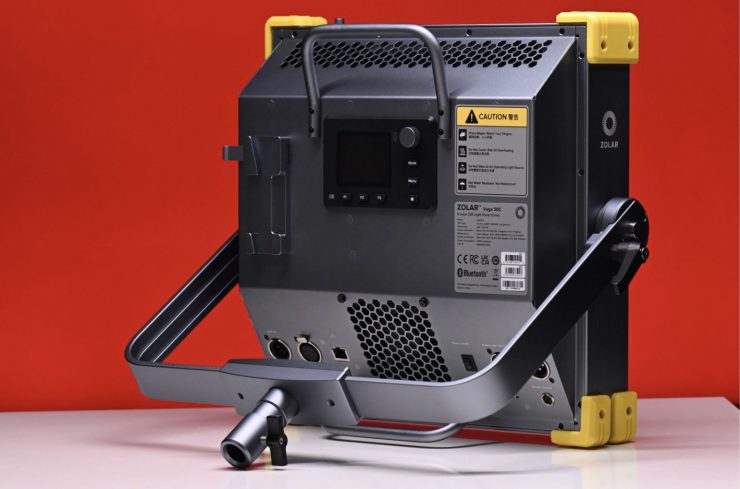
The main competition for the Rotolight AEOS 2 PRO arguably comes in the form of lights such as:
- Litepanels Gemini 1 x 1 RGBWW LED Hard
- Luxli Timpani² 1×1 RGBAW LED Light
- Z CAM ZOLAR Vega 30C RGBAW
- Aputure Nova P300c RGBWW
- Rotolight Titan X1 RGBWW
- Lupo Superpanel Full Color 30 RGBWW
- Lupo Superpanel Soft Full Color 30 1×1 RGBW
All of these lights have their strengths and weaknesses. It is important to note that a lot of these competing lights are actually the same light that has just been rebranded under a different name.
The closest direct competitors, at least in my opinion are the Luxli Timpani² 1×1 RGBAW LED Light, Z CAM ZOLAR Vega 30C RGBAW, and the Lupo Superpanel Full Color 30 RGBWW.
Price & Availability
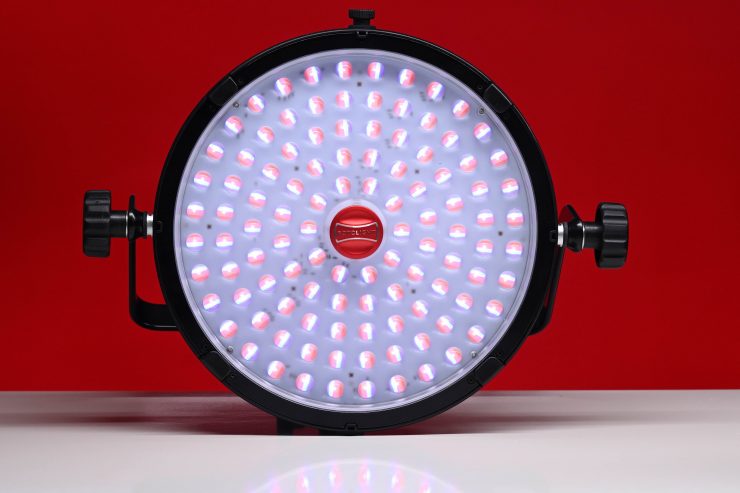
Below are the prices for the various AEOS 2 PRO kits that are available on Kickstarter.
- AEOS 2 PRO $1,139 USD
- AEOS 2 PRO Image Maker Kit $1,625 USD
- AEOS 2 PRO Studio Softbox Kit $1,856 USD
- AEOS 2 PRO SmartSoft Bundle $1,961 USD
- AEOS 2 PRO Traveller Kit $2,716 USD
- AEOS 2 PRO Ultimate Studio Kit is $3,343 USD
The AEOS 2 PRO comes with the following:
- 1x AEOS 2 & Diffuser Dome,
- 1 x PSU & regional power cable
Below you can see how the price compares to the competition:
| PRICE | |
| Rotolight AEOS 2 Pro | $1,139 USD |
| Litepanels Gemini 1 x 1 RGBWW LED Hard | $1,999.25 USD |
| Luxli Timpani² 1×1 RGBAW LED Light | $999 USD |
| Z CAM ZOLAR Vega 30C RGBAW | $799 USD |
| Aputure Nova P300c RGBWW | $1,699 USD |
| Rotolight Titan X1 RGBWW | $3,699 USD |
| Lupo Superpanel Full Color 30 RGBWW | $1,698 USD |
| Lupo Superpanel Soft Full Color 30 1×1 RGBW | $1,698 USD |
These are the current listed prices on B&H as of 29th October 2022.
Accessories
Smartsoft Box
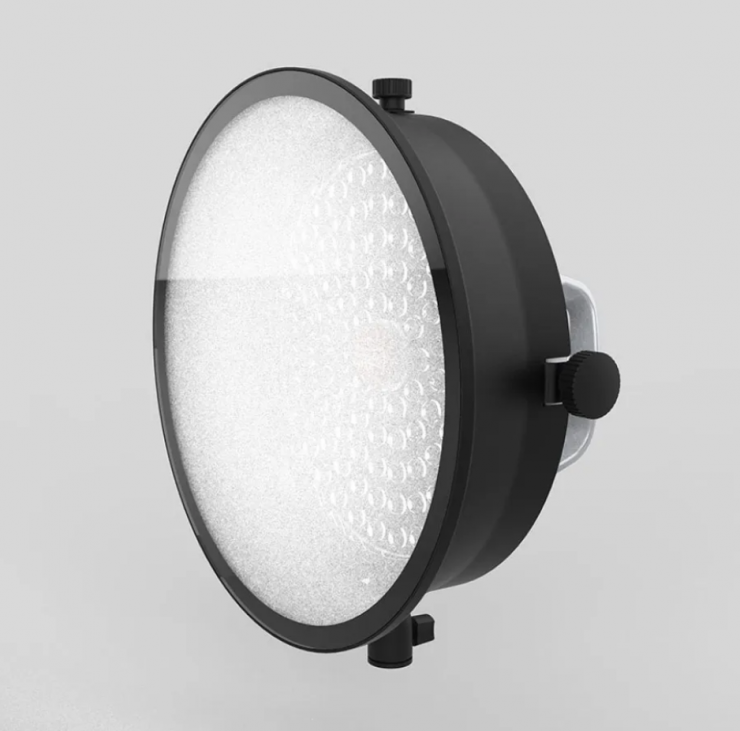
The Smartsoft Box lets you switch from a soft output to a harder light source. According to Rotolight, Smartsoft Box is the world’s first intelligent softbox. It has been designed specifically for the AEOS 2 PRO. SmartSoft Box electronically adjusts your light’s diffusion, focus, and spread without the need for gels. You can control it via the touchscreen display or by using the Rotolight app.
Rotolight Universal Speedring Adaptor
The Rotolight Universal Speedring adaptor lets you use a wide array of Bowens-mount modifiers on the Rotolight NEO and AEOS fixtures.
Final thoughts
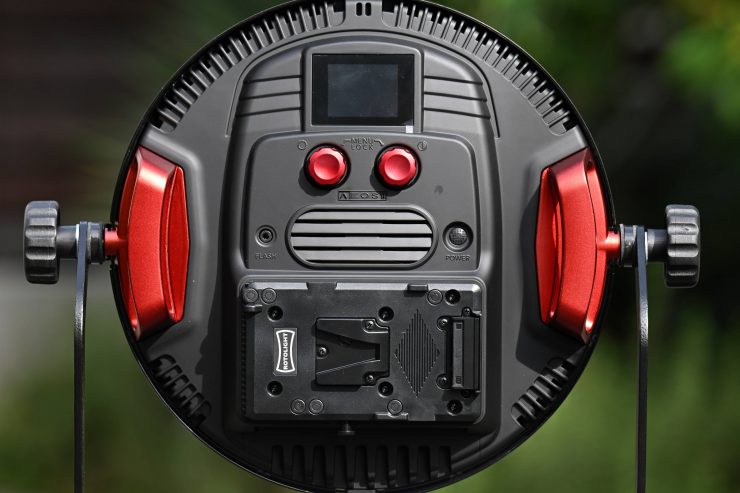
The AEOS 2 PRO offers a decent amount of output, coupled with a low power draw. The build quality is good and the light has decent color rendering scores.
Yes, the beam angle is quite tight, but that is fairly common on quite a lot of high-output 1×1 fixtures.
Given the light is probably being targeted at news crews, people doing multi-media work, and shooters who travel a lot, it’s fair to say Rotolight has tried to make a good compromise between output and power draw. The AEOS 2 PRO is quite versatile and could be used for a variety of lighting applications. To be honest there are very few if any 1×1 panel lights available that you can use for every lighting scenario. A 1×1 panel is never going to replace an HMI, but some of the high-output choices that are available can make for a good alternative.
As I already mentioned, the ability to use the light for both stills and video makes it appealing to anyone who does multi-media work. The integrated v-lock battery plate and the ability to run the light at 100% from a flight-safe battery is something that shouldn’t be overlooked.
The negatives for me are the fan noise when running the light at full power, and the inconsistency in the output depending on what CCT temperature you are running it at. Sure, you can put the light in the Constant Lux mode, but you lose too much output and I personally wouldn’t use the light in that mode.
Despite the addition of the new features and functionality, I personally didn’t feel that the AEOS 2 PRO was a big step above the AEOS 2. If you are going to make a PRO model then, at least in my opinion (and feel free to disagree with me), it should feature better build quality, have a lot more output, and be more color accurate. From my testing, it didn’t have more output, better build quality, or higher color rendering scores. To be fair to Rotolight, I do like the inclusion of +/- G/M correction and the ability to use the light with far more wireless flash transmitters. However, I personally think that the AEOS 2 PRO, feels more like a firmware-updated AEOS 2 than a whole different light. In saying that, it is a better option than the AEOS 2, considering its increased feature set and the fact that you can pre-order it on Kickstarter for $200 less than what the AEOS 2 retails for at B&H.
Despite these complaints, I still really like the AEOS 2 PRO. The low power draw and compact size and weight set it apart from other options on the market. Having a portable, lightweight, low-power draw RGBWW fixture, with the ability to be used as both an HSS flash or a constant lighting source makes the AEOS 2 PRO a very compelling option. It does, however, face very stiff competition.

